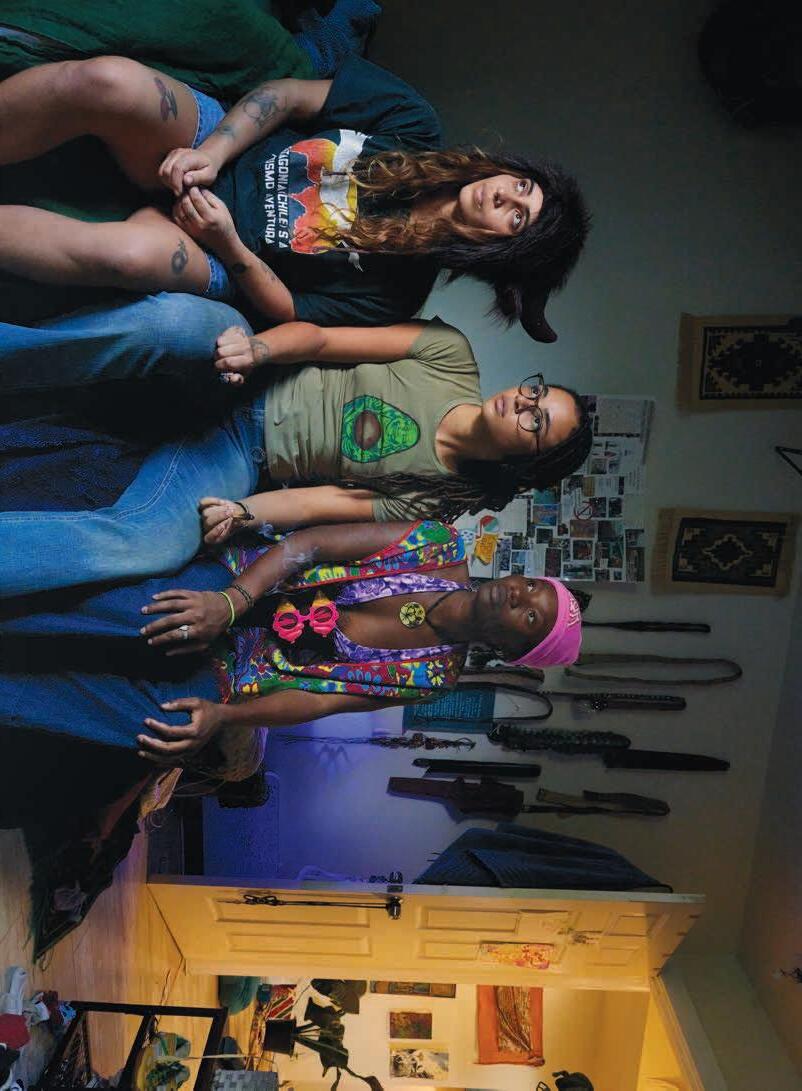
S/S 2024 FLUXHAWAII.COM NO. 46 $14.95 US $14.95 CAN COVER: 1/4 The CURRENT of HAWAI‘I ART & DESIGN: HO‘OMAU NĀ MAKA O KA ‘ĀINA, ADAPTIVE REUSE, AND KEOLA RAPOZO’S PILLARS. CULTURE: MAHJONG NIGHTS, MALA ‘ULU ‘O LELE, HAWAIIAN DRY ROCK MASONRY, AND SHARED DRIVEWAYS. SOCIETY: LAHAINA’S RECOVERY, GEN Z & HOUSING, AND KAILAPA HAWAIIAN HOMESTEADS. LIVING WELL: REFRAMING SPACE WITH THE BENNETTS, TANTALUS, AND PĀHONU POND. EXPLORE: O‘AHU WITH KĀNAKA CLIMBERS, AND WAIALUA. POETRY: KALEHUA FUNG.



















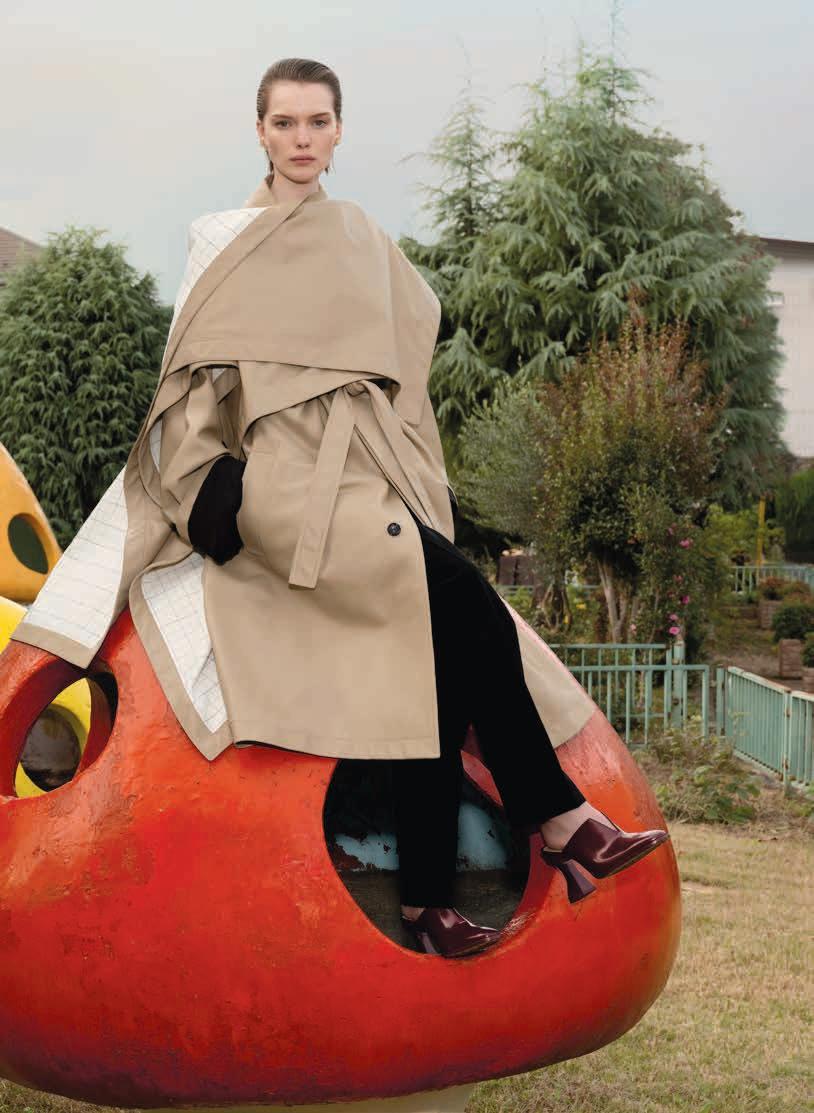


56 _ PAST MEETS PRESENT
If placelessness plagues communities in the struggle to create affordable, dignified housing, can adaptive reuse rescue our histories?
68 HOUSING GEN Z
The youngest generation in the local workforce, who struggle to find their footing on a path toward homeownership in Hawai‘i, expresses their hopes, fears, and aspirations around the unaffordable real estate market.
90 A PEOPLE DESERTED
Hawaiian Home Lands are meant to generate Native Hawaiian self-sufficiency, yet one community on Hawai‘i Island is awfully overcharged for freshwater. What went wrong?

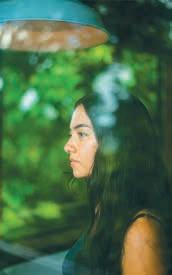
TABLE OF CONTENTS 10 _ DEPARTMENTS S/S 2024 PHILES 24 _ FILM Ho‘omau Nā Maka o ka ‘Āina 32 _ CULTURE Mana and Kalehua Caceres 38 _ COMMUNITY Shared Driveways 42 GAMES Mahjong 48 _ MAOLI Keola Rapozo A HUI HOU 192 BACKBONE OF PARADISE FEATURES
IMAGES BY _ VINCENT BERCASIO FACING PAGE, IMAGE BY _ ERICA TANIGUCHI

NO. 46 FLUXHAWAII.COM 11
110 HE LEI NO KA MALU ‘ULU O LELE
A storied description of Lahaina’s many historical modes of shelter, built and defended by the region’s maka‘āinana.
116 _ VOICES IN THE DARK
From grassroots support to coordinated efforts, Maui’s Filipino community finds it footing in the aftermath of the devastating wildfires.
124 _ THE PEOPLE VERSUS THE WEST MAUI DEVELOPER
Controversial developer Peter Martin spent decades guzzling water around Lahaina. Then came the fire.
LIVING


Kimeona Kane
Kānaka Climbers 178 _ NORTH SHORE
Waialua
ART & DESIGN
CULTURE
SOCIETY
SUSTAINABILITY
STYLE
POLITICS
12 _ FLUXHAWAII.COM _ DEPARTMENTS TABLE OF CONTENTS
SPECIAL SECTION: LAHAINA
DESIGN
152
WELL 136 _
The Bennetts
UHAU HUMU PŌHAKU
EXPLORE
CLIMBING
168 _ ROCK
S/S 2024
BY _ MARK KUSHIMI AND ELYSE BUTLER
IMAGES


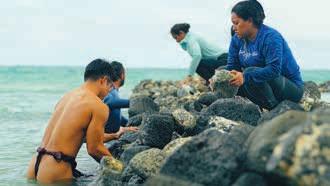


CONTENT _ VIDEO STILLS FROM IN FLUX IN FLUX TV Stay current on arts and culture with us at: FLUXHAWAII.COM @ fluxhawaii @ fluxhawaii / fluxhawaii FASHION _ KEOLA RAPOZO DRY STONE MASONRY _ KIMEONA KANE LEI MAKING _ MELEANA ESTES WEAVING _ K Ā ‘EO IZON 14 _ FLUXHAWAII.COM

FLUXHAWAII.COM
STREAMING VIDEOS, NEWSLETTERS, LOCAL GUIDES, & MORE
We’ve updated Flux Hawaii for a more dynamic viewing experience. Watch all the original episodes from our themed seasons, find ways to support local small businesses, and sign up for our weekly newsletters curated with Pacific-related reads. You can also browse past issues of the print magazine for purchase.


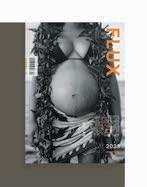


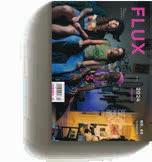
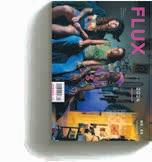



ON THE COVERS
Reflecting the dynamism of stories in every edition, our new issues are released with multi-cover runs to express the kaleidoscopic and shifting landscape of the islands. L to R: 1. Gen Z-ers share their housing situations; 2. An afternoon with the Bennetts; 3. Bad Luck Club mahjong nights at Native Books; 4. Documentary footage captured by filmmakers Joan Lander and Puhipau.
Images, L to R, by:
ka
4.
_ ONLINE CONTENT 16 _ FLUXHAWAII.COM
1. Desmond Centro
2. Michelle Mishina
3. Vincent Bercasio
Stills from Nā Maka o
‘Āina

FLUX HAWAII
_ JASON CUTINELLA PUBLISHER/CEO
_ JOE V. BOCK
PARTNER/GENERAL MANAGER, HAWAI‘I
EDITORIAL
_ MATTHEW DEKNEEF
EDITOR IN CHIEF/EDITORIAL VIDEO DIRECTOR, HAWAI‘I
_ LAUREN MCNALLY
EDITORIAL DIRECTOR
_ EUNICA ESCALANTE MANAGING EDITOR
_ N. HA‘ALILIO SOLOMON ‘ŌLELO HAWAI‘I EDITOR
_ RAE SOJOT
SENIOR EDITOR
_ TAYLOR NIIMOTO MANAGING DESIGNER
_ ELEAZAR HERRADURA
_ COBY SHIMABUKURO-SANCHEZ DESIGNERS
_ JOHN HOOK
SENIOR PHOTOGRAPHER
_ KAHŌKŪ LINDSEY-ASING HAWAIIAN CULTURAL ADVISOR
_ ANNA HARMON
_ LISA YAMADA-SON CONTRIBUTING EDITORS
_ AJA TOSCANO MAUI PRODUCER
_ KAIA STALLINGS INTERN
CONTRIBUTORS
_ SARAH BURCHARD
_ MARTHA CHENG
_ BEAU FLEMISTER
_ KALEHUA FUNG
_ N. KAMAKAOKALANI GALLAGHER
_ VIOLA GASKELL
_ MARIA KANAI
_ ANNABELLE LE JEUNE
_ D. KAUWILA MAHI
_ NICOLE NAONE
_ TIMOTHY A. SCHULER
_ KEALI‘I THOENE
IMAGES
_ VINCENT BERCASIO
_ ELYSE BUTLER
_ DAEJA FALLAS
_ MITCHELL FONG
_ JOSHUA GALINATO
_ SAVANNAH GLASGOW
_ PEKUNA HONG
_ LILA LEE
_ AUBREY KE‘ALOHI MATSUURA
_ MICHELLE MISHINA
_ SHANDELLE NAKANELUA
_ JOSIAH PATTERSON
_ CHRIS ROHRER
_ ERICA TANIGUCHI
_ NANI WELCH KELI‘IHO‘OMALU
CREATIVE SERVICES
_ GERARD ELMORE
VP FILM
_ KRISTINE PONTECHA
CLIENT SERVICES DIRECTOR
_ KAITLYN LEDZIAN
STUDIO DIRECTOR/PRODUCER
_ TAYLOR KONDO PRODUCER
_ BLAKE ABES
_ ROMEO LAPITAN
_ ERICK MELANSON
FILMMAKERS
_ JHANTE IGA
VIDEO EDITOR
_ BRIGID PITTMAN
GLOBAL DIGITAL CONTENT & COMMUNICATIONS MANAGER
_ ARRIANA VELOSO DIGITAL PRODUCTION DESIGNER
OPERATIONS
_ GARY PAYNE ACCOUNTS RECEIVABLE
_ SABRINE RIVERA OPERATIONS DIRECTOR
_ SHERI SALMON TRAFFIC MANAGER
ADVERTISING
_ ALEJANDRO MOXEY SENIOR DIRECTOR, SALES
_ FRANCINE BEPPU INTEGRATED MARKETING LEAD
_ SIMONE PEREZ ADVERTISING DIRECTOR
_ TACY BEDELL DIRECTOR OF SALES
_ RACHEL LEE ACCOUNT EXECUTIVE
_ WILL FORNI SALES COORDINATOR
GENERAL INQUIRIES: CONTACT@FLUXHAWAII.COM
©2024 NMG NETWORK. CONTENTS OF FLUX ARE PROTECTED BY COPYRIGHT AND MAY NOT BE REPRODUCED WITHOUT THE EXPRESSED WRITTEN CONSENT OF THE PUBLISHER.
FLUX ASSUMES NO LIABILITY FOR PRODUCTS OR SERVICES ADVERTISED HEREIN. ISSN 2578-2053.
18 _ FLUXHAWAII.COM PUBLISHED BY: NMG NETWORK
MASTHEAD _ S/S 2024

RoyalHawaiianCenter.com • Waikīkī • Open Daily • 808.922.2299 FROM SUN UP TO SUN DOWN, THERE’S MAGIC AROUND EVERY CORNER. Fashion.
from day to night
Dining. Culture.
I Ka Pō Me Ke Ao
Fendi | Harry Winston | Hermès | Tiffany & Co. | Jimmy Choo | Stüssy | Rimowa | Saint Laurent | Ferragamo KITH | Tory Burch | Valentino | Tim Ho Wan | Doraku Sushi | Island Vintage Wine Bar | Restaurant Suntory
P.F. Chang’s | The Cheesecake Factory | TsuruTonTan Udon | Wolfgang’s Steakhouse | Noi Thai | Partial Listing




DESMOND CENTRO is a Native Hawaiian photographer born and based in Honolulu. Raised in the suburbs of Dallas, Texas, his childhood was full of Lone Star State experiences. While his upbringing was marked by exemplary public education, five-star Texas baseball, and frequent visits to indie cinemas, he always felt a deep pull toward his island roots. His choice of attending Hawai‘i Pacific University led him to O‘ahu. As he pursued a degree in Business Marketing, his passion for photography flourished during travels across Asia. With an Olympus Mju II, he interpreted his worldview through the lens, the camera is his tool to connect with people from place to place. The spectrum and
ANNABELLE LE JEUNE’s journey into storytelling stems from her islander roots. Born and raised in a primarily hispanic Miami, surrounded by enclaves of coastal nations, and coupled with her mother’s Indonesian-Chinese background, Annabelle finds home in many different ways. As a third culture kid and global citizen, she works around the world to bridge the gap for marginalized voices to equally obtain access to resources, rights, and representation as seen in Hana Hou!, Nonprofit Quarterly, Trip Savvy, and more. She is inspired by community-led initiatives that support stewardship and look to innovative ways for places, like Hawai‘i, to connect, protect, and live in harmony with the
KAIA STALLINGS, born in Nashville, Tennessee, found her artistic home in Hawai‘i after relocating at a young age. A recent college graduate, she has quickly found her place in the creative writing scene by utilizing her degree to craft live typewritten poetry at events like Art and Flea and Kaka‘ako Night Market. Inspired by the personal narratives shared by attendees, Kaia infuses her poetry with authentic emotions and vivid imagery drawn from these interactions. Her journey into journalism began during her undergraduate years at The Sentry, a student-led newspaper production. Her reporting and writing in this issue marks Kaia’s first contribution to Flux, adding to her
KEALI‘I THOENE is a native born son of Hawai‘i who grew up mostly barefoot, slurping from the garden hose, and slipping underneath Parker Ranch’s barbed wire fences. Keali’i graduated from Kamehameha Schools Kapālama, and the University of San Francisco with a BA in Media Studies. He has written for Living, Hualālai Magazine, and Big Island Traveller Magazine. He also coauthored a 2024 report on the state of next-generation work-based learning opportunities on Hawai’i Island called “Bridging Gaps, Building Futures.” He wrote the feature exploring water issues at Kailapa, on page 90. Set in Kawaihae, his ahupua‘a neighbor to the north, the story hits close to home for him. “I was
intricacies of the human face and food are common camera bait for him. Today, Desmond collaborates with local fashion brands and publications, blending the tropical essence of island life with the vibrant realm of fashion. In his first assignment for Flux, he shot portraits of local Gen Z residents, on page 68. “It’s an intimate experience being allowed into somebody’s home, and then being able to photograph it for a magazine is a feat of vulnerability,” he says. “I am constantly challenging myself to capture images of daily or what some might consider ordinary moments in unique light and unexpected angles. Photography is all about perspective.”
waters, lands, and life they nurture. She wrote about Kānaka Climbers, her first piece for Flux, on page 168. “At first, it seemed funny that a rock climbing organization would gather climbers and trek through a trail laden with climbing opportunities only to do a clean up,” she says. “But when I stood in the middle of Kīpapa Gulch and faced a series of petroglyphs, I understood why. Hearing about the mo‘olelo of the place, its mana and the aloha that the once-upon-a-time dwellers laid out for future generations made me think, if more organizations had a model to inspire stewardship and connection like Kānaka Climbers, Hawai‘i’s ‘āina and its resources would be in a much better place.”
portfolio, which includes works featured in the denver underground, a showcase of underground culture produced by the collective FreeMusicForFreePeople. Through her writing and poetry, Kaia continues to explore intersections of memory, identity, and the human experience. She contributed writing and reporting for the Gen Z photo essay on page 68. “Being able to sit down with members of my generation and delve into how their living situations are shaped by Hawai‘i’s current housing climate was an incredible opportunity,”she says. “It was a privilege to explore the shared sentiments and varied experience of those we interviewed.”
baffled when I found out how much the residents were paying for water, but more confused after I asked around and found out that no one really seemed to know about the injustice that was happening,” he says, considering himself fortunate. “I am grateful that Flux could publish my words, but mine are not special. All Hawaiians are storytellers. This piece is just one more article added to the Kānaka mo‘olelo mosaic. There are so many talented Hawaiians out there with stories untold.”
CONTRIBUTORS _ S/S 2024 20 _ FLUXHAWAII.COM
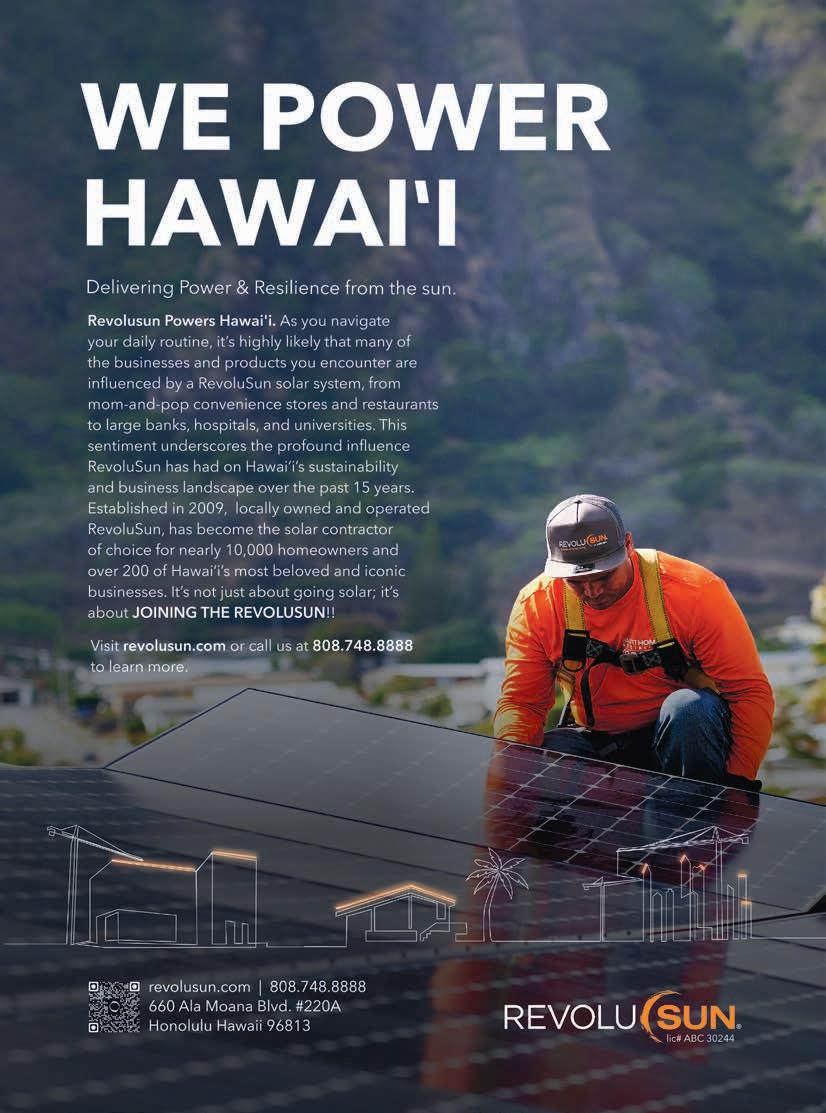
 “ Where did we get this beautiful word, this magical word, this word that imparts life
“ Where did we get this beautiful word, this magical word, this word that imparts life

FLUX PHILES 23 IMAGE BY _ VINCENT BERCASIO
called aloha? ” — Frank Kawaikapuokalani Hewett
The installation for “Ahupua‘a, Fishponds and Lo‘i,” despite a spartan title that conjures impressions of agricultural abundance, was sparsely furnished. No framed works or large sculptures decorated Koa Gallery, the arts space at Kapiʻolani Community College. In a corner, a pair of small video monitors played outtakes from the 1992 documentary which shared the exhibit’s name. Inside a dimly lit alcove, the film’s full 90-minute runtime was projected on a loop. Placed modestly at the room’s center were two desks; one held an iMac, the other a pair of binders labeled “Hoʻomana Logs/Transcripts Oʻahu.” To the unacquainted they would have seemed like footnotes to the exhibit. For those familiar with the work
Reel Resonance
FOR THE PAST THREE YEARS, FILMMAKERS JOAN LANDER AND SANCIA MIALA SHIBA NASH HAVE BEEN DIGITIZING AND CATALOGING HALF A CENTURY’S WORTH OF INVALUABLE NATIVE HAWAIIAN FOOTAGE.
KANAI VINCENT BERCASIO
of documentarians Joan Lander and Abraham “Puhipau” Ahmad Jr., however, their contents were a revelation of utility.
The binders housed a stack of transcripts two inches thick, meticulously cataloged by Lander and Puhipau as they filmed the Oʻahu segment of Ahupuaʻa, Fishponds and Loʻi (1992), their seminal Nā Maka o ka ʻĀina documentary on Hawaiian aqua and agricultural practices across the islands. The installation made the film’s unabridged transcripts and outtakes public for the first time in 30 years, showcasing more than 80 unedited hours of oral histories on traditional Kānaka knowledge, storied places, and Hawaiian history.
One scene followed Marion Kelly, an activist and ethnohistorian credited with reorienting academia’s view on Native Hawaiian history, as she and educator Charles Kupa toured Ka Papa Loʻi o Kānewai, Mānoa Valley’s last intact taro patch. In another interview, omitted from the film’s final cut, kumu hula Frank Kawaikapuokalani Hewett traced his ancestral origins to Puʻu Hawaiʻi Loa, a wahi pana, or storied place, made inaccessible by the creation of Kāneʻohe
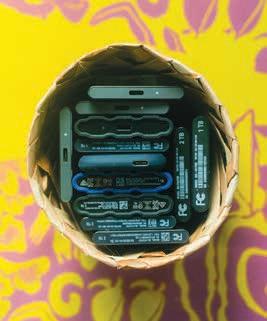
SANCIA MIALA SHIBA NASH, WHOSE EXPERIMENTAL FILMMAKING IS INFLUENCED BY ORAL HISTORIES, WAS ENLISTED TO DIGITIZE TRANSCRIPTS FROM NĀ MAKA O KA ‘AINA'S ARCHIVE OF DOCUMENTARY FOOTAGE AND TO ORGANIZE PUBLIC PROGRAMMING OPPORTUNITIES.
FLUX _ PHILES _ FLUXHAWAII.COM 24
_ FILM
TEXT BY IMAGES BY MARIA



Marine Corps Base. “Where did we get this beautiful word, this magical word, this word that imparts life called aloha?”
Hewett asks, standing in ankle-deep water with his homelands in the background. “Believe me when I say, and I truly believe this, that the Hawaiian people or Hawai‘i are truly blessed because of that.”
The installation was the culmination of a three-year collaboration between Lander and filmmaker Sancia Miala Shiba Nash, enlisted by the Native Hawaiian non-profit Puʻuhonua Society to help catalog and digitize Nā Maka o ka ʻĀina’s vast moving picture archive. Lander and Puhipau founded the inde-
25
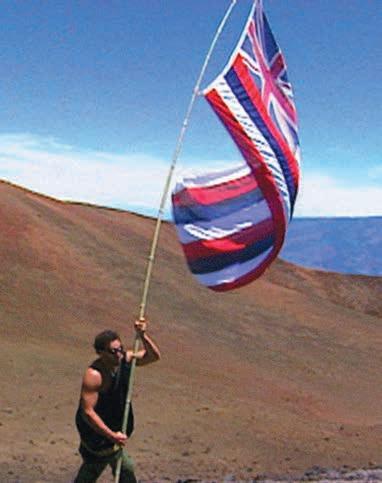
pendent video production company in 1981 after meeting in the post-production process for Victoria Keith and Jerry Rochford’s The Sand Island Story, which documented the state’s forceful eviction of a largely Native Hawaiian community on Mauiola (Sand Island). Lander was the editor; Puhipau, as one of the residents facing eviction, was asked to narrate. The pair’s serendipitous beginning was a portent of the work they would accomplish in the ensuing years.
It was the 1980s, the decade after the Second Hawaiian Renaissance, which had heralded a political and cultural

rebirth. There was a renewed focus on Native Hawaiian history and art. Political resistance called for a return to sovereignty. Lander and Puhipau turned their lens to the social movements occurring around them: evictions, land and water rights protests, and aloha ʻāina marches. It was all, according to the Hawaiian-Palestinian Puhipau, “for one purpose only, and that purpose is to speed up the process towards sovereignty.”
For more than 40 years, the duo covered traditional and contemporary Hawaiian culture, history, and politics, producing the resulting footage into
award-winning programs. By 2006, Nā Maka o ka ʻĀina had amassed over 8,000 videotapes, stored in Lander’s Kāʻū home. The recorded materials were fragile, the technology used to play them facing obsolescence. To avoid losing the archive, Lander and Puhipau began cataloging, digitizing, and archiving. They transferred most of their edited programs online. Then, in 2016, Puhipau passed away, making Lander the archive’s sole proprietor.
The next four years Lander continued alone. Yet, digitizing thousands of hours of footage proved to be a mon-
26 _ FLUXHAWAII.COM
PHILES _ FILM


27
FILM STILLS FROM MAUNA KEA TEMPLE UNDER SEIGE (2005), KAHO‘OLAWE ALOHA ‘ĀINA (1992), AND PACIFIC SOUND WAVES (1986).

umental project to undertake solo. In 2020 she began working with Puʻuhonua Society, a Native Hawaiian nonprofit who provided funding for additional equipment and manpower. Nash was enlisted to digitize the transcripts — applying precise metadata like names and locations — and to organize public programming opportunities.
Nash, who studied film and anthropology at Bard College in New York, moved back to Hawaiʻi in 2020. A family friend, kahu and musician Aaron Kamauna, took her to storied sites
across Maui upon her return, recalling the moʻolelo tied to the land. Among them was Honokahua, an ancient burial site reinterred in 1987 to make way for a Ritz-Carlton resort. Shortly after, she watched Nā Maka o ka ʻĀina’s Na Wai E Ho‘ōla I Nā Iwi—Who Will Save the Bones? (1998) about the desecration. The pivotal moment soon led to her collaboration with Lander. Their partnership was named Ho‘omau Nā Maka o ka ʻĀina, ho‘omau meaning to continue. They first tackled the more than 86 hours of footage filmed in 1989 to
FOR MORE THAN 40 YEARS, JOAN LANDER & PUHIPAU COVERED TRADITIONAL AND CONTEMPORARY HAWAIIAN CULTURE, HISTORY, AND POLITICS.
1990 that became Ahupuaʻa, Fishponds and Loʻi. “We had to go through the dozens of stories left on the cutting room floor, identifying the subjects and distributing the footage to families,” says Lander. “Puhipau and I believed that the people on the tape had as much right to the footage as we do. The most satisfying thing has been to put a copy of the tapes in the hands of the people who were on it or relatives of those who have passed.” With the permission of the families, certain tapes were made available to the public via installations
28 _ FLUXHAWAII.COM PHILES _ FILM


like the one at Koa Gallery, which featured interviews done on Oʻahu.
“It’s one of these programs that you are both absolutely honored to be part of and completely overwhelmed by the sheer amount of work that it requires,” says Emma Broderick, executive director at Pu‘uhonua Society, which also provided funding for the public programming.
The most interactive aspect of the exhibit was the iMac set up in the middle of the room, which housed the transcripts digitized by Nash along with an archive of previously unseen Oʻahu tapes. The metadata in Nash’s transcripts made the hours of footage easily searchable. One could type in “taro” and find where among the tapes it was discussed. Instantly, there Kelly would be, explaining how the sugar industry diverted water away from the taro patches. Or kalo farmer Charles Reppun showcasing the traditional irrigation methods of his Waiāhole farm. The tapes provided invaluable knowledge, made available to journalists, researchers, students, teachers, and cultural practitioners.
In a way, the program isn’t merely to create a historical archive for researchers or future documentarians. It presents a tangible link to Native Hawaiians’ past, proof of the ways in which Kānaka Maoli have fought and continue to fight for the rights of their people and land.
“I feel like many grassroots documentary filmmakers of Hawaiʻi would
agree that Nā Maka o ka ʻĀina left a vital resource for generations to come,” says Nash. “We still look to their educational programs and video archives for insight, as many of the issues they recorded still persist today.” In documenting the stories of ka pae ʻāina, the Hawaiian archipelago, Nash believes that Lander and Puhipau’s legacy played a critical role in educating the people of Hawai‘i.
Eventually, the Ahupua‘a, Fishponds and Lo‘i installation will travel to the various islands in which the documentary was filmed. The next island will be Maui, where the Maui portion of the tapes will be on display. Although the Oʻahu exhibit closed in 2024, the digitized footage and transcripts remain housed at Arts & Letters in Chinatown and, accessible by appointment, the Kualoa-Heʻeia Ecumenical Youth Project in Kāneʻohe.
“I appreciate the ho‘omau, the continuity piece that spans across generations with Nash and Joan. Not only are they able to continue the work as it exists and honor it as a source, they can evolve the work,” says Broderick. “It is beautiful to have a filmmaker working with a filmmaker, and not necessarily a filmmaker working with an archivist, as Nash brings her perspective to the project, as we can see with the exhibits.”
The project has made a mark on Nash and her experimental filmmaking, which is influenced by oral histories. The

Hawaiian proverb “i ka wā ma mua, ka wā ma hope,” meaning the future is in the past, is particularly inspiring for her work. “The stories that we record are important because they can offer solutions for the future of Hawai‘i,” she says.
There’s much more work still to be done. Lander and Nash continue their collaboration with the next set of 256 tapes from Nā Ki‘i Hana No‘eau Hawai‘i, a 30-part series on Native Hawaiian culture created for the Department of Education. Once all the tapes from Nā Maka o ka ʻĀina’s archives are digitized and cataloged, the raw materials and transcripts will be deposited at ʻUluʻulu: The Henry Kuʻualoha Giugni Moving Image Archive of Hawaiʻi, the official state archive for moving images, to ensure their future preservation.
“As I grow older, I feel such a responsibility and urgency to get the tapes out there and accessible,” Lander says, “and I’m so grateful to have the partnership of Pu‘uhonua. They’re treating my and Puhipau’s work with such respect and have seen its value.”
THE AHUPUA‘A, FISHPONDS AND LO‘I INSTALLATION WILL TRAVEL TO THE VARIOUS ISLANDS IN WHICH THE DOCUMENTARY WAS FILMED.
30 _ FLUXHAWAII.COM
PHILES _ FILM



(808) 593-1864 synlawnhawaii com always green lower water bills . zero maintenance
1 The Native American Graves Protection and Repatriation Act became law on November 16, 1990. NAGPRA requires federal agencies and institutions that receive federal funding to return Native American cultural items to lineal descendants and culturally affiliated American Indian tribes, Alaska Native villages, and Native Hawaiian organizations. The act also establishes procedures for said items’ inadvertent discovery on federal or tribal lands.
2 Ayau was the first manager of the Burial Sites Program at the State of Hawai‘i Historic Preservation Division that formally established the island burial councils, and was the principal drafter of the State laws that remain in use to this day.
3 Two hui repatriated a total of 55 iwi kūpuna, 30 lauoho (hair of the head), and seven moepū from Übersee-Museum Bremen, Stuttgart State Museum of Natural History, Albert Ludwig University of Freiburg, and others.
‘Ike in Iwi Kūpuna
IN THE RELENTLESS MARCH OF URBAN EXPANSION, MANA AND KALEHUA CACERES ARE STEADFAST IN THEIR COMMITMENT TO PROTECTING AND DEFENDING THE BONES OF HAWAI‘I.
TEXT AND INTERVIEW BY IMAGES BY
In 1987, despite the Native Hawaiian community’s assertions that the site was a burial ground, construction commenced anyway on the Ritz-Carlton Hotel at Honokahua, Maui. The subsequent desecration: more than 1,100 human remains. This horrific event prompted Pualani Kanakaʻole Kanahele and Edward Lavon Huihui Kanahele to found Hui Mālama I Nā Kūpuna ‘O Hawai‘i Nei, a nonprofit organization dedicated to protecting iwi kūpuna, the ancestral bones of Hawaiian natives. Its members went on to repatriate and rebury over 6,000 iwi kūpuna, moepū (burial objects), and mea kapu (sacred objects), and in collaboration with other Indigenous communities, established the federal laws 1 used today to protect our ancestors. Edward Halealoha Ayau2, an original member and former executive director, established the successor organization Hui Iwi Kuamoʻo in 2015.
In April 2023, I had the privilege of joining Hui Iwi Kuamo‘o on a mission to reclaim our ancestors’ stolen bones from three German museums 3. Through Kalehua, I learned that tears serve as a powerful testament to our shared humanity, while Mana taught me that
NICOLE NAONE LILA LEE
laughter holds the key to building resilience. It was their balanced understanding of both sorrow and joy that made clear why our kūpuna entrusted them with such important work.
As haumāna of Ayau and alakaʻi with Hui Iwi Kuamoʻo, Mana and Kalehua Caceres are the latest fruits of this geneology of ʻike. Following a couple talk story sessions with the Cacereses4, Flux learned about the latest updates, challenges , and best practices surrounding Hawaiian burial grounds and development, a critical topic to all residents of Hawai‘i.
defining ancestral remains
Mana Caceres: Everybody in your parents’ generation was considered your mākua, your parent. Everybody in the generation before that was your kūpuna. So, for us, the very definition of human remains is iwi kūpuna 5 , it literally is the bones of my grandparents. Thankfully, we’re living in an age now where we have revitalization of the Hawaiian language. We’re getting whole generations of our ʻōpio, our youth, who are young adults now who have grown up in our language, who have rewired their brains to think like our kūpuna.
32
FLUX _ PHILES _ CULTURE _ FLUXHAWAII.COM

common misconceptions
MC: One of the things we battle, as far as the construction industry itself, is that there’s a stigma that the construction project will be terminated. So, we have a lot of open dialogue on projects that we are involved in and it’s basically trying to teach everybody what they’re missing. We’ve had instances where iwi is found on construction sites where the people are trying to hide it because if they find iwi they think they’re going to get fired or something. So, it’s not like they’re trying to hide it to be ‘ino (immoral, disrespectful).
They’ll try and dig fast sometimes so that the archeologists and the other monito r 6 won’t be able to see if iwi is present. The worst case scenario is they’re digging with no monitor, or by the time a kūpuna is found, they don’t know where it originated. Some of these construction sites, by the time we’re contacted there are huge piles of dirt that they’ve had on site for months, which then requires an investigation that is going to take months because now they have to find out where on-site that dirt came from. We’ve seen cases where the state has required half a dozen to a dozen archeologists sitting there with screens, screening truckloads of dirt, trying to find all the kūpuna because nobody was there when they were digging.
when iwi are found
MC: If iwi kūpuna are found, the entire job doesn’t get shut down. When bones are found and the process is stuck to, you’re looking at something as short and as simple as a 24-hour shut down of a 20 foot area7. Finding a kūpuna as carefully as you potentially can, pays off in the long run, not only for the kūpuna because it’s safer and it’s less impactful, but for the developer also. The safer you go, the safer it is. The safer and more careful you do the excavation, obviously the kūpuna is going to be safe. Sometimes we are able to find kūpuna before the machines even touch them. If we know what kūpuna
was buried, like the material or the layer of dirt that they’re associated with in that area, once we reach that depth or we see that type of dirt, we usually go in and we check with our literal hands. And if that’s the case, then you can find kūpuna before anything touches the kūpuna.
a relationship-based methodology
Kalehua Caceres: The way we approach anything ‘ohana-related, our business, or any endeavors that we are partaking in, is that we use the ceremonial protocols for everything. It is super important for us to recognize people’s kūlana (rank or title) and kuleana.
For us, we know it’s about relationships. That is our value system. As Hawaiians, we’re trying to accept everybody at their value and treat them respectfully. Because when we do, we model the way we want our ancestors to be treated. And we want those we work with to know that if we show them respect, they can show our ancestors respect.
We want people to know that they’re more than just a company to us. Even if we don’t agree sometimes, we recognize they’re real people doing real jobs. Maybe they struggle like us, maybe they don’t. But if we want a better Hawai‘i, not just for kūpuna, but for all of us, that’s what it’s going to take: changing people’s mindsets. And if we get to be at the table in any capacity, that’s what we always do. For me, that’s why Hale always says that you got to bring some ‘ike (accurate knowledge) to the table. Which is different than manaʻo (thought, opinion) or maopopo (understanding). If you can bring ‘ike to the table, at least that’s a starting place, right?
interpretation of law
MC: When you read the rules, it’s quite clear. When there’s a find of iwi kūpuna, you’re supposed to look at it from a lens of, “We’re preserving the kūpuna in place.” It’s supposed to be preserved in place until you absolutely have proven that it can’t be done. If we had people in positions of authority at the state level that’s in
A DEVELPOMENT IN PROGRESS AT WARD VILLAGE, KAKA‘AKO. THE HALA TREE HERE MARKS THE PRESENCE OF IWI KŪPUNA THAT WERE PROTECTED FROM DISTURBANCE BY THE CACERES FAMILY.
4 They also operate ‘Ohana Kūpono Consulting, a family owned cultural consultation firm that specializes in providing highly qualified cultural monitors and cultural monitor training.
5 Hawai‘i state law defines “inadvertently discovered remains" as remains that are unexpectedly exposed or disturbed in a place not known to be a place of burial. “Remains” being all or part of a dead human body or corpse, exclusive of ashes, cremated remains, or waste.
6 Safeguarding iwi kūpuna hinges greatly on the quality of the archaeological reports prepared during the planning stages of any development. If a permitting agency determines a project may affect burial sites, a “qualified archaeologist,” who must have a graduate degree in the field or related area and years of experience, conducts an archaeological inventory survey. When done properly, they are an excellent tool to prevent the disturbance of iwi kūpuna by construction.
7 Reporting a burial site disturbance is required by law, according to DLNR’s website, and severe penalties could result when SHPD is not notified of such disturbance.
34 _ FLUXHAWAII.COM _ CULTURE PHILES

charge of monitoring the State Historic Preservation Division 8 or Department of Land and Natural Resources, and apply the rules as they were intended to be applied 9, kūpuna would be safer tomorrow. It’s as quick as that. It’s as easy as just having somebody there that’s looking at it from an angle of, “OK, let’s protect kūpuna today.” Not “let’s protect the developer,” not “let’s protect the building.”
KC: We’ve been in burial council meetings and they’ll be like, “In the spirit of the law…,” and Hale will say, “No, that is not the spirit of the law. I wrote it. I can tell you what it meant.”
relocating kūpuna
KC: Sometimes that’s the only alternative that we have to keep them safe. There are
times when we agreed or we advocated for them to be moved from one place to the other, but we make those decisions knowing the gravity of it and taking on the responsibility. If we cannot get a developer to agree to ways to keep the kūpuna safe, then the safest thing is to move them to another location that’s safer. They’re under all the roads. They’re under all the buildings. Chances are those are the ones you never find. They’re the safest ones right now. So you have to weigh the risks and the benefits. And for us, we know the risk, so we just pule (pray). We let the kūpuna know every step of the way.
MC: This is Hawaiʻi. Everywhere you go, you’re going to have kūpuna. Is it OK to leave my grandpa’s iwi under a sewage

line that might break? Is it OK to leave my grandpa’s iwi under a road? They were there before the road, now there’s a road. Is it more Hawaiʻi, more Kanaka, to dig them out because the road is there? Or leave them alone where they were purposely planted? Those kinds of questions are a little bit easier if you’re looking at it from the lens of, “That’s my grandpa’s iwi.”
This interview has been edited for length and clarity from two conversations.
8 According to the DLNR website, SHPD is comprised of three branches: Architecture, Archaeology, and History and Culture. Together they collectively strive to preserve and protect Hawaiʻi’s historic identity.
9 A 2021 op-ed by Kēhaunani Abad and Edward Halealoha Ayau in Ka Wai Ola contends that for the past 25 years SHPD has chronically failed in this regard, mentioning its inability “to produce consistently rigorous, timely reviews of reports required of those undertaking projects, resulting in projects going forward that should have paused for more careful study and community involvement.”
AS HAUMĀNA OF AYAU AND ALAKA‘I WITH HUI IWI KUAMO‘O, MANA & KALEHUA CACERES ARE THE LATEST FRUITS OF THIS GENEAOLOGY OF ‘IKE.
36 _ FLUXHAWAII.COM _ CULTURE PHILES
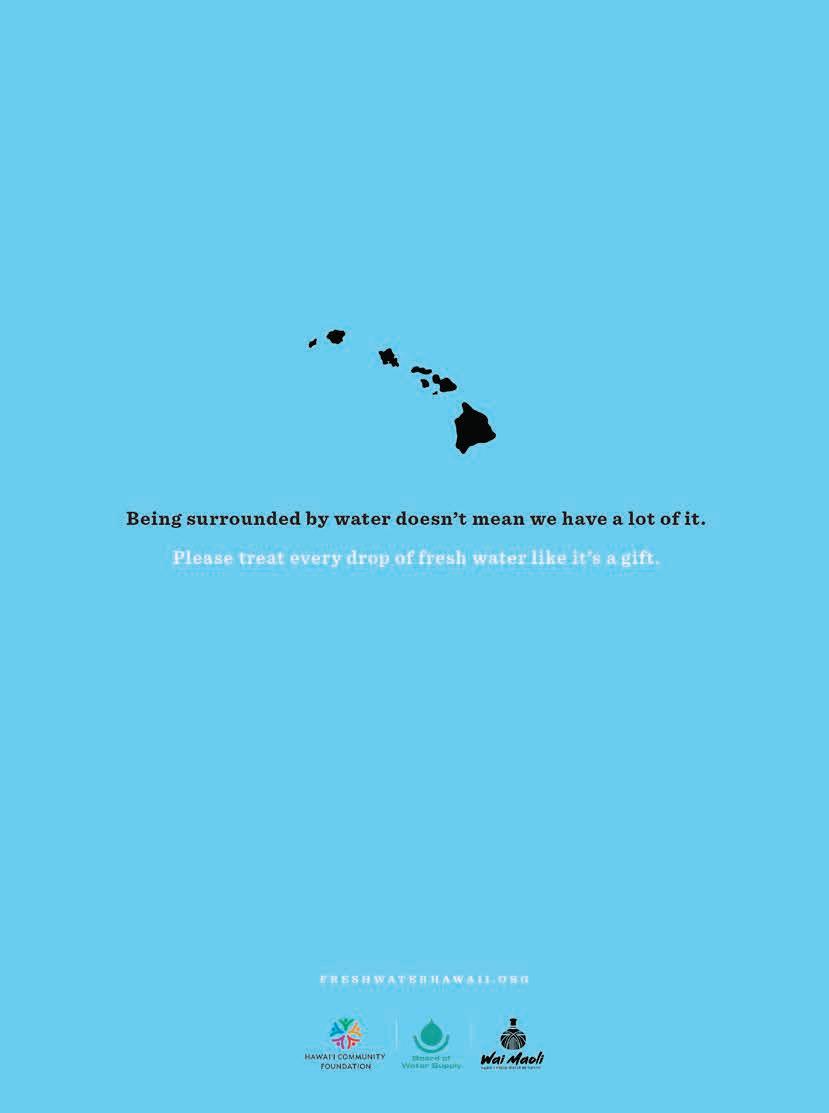
On Shared Driveways
FOR RESIDENTS, THERE ARE DAILY SPLENDORS, SOMETIMES SPATS, AND A BURGEONING SENSE OF COMMUNITY THAT NATURALLY BLOSSOMS WHERE PATHS CONVERGE.
TEXT BY ART BY ANNA HARMON MITCHELL FONG
When I moved to Salt Lake City in 2019, I was lonely. Fresh off a master’s degree, I had followed my spouse there for his academic pursuits. We rented a one-bedroom apartment in a six-unit complex centered around a courtyard that had been built in the flurry of postWWII housing. Out our front door and kitchen window was a unit with an identical floor plan in reverse.
I had a remote job, so I spent a lot of time at home, during which I got to know the neighbor across the way. Her cats bathed in the sun on the low wall fronting the courtyard while I sat on my steps. She told me stories of the restaurant she had owned around the corner, her career aspirations. I looked on as she fell in love. Eventually, we also got to know the quiet, brilliant woman who lived in the back unit and walked by with her bike every day. We spent sun-soaked conversations talking about studies, the weather, the zucchini plants we were growing, which she watered when we were away. We became a small community. Then, one by one, we all moved out.
Upon moving back to Hawai‘i, my spouse and I found a rental with a surprisingly similar setup: a two-bed-
room house in Pālolo Valley oriented around a single driveway shared by nine residential dwellings. Across this drive-way is a nearly identical house to ours, with the same small yard and a plumeria tree.
Similarly to the Salt Lake City move, I arrived here lonely — far from my parents and siblings’ families and spending most of my time at home with my one-year-old daughter. Also similarly, living across the way was a couple quick to welcome us. The husband spent afternoons in his covered driveway, listening to country music one day, Hawaiian the next. My daughter learned that if she brought him a flower from our tree, he would say, “Just wait!” and go inside, returning with a sweet treat for her. Slowly, he became one of our quotidian joys, a burst of conversation after a stressful tantrum, a bright moment in isolated days. His wife waved to us as she fed the birds when she got home from work and gave our daughter gifts on her birthday and holidays. My child, in turn, would stand at our open front door, waving and yelling “hi” to them as soon as she learned the word. One day when I was chatting with my neighbor, he shared that he had wanted to buy the place because
_ FLUXHAWAII.COM 38
FLUX _ PHILES _ COMMUNITY





it reminded him of his childhood home, a strikingly similar house among eight identical houses on a pīkake farm in Kaimukī. He fondly recounted spending afternoons roaming the area with the neighbor boys.
We also have more neighbors, of course. Along our shared driveway, there’s the man we speculate is a mechanic who always waves when he walks up the driveway from work or with his kids, who will play basketball with the entertaining, roaming toddlers of the woman residing next door to him; the lady who lives catty-corner and owns a café down the street; an enterprising, middle-aged duo who have lived the longest on our side of the driveway and bring us bananas from their yard; and our fence-sharing neighbors, who are wary of strangers and have two dogs they adore. Other faces blur, or are soon replaced by new residents.
Our home in Pālolo was built in 1927, according to Redfin. I imagine it was housing for people moving out of plantations into the city. The shared driveway setup is common, if not dominant, in the neighborhood. I have friends who live at the back of another such four-house, eight-residence setup a block away, and years ago, I briefly lived three streets away with a friend in a small house behind her parents’ house, behind which were two more houses where her aunty and grandma lived.
The orientation around a shared driveway creates a sense of intimacy, guaran-
teeing a limited number of neighbors you’ll see more frequently than those along a busy street like 10th Avenue, which we also abutt. You can’t help but recognize everyone who lives there and learn some of their quirks. It requires those who reside deeper to pass everyone on their way out to walk their dogs or to head to work, and those at the front to become a sort of sentry. Living along a shared driveway is a blessing, a curse, and a commitment.
“Cluster developments group dwellings together in order to make efficient use of infrastructure, provide common areas that foster unity, and preserve the natural landscape and open space,” contends a recent guidebook on planned development housing from the City and County of Honolulu. A compelling association it makes is with the kauhale concept, which a 2020 Puu Opae Homestead Settlement Plan prepared for Department of Hawaiian Home Lands identifies as a “cultural model of housing consisting of tiny home clusters and communal areas for cooking, farming, and gathering.” The primary benefits of kauhale, according to this plan, are contiguous open spaces that help conserve wildlife habitats and soil quality, reduced initial investment in roads and infrastructure and long-term maintenance costs, and proximity to neighbors, which means beneficiaries are more likely to coalesce as a community. (The concept is also reflected in the state’s Kauhale Initiative, a housing proposi-

tion for the islands’ homeless, inspired by community-based efforts like Puʻuhonua O Wai‘anae and Hui Mahiai ‘Āina.)
Of course, there is a legal responsibility of shared resources. Where we live, the mauka side of the driveway has a single, tight-fisted owner. On the makai side, each house is individually owned. When the time came to re-pave the shared driveway, our landlord refused. Just as community can blossom in these setups, grudges can build and suspicions can fester.
Yet, as a renter in Honolulu searching for shelter in an era of individualistic homeownership as a competitive investment, I fantasize about how this sort of housing lends itself to being more affordable and communal. Sure, there’s the dream of the home where you can’t hear or see anything by the waves and you aren’t bothered by others, but shared resources, whether a driveway, a courtyard, or farmland, could also make housing more accessible and manageable while encouraging a lifestyle of collaboration and communication. Shared property can, under a cooperative ownership model, even build resilient, independent communities. At the least, it can provide people who are often at home, from the elderly to the new parents, a sense of not being so alone. Life oriented around shared spaces cannot help but change as lives change. The splendor may fade, the familiarity wanes as people come and go. Or, perhaps, it can grow.
PHILES _ COMMUNITY 41
42 Fresh Faces, Classic Tiles
AT A MONTHLY MAHJONG GATHERING, A NEW GENERATION OF PLAYERS FINDS COMMUNITY THROUGH THE CENTURIES-OLD GAME.
TEXT BY IMAGES BY MARTHA CHENG VINCENT BERCASIO

On a recent Tuesday evening, as I drove to Arts & Letters Nu‘uanu in Chinatown, I told my mom over the phone that I was going to play mahjong. There was a pause on the line.
“What?” she asked.
“Mahjong!” I said.
“Why?”
“Why not?”
She didn’t ask any more questions. Of all the activities that she hopes to hear I’m doing when I call her — studying investment strategies, cooking dinner for a prospective husband, reading Eleanor Roosevelt’s biography — mahjong has likely never crossed her mind.
I am slightly worried myself, partly because I’ve never played, but also because of the mahjong event’s name: Bad Luck Club. I am my parents’ daughter and I may have internalized some of their superstitions. The name, says Cassie Louie, co-founder of the monthly gathering, is in some ways a pushback against the philosophy in many Asian families where “everything has to be prosperous and fortuitous and good fortune and all the good things. But this is a space to just mess up. It’s fine.” She continues, “we’re playing [mahjong] probably not as perfectly as our ancestors would have loved it, but it’s OK. We play
FLUX _ PHILES
_ GAMES _ FLUXHAWAII.COM


it kind of shitty, but this space is safe for everyone to play in their own way.”
Inside Arts & Letters’ long and narrow space, with Cantonese pop from the ’80s and ’90s playing, Louie arranges a table laden with snacks and takeout from Mei Sum, the dim sum restaurant next door. Six square tables, each for four players, have been laid out, with the beginner tables in the front, the more experienced towards the back. As the novices, including me, take our seats hesitantly, people in the back are already shuffling their tiles, and the room fills with the soft clicking of the pieces against each other.
Usually, about 40 people turn out. Its organizers never expected this word-ofmouth event to be this popular. Louie says it all started on New Year’s Eve, when her friend and former co-worker Dane Nakama, came to her house and they began to play with her grandmother, an avid player — Louie drops her grandmother off at friends’ homes in Chinatown for weekly mahjong dates, where Louie guesses her grandmother plays about 200 games from 9 to 5 p.m. “I’ve always wanted to learn, but I couldn’t because my grandma can only speak Cantonese, and my Cantonese is so broken.” Nakama was able to explain the rules in English and “I was finally able to bridge the language and understand how to play.”
In March, inspired by the massive mahjong parties in LA hosted by the
Mahjong Mistresses, boasting guest lists hundreds of people long, Louie and Nakama launched their own gathering at Fishcake, the dual interior design store and art school where they both worked. But they quickly outgrew the space and moved to Arts & Letters in October. From the looks of it, they’ll soon outgrow this venue, too.
Louie thinks that coming out of the pandemic, “people don’t necessarily want to go out drinking or to restaurants, and this was an event where people could gather and socialize without spending a lot of money.” She’s been surprised at the turnout, but has found many people share similar stories as hers, of watching their families play but never learning themselves. For many, playing mahjong is “reconnecting with some part of their past,” she says.
Some, like Laura Zen, have been playing since they were young (in her case, since she was 10 years old). “We played more as my grandparents got older, to test their memory. It brought the family together,” she says. In addition to attending Bad Luck Club events, she plays every week at home, having introduced her friends to the game. “When you ask them do you want to play mahjong, they’re like, isn’t that for old people? Then you get them playing and you get them addicted.” But it’s more than the game itself. “I see my friends a lot more often, we’re not on

our phones, we’re not distracted. I have a lot of fun because we’re just laughing and talking, it’s very intimate.”
She plays with a mahjong set that she guesses is 50 years old, its resin tinged yellow with age. When she first started coming to Bad Luck Club, “it was shocking because every family we realize plays a little differently.” Mahjong, it turns out, like language, has many dialects, with variances among families and countries. Players in Singapore, for instance, play with different rules than those in Taiwan or the Philippines. Joy Sanchez, who organizes the events with Louie, plans on bringing her mahjong set to the Philippines and to play with family.
Others at Bad Luck Club have no familial or cultural connection to mahjong. They are propelled by a simple curiosity for the game — and, I hear a few times, inspiration from the pivotal mahjong scene in the movie Crazy Rich Asians. The most common refrain I hear among those who have not inherited the culture is that they played once and then immediately bought a set. And once you have a set, you need three more people to play, and so it spreads — to the Servco lunchroom where one attendee works, to an oil tanker where another spends 45 days at sea. To play at Bad Luck Club is to witness the virality of a physical game, its popularity measured in the people in front of me, the shouts of “pon” and “chi” and “mahjong”
44 _ FLUXHAWAII.COM _ GAMES PHILES


as matches and sequences are made and games won, followed by the clacking of tiles being reset.
I don’t think it’s a coincidence that Bad Luck Club and Mahjong Mistresses were started by creatives. More than card games, mahjong is such a tactile and visual game, each tile smooth and cool and pleasant to hold, and many sets striped like layered jello, in hues of jade green or lavender or a Tiffany’s-esque blue (for a real Tiffany’s blue, a Tiffany & Co. mahjong set is available for $15,000).
It’s these tactile qualities that draw me into mahjong, as someone in the middle
of the mahjong exposure scale — never having played it or even seen any of my family members play, but feeling the pull of my cultural heritage. And what keeps me here (and seeking my own mahjong set) is much the same as others in the room: a physical camaraderie that feels increasingly elusive in the world, and the game itself, wherein I can imagine infinite possibilities, of strategy, of joy, of luck, both good and bad. For how are you to ever recognize the good if you never know its counterpart?
“We’re playing mahjong not as perfectly as our ancestors would have, but it’s OK. ”
46 _ FLUXHAWAII.COM PHILES
PREVIOUS PAGES, BAD LUCK CLUB CO-ORGANIZERS CASSIE LOUIE AND JOY SANCHEZ
_ joy sanchez _ GAMES

THIS STORY WAS MADE IN PARTNERSHIP WITH
KĪNĀ‘OLE FOUNDATION FOR FLUX’S HAWAIIAN-LANGUAGE
REPORTING SERIES FEATURING ARTICLES PRODUCED ALL IN ‘ŌLELO HAWAI‘I.
TO READ THIS STORY IN
ENGLISH: FLUXHAWAII.COM/ SECTION/OLELO-HAWAII
Pāpale Lau Moʻolelo
NUI NĀ ‘ANO NO‘EAU A KEOLA I HO‘OPA‘A AKU, ‘O KA LOLE ‘OE, ‘O KA PĀPALE ‘OE, ‘O KA MĀKINI-IKI ‘OE, ‘O KA MĀLAMA LO‘I ‘OE.
KĀKAU ‘IA E
PA‘I KI‘I ‘IA E
Ma nā noʻeau like ʻole o ka Hawaiʻi ulana maiau ʻia ke kūʻauhau, ke kuleana, ka moʻolelo, a pēia pū ke kūlana i ka moena pāwehe hoʻokahi. Eia naʻe, ʻokoʻa ka ʻaʻala a ka lei maile lau liʻi o Koʻiahi i lei wili ʻia a ʻokoʻa pū ke kāʻeʻaʻeʻa pulu ʻole a ka heʻe nalu ma Kalehuawehe. A he nīnau wāhi pūniu ka hoʻopuka ʻana aku: Pehea lā hoʻi kākou e mau ai ka ʻike kūpuna? No Keola Nakaʻakahi Rapozo, ʻo ka hana noʻeau kekahi ala āna i pane aku ai i ia nīnau ma ka pono uhai kūpuna.
Nui nā ʻano noʻeau a Keola i hoʻopaʻa aku, ʻo ka lole ʻoe, ʻo ka pāpale ʻoe, ʻo ka mākini-iki ʻoe, ʻo ka mālama loʻi ʻoe, a he nui nā mea ma waho ʻo ia mau mea a ʻehā. He mea koʻikoʻi iā ia ka ʻī ʻana aku i mua o ka lehulehu na ka poʻe Kahaluʻu, Oʻahu i hoʻomaka i ka hoʻolei ʻana i nā mākini-iki ma nā aniani kilohi kaʻa i ke kekeke 1970. ʻIke ʻia kona hoʻohanohano i kona kulāiwi ʻo Kahaluʻu, Oʻahu eā? No kēia kui lei a Kākuhihewa, ʻo Fitted kekahi wahi e kui ai nā ʻilima kūpuna, ʻo ia hoʻi nā noʻeau a kona kūpuna ponoʻī, me nā ʻilima ʻōpiopio, ʻo ia hoʻi kona kahu hānai, i kekahi lei noʻeau milimili.
No Keola ʻo ka hana noʻeau kekahi ilina a kona mau kūpuna ponoʻī a me kona kahu hānai. He like kēia me kekahi moʻolelo Hawaiʻi e like me Kahinihiniʻula, Kalapana, me Kawelo. Ia wā a ia mau keiki ʻeu i māʻona i ka ʻono ʻo ka ʻike mai kō lākou mau kūpuna ponoʻī, lawe aku lākou i mau
D. KAUWILA MAHI PEKUNA HONG
kahu hānai e mau aku ai ke aʻo e pono ke ola. Pēlā kā Keola ma ʻOkana, Kahaluʻu, Oʻahu: aʻo ʻia nā noʻeau e like nō me ka hoʻomākaukau ʻana i mākini-iki ma lalo ʻo kona mākua a laila luʻu hohonu ʻo ia i nā moʻolelo Hawaiʻi ma ke kula paikini ma Windward CC, a lawe aku ʻo ia i kahu hānai e like me nā pāleoleo kaulana ʻo Maleka. Ma kekahi ʻano, ia wā ʻaʻahu kekahi i nā lei noʻeau a Fitted mā, ʻo ia nō ʻoe ʻo ka ʻiwa kīkaha i nā pali koʻolau e ʻaʻahu ana aku i ka moʻolelo Hawaiʻi.
ʻO wai a no hea mai ʻoe? ʻO au ʻo Keola Nakaʻahiki Rapozo. No Koʻolaupoko, ma ʻOkana. Kekahi alanui liʻiliʻi ma kahi ʻo ʻOkana Pl. a me ʻOkana Rd. e huli ai, i luna lilo, i ka wēkiu. Ma lalo ʻo ke kumulāʻau painaluhe, ʻo ia ka ʻōkuhi. He keikikāne Kahaluʻu nō au.
He aha kou moʻokūʻauhau hana noʻeau?
Hoʻina iā Kahaluʻu, nā mākua oʻu, i ka wā kamaiki, hana noʻeau mākou i nā mea Hawaiʻi, nā mea i hiki ai ke lawe aku i nā fea lima hana.
I ia manawa, koʻikoʻi nō ka hula i koʻu kaikuahine a me koʻu makuahine, no laila he maʻalahi ka hoʻokāʻoi. ʻOiai lōʻihi ka lauoho o oʻu mau mākuahine-ʻanakē hana mākou i mau ʻako lauoho a i mau lāʻau lomi kekahi. I koʻu wā kamaiki ʻo kō mākou kuleana ka hoʻomaʻemaʻe hua makani, ʻokiʻoki i nā lālā kuawa i mau lāʻau lomi, ke hoʻōne
48
FLUX _ PHILES _ MAOLI _ FLUXHAWAII.COM

ʻana aku i ka milo a me ke koa. Kālai aku koʻu makua kāne i kekahi pola nona ke kahua, a he ʻōmiomio ke nānā aku. He manomano nā ʻano mea a mākou i hana aku ai. Ma hope pono, halihali mākou i ia mea I nā fea lima hana me nā kumu paina iki e kaulaʻi aku ai. Ma nā makahiki ’80, ua hana mākini nō a nani ke kaulana, ʻo ia nō ʻoe ʻo ka paʻi nui! No laila hoʻomaka mākou e hana i mau mākini a ʻike ʻia nā mākini e kaulaʻi ʻia ʻana ma nā aniani. ʻAʻole au ʻike leʻa inā ʻo mākou ka poʻe mua i hana pēlā no ka hala ʻana I nā mākua a ʻelua lāua oʻu, eia naʻe ua kaulana aku ma waena ʻo nā makahiki 80. Me mauʻu ʻuki(ʻuki) a me ka pāʻā pāma i hana ʻia. I ia wā ʻaʻole au i ʻike i ka waiwai a i ʻole i ka lilo ʻana paha ʻo kēia noʻeau i kahua paʻa noʻu, akā i kēia manawa he 30 makahiki ma ka nohona haku mea noʻeau, he ʻōkuhi maʻalahi kēlā lama mau, a pēlā nō i ia wā.
Pehea lā hoʻi ʻoe e mau ai kēlā lama me ia mau makahiki āu ma lalo ʻo kau kāʻai ma ka nohona hana noeʻau? Na ka mākua i alakaʻi iā ʻoe?
Na oʻu mau mākua, māmā me pāpā. He hoihoi loa ʻo ia, he ʻeleu, he lehua holoholo. Ma kēlā ʻaoʻao ʻo ka mokupuni nei, ma kō mākou huʻa o Kahaluʻu, ʻo koʻu makua kāne kekahi ʻo ka heke ʻiuʻiu. Nīnīnau mau nā kānaka iā ia I kākoʻo. Ma Kaʻalaea kahi a mākou I noho ai, noho nō mākou ma kahi ʻo ke kapa kai a he moku kō mākou. Sela moku mākou I kēlā me kēia lā, a he ola lako a paʻa ʻo ka heʻe māloʻo a me ka iʻa ma ka pahu hau. He mau ka hoʻomaʻemaʻe me ka unaunahi. He naʻauao ia no kō mākou ola, ʻaʻohe wahi kamaʻāina i nā ola ʻē aʻe. He waiwai mākou i ka nohona ma kahi ʻo ke kahakai, he lako i ka ʻai. ʻAʻohe oʻu ʻike he puhikole a lako ʻole mākou-manaʻo au i loko ʻo koʻu naʻau he lako nō. ʻO kāna noʻeau ma kona mau hana he paepae ia [no koʻu hana noʻeau] - pēlā hoʻi, ma ka noʻonoʻo ʻana I ka wā ma mua, he ʻike leʻa koʻu ma laila hoʻi ka waiwai, no laila nō, ʻaʻole au i ʻike [i ia wā] e hoe hewa ʻia ana au. I koʻu wā kamaiki he ʻiʻini kaʻu e hana i mau noʻeau, a ma koʻu ulana ʻana I kēia mau mea, o ke mele ka lehua, a lohea mau iā Bob Marley a me The Smiths a me kekahi mau mele hoihoi ma nā makahiki 80- a
laila kuʻi ka pāleoleo iaʻu. Manaʻo au, ‘Eia iho, ʻO ke ola ma lalo ʻo ka pāleoleo he no ka hoʻopaʻa moʻolelo ʻana.’ He nui hewahewa nā haʻawina a me ka ʻike i aʻo ʻia mai ka pāleoleo mai ʻo ia wā a ʻo ia ihola ka paepae kapu ʻo koʻu ola, pēla au e pili mau I ka lāhui. ʻO nā puke [ma koʻu waihona] he paepae e hoʻopili aku ai i oʻu mau mākua, ka ʻikena waiwai ma loko he ala ia e pili paʻa i oʻu mau kūpuna. I kekahi lā, e lilo kō kākou hana i mau ʻike ma ka waihona ʻo ia nō ʻoe ʻo ka makila lei, ʻo ia ka pahu hopu nui.
No hea a ʻo wai mai nā kumu āu I uhai mau ai ma kēia ala āu e mākaʻikaʻi nei, a pili paʻa iā Fitted?
He nīnau maikaʻi nō kēlā, ma ke alahula ʻo koʻu ola ma luna aʻe ʻo ke kauna ka nui ʻo nā kānaka oʻu i makemake e mahalo aku ai. I ka wā kamaiki, ʻo Makua John, me Makua Pau mā. Kēlā manawa ma ka nohona i Waiāhole he koʻikoʻi nō. Ka nohona kānaka ma laila a me ka lāhui e ulu ana ma laila, he mau hāliʻaliʻa aloha milimili nō ia. Nā kumu a pau oʻu no ka pāʻani pōhili. Koʻu kumu Mrs. Goto I ke kula kiʻekiʻe, nāna i waele i kekahi ala aʻo noʻu, ʻo ia kai ʻā ke kukui-ʻaʻole au i manaʻo he kamaiki ʻakamai au, i ʻole i kākoʻo aku ai i ka lāhui. ʻAʻole au i paʻa i ke kī e hāmama aku ai i ka “lauele,” i kaʻu ʻanoʻano, i kaʻu ala e hoʻopaʻa ai i oʻu mau pahu hopu nui, ʻo Mrs. Goto, ʻo ia koʻu kahu hānai kamaiki. I ka wā kula nui, ma Winward Community College, na ke kahu puke ma laila i kena i koʻu make wai e aʻo. Hoʻomanaʻo au i koʻu kumu no ka papa logic nāna i kūkulu i kekahi manaʻo e ʻōlelo ai ka lolo-ʻo ia hoʻi ka manaʻo koʻikoʻi ma ke ke kamaʻilio ʻana, ka hoʻokaʻaʻwale ʻana i ke kamaʻilio ʻana ma ka makemakika, he mea ia e kāpiʻo ai I ka manaʻo. Moʻolelo, he mea leʻaleʻa ia noʻu. Ua ʻike au he ʻiʻini kaʻu e heluhelu a noiʻi noelo i nā mea i laha ʻole, e like me kekahi kaua i ʻole kekahi kāhuli ʻāina ʻana, he ʻike leʻa kaʻu he mea ia naʻu i aloha nui ʻia.
A he mea kēlā na kekahi oʻu kahu hānai i aʻo aku ai. ʻAʻole lākou i kamaʻāina iki iaʻu, eia naʻe, ʻo ke mele nō ia, ʻaʻole ʻanei? ʻO Nas, ʻo Jay-Z, ʻo Q-Tip, ʻo ia hoʻi nā haʻi moʻolelo ʻo ka wā ’90s. ʻO kēia mau poʻe nalukai me pāleo he keu a ka ʻeleu, he koʻikoʻi hoʻi kā
lākou ʻōlelo, kō lākou kui ʻana I nā ʻōlelo I ka lei hoʻokahi, ʻaʻole nō i aʻo ʻia, I like me ke kuanaʻike oʻu. A laila, ʻohiʻohi au I nā ʻike me nā hana I ulu ka hoi, ka hana noʻeau, ke kūkulu hale, ke kūkulu lako hale, ka hana noʻeau, a ma ia ala, lawe au i mau kahu hānai ʻoiai na kēia mau kānaka i waele ke ala e ʻololo aku ai, ka mua, kō lākou moʻolelo, ka lua, kō lakou ala I nuʻu aku ai I nā pōpilikia a loaʻa kēlā wahi hoʻīnana i kō lākou ola a noʻonoʻo pū i kēlā mea akaka ma koʻu ola. He kānaka au i noʻonoʻo me ka ʻikena, no laila he pono kaʻu ʻike ʻana i kekahi. No laila, ʻŌkē, pēlā lākou i hana, eia kaʻu kukū, ʻimi a loaʻa kēlā wahi kui a ʻike inā he hiki

KEOLA NAKA‘AHIKI RAPOZO, NO KO‘OLAUPOKO, MA ‘OKANA.
kaʻu e piʻi aʻe no loko mai. A ma koʻu nohona he ʻano kumu, ʻano kānālua au I kēlā no ka mea, ʻaʻole au i ʻike Inā nō he loea au a i ʻole, ʻaʻole au he loea ma kekahi mau mea. Papakū koʻu ʻike ma ka ka hana noʻeau ma luna ʻo kekahi mau kānaka – ka noʻonoʻo ʻana a me ka haʻina i kekahi mau mea he ʻokoʻa kaʻu ʻokoʻa pū kō kekahi kānaka a he mea saiwai kēlā. No laila, ʻike leʻa au i koʻu kuleana.
Pehea e lilo ai ka moʻolelo me ka makawalu i kūkulu ʻo kāu mau hana noʻeau?
Ma ka hoʻina ʻana aku i kaʻu wā kamaiki ma Kahaluʻu, ʻaʻole au i ʻike leʻa ʻo wai
50 _ FLUXHAWAII.COM _ MAOLI PHILES
kēia nei a i kēia manawa 30 makahiki o ka hana noʻeau he ʻo ia mau nō ka ʻiʻini e ʻimi i ka loina. No ka mea inā paʻa kēlā loina, he hiki nō ke kaʻana aku i ia pilina me kekahi kānaka. He hui lole wale nō ʻo Fitted, eia naʻe he ʻoni kō loko, he ʻiʻo kō loko. No mākou, ʻaʻole ia he waiho ana i ka hua ʻōlelo “aloha” ma kekahi pāpale. Manaʻo mākou ʻo “aloha” kekahi manaʻo i hele nō a manakā-palala, manaʻo mākou he pono ke aloha i “aloha.” E mau ka lama me ka mana ʻo ia ʻōlelo. E kaʻana like aku ai i ka hohonu-ʻike ʻoe, hoʻomaka ia me nā puke, ka noiʻi noelo, ka hoʻopaʻa ʻana i kō mākou kumu. Nā manaʻo i hoʻokomo ʻia i loko ʻo ka lole me ka pāpale he kū i ka hoʻokumu kuanaʻike I ʻole e hoʻopaʻa ai i ala e kaʻana like moʻolelo, e kū pili ai i kō kākou moʻo, i ka poʻe kūpuna. Pono kākou e noʻonoʻo I ala e pili pū ai i ka loina. A ʻo ʻoukou nō ia, nā hanāuna hou, a me nā hanāuna ma hope mai. A ke hoʻōia ʻiʻo ʻia nei, ʻo ia kaʻu manaʻo. Nui aʻe nā mea kūʻai i ʻī aku, palala, he makemake kō mākou i ka moʻolelo, he laha loa ia. Ma ka hoʻomaka ʻana, ʻaʻole pēlā kākaʻikahi ia ʻano hana. I kēia au ʻo nā poʻe kūʻai aku lole-ʻaʻole mākou wale [Fitted] ke ʻī aku nei naʻu nō, ua loli ka pōloli ʻo kekahi kānaka nāna i hoʻololi i ke ʻano ʻo nā wahi kumu kūʻai, a he kū i ka maikaʻi. Aloha nui ʻia.
He wahi nīnau kaʻu e uhai aku ai, he pili nō i ka makawalu, pehea mai kō aloha a ʻiʻini i ka pāleoleo e lilo ai i pono uhai ʻike kūpuna? Pehea ʻoe e hoʻololi iki i kēia moʻolelo a loli i noʻeau?
He nīnau maikaʻi nō kēlā. He ʻo ia ʻiʻo nō. [DJ] Premier, ke kānaka ʻoi kelakela ʻo ka uhai kūpuna. Nā pana a pau āna I hoʻokumu ai he panina. Nāna I hānai nā kānaka e like nō me Kanye West, a pēlā pū ʻo Pete Rock. A nāna nō i ulu aku i oʻu mau kahu hānai. No laila, manaʻo au ʻo ka pāleoleo me ka nohona I kēlā moʻo — ʻaʻole ia he wā aʻu i makemake e hāpai aku, eia naʻe ʻike au i ka waiwai ʻo ka nohona ma loko. Kekahi manaʻo nui ʻo kēia walaʻau ʻana, ʻo ia ke kānalua ʻo kekahi hana kaumaha, ʻeā?
He māka maʻalahi au, no ka hoʻāʻo ʻana I nā mea i kuhi kekahi kānaka he pono e hoʻokē aku. Me kēia loina kūpuna — aloha nui au i ka manaʻo e kau hou i inoa ma ka ulu ʻana.

51

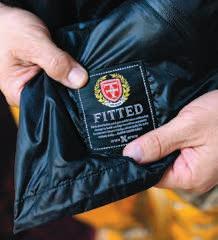
Pēlā ka poʻe kūpuna. ʻO Paiʻea, ma kona naʻi aupuni ʻana, kau mai i inoa hou. A he waiwai luaʻole kēlā no ka hiki ke holomua. He like me ka ʻikena naʻu ke kahe koko, ke hou, a me nā hiolo maka a I kēia noho hiki ke kaʻana ʻike, a aʻo pū I kekahi mea. He like nō me ke kapa ʻana I kekahi inoa a me ke kau ʻana I inoa hou, a me ke kuanaʻike kūpuna ʻo ka hoʻopaʻa moʻolelo me ka ʻikena inoa, ka ʻohiʻohi ʻana I 300 inoa makani me ka ua. [ʻO kō kākou kūpuna] waiho lākou I kēia mau momi ʻo ke kilokilo mai ka pō mai a he hoʻoulu ia naʻu. He ulu nō kēia I nā mea a pau. He wili hou, a wili hou I lei e maikaʻi ai ke ola a e mau ka ui ma kaʻu hana. He hoʻoheno koʻu I ka wā ma mua o haki ke kaula hao, ʻo kaʻu kuleana nui ka haki ʻole ʻo ke kaula hao.
ana, kaʻapuni au i ia ʻike, pēlā ke ola. ʻAʻole au i manaʻo he mea ʻē ia. Ma koʻu neʻe ʻana a kokoke i ke kaona, ʻike iho la au, ‘Uao, palala. Nui nā kānaka I paʻa ʻole ka loina.’ ʻO ia hoʻi, ʻaʻole lākou i hele i kekahi loʻi ma mua, ʻaʻole i kamaʻāina i ka loko iʻa, i ʻole kekahi mākāhā. Kīkē ka ipu. He kōkua a koʻo ka nohona maʻaneʻi. ʻO au kekahi. Pēia e hoʻomaka hou ai e uhai kūpuna.
He pōpilikia paha. He pipiʻi ka nohona, ʻo ia kekahi kaumaha. Nui nā mea i hai ʻia e noho kūpaʻa i ke ola, ma Hawaiʻi nei. He mau kupa kāua a Oʻahu, a he kākoʻo haʻaheo au ʻo ka Moku o Kākuhihewa nei. A eia kekahi, he ʻokoʻa ka nohona maʻaneʻi, ʻokoʻa pū ka nohona Kauaʻi, ka nohona Maui, a me ka nohona Molokaʻi kekahi. E aʻo mākou mai kō mākou hoa hānau a noʻonoʻo pū no ka nohona ma lalo ʻo ka hale hoʻokahi. Kupaianaha ka nohona o kākou ma lalo ʻo hoʻokahi hale a e huliāmahi i paʻa ke kahua. ʻO ia mau nō ka pōpilikia, a he pono ka hoʻopaʻa. He keu nō a ka pipiʻi ka nohona Hawaiʻi maʻaneʻi. ʻAʻole e hiki paha kaʻu kamaiki e kūʻai ai i hale, a he mea koʻikoʻi kēlā. He pōpilikia kēlā i nā Kānaka ʻōpio me kō lākou loina. Inā e kuapo ʻia ka ʻōlelo Hawaiʻi ʻo ka poʻe kūpuna me ka ʻāina i lawe ʻia nei mai kō mākua-he akāka ke kuapo ʻana i nā manaʻo. Pono kākou e ʻimi i pane: He ʻaha kai hoʻi kākou i ka ʻāina? He aliʻi ka ʻāina, ʻo mākou ke kauā. Inā hoʻololi kākou I ka ʻāina me ka ʻike, ʻo ka ʻike kekahi manaʻo ākea ʻo ka ʻāina a me ka ʻāina momona. ʻO ka ʻike kō kākou kākālina. Kahi mea e hāmama ai ka puka. No
He manaʻo panina paha kāu? Pili i kēia a i ʻole iā ʻoe iho?
ʻAʻole ka ʻike kūpuna kekahi mea e waiho ai ma ka haka. ʻAʻole ia he kiʻi hoʻomanaʻo. ʻAʻole ia he mea e nānā aku me ka maka mānoanoa. Inā ʻoe he kānaka, inā nō. Waiho ka hilahila. Hoʻomanaʻo au I kaʻu wā kamaiki he hilahila nō au. Inā ʻaʻole I hiki mai koʻu mākua, ʻaʻole au I ʻai. Haʻi mai koʻu ʻanakē, “Palala, hilahila ʻoe, make pōloli.” Hāliʻaliʻa mau ia I koʻu lolo. “ʻAʻole, ʻanakē, ʻŌKē au.” “Kama, shua ʻoe? Hilahila ʻoe, make pōloli,” a he hāliʻaliʻa kūpono ia ma koʻu alahula. E mau i ke kūpaʻa Hawaiʻi.
Hoʻoponopono ʻia kēia kūkākūkā no ka pueko a me ka wali.
He ʻono ka pāleoleo i nā ʻai ʻo Hawaiʻi, hea ʻia ʻo Hawaiʻi ma nā mele (pāleoleo), a me kekahi ʻano like ʻole. He aloha paha kō kekahi i kekahi no ia ʻano walaʻau ʻana i ke ʻano o ke ea no ke Kānaka ma ka lole, ma ka pāleoleo, ma ka hana noʻeau, ma ka moʻolelo. ʻO kaʻu nīnau ma hope mai, pehea hoʻi ka hana noʻeau e koʻo i nā Kānaka e noho kupa ma Hawaiʻi nei? ʻO ka mua, ʻo kēia hānauna a me kēia mākeke, [noʻeau] ʻo ia ka lou. ʻIke au he nui a manomano nā mea e alakaʻi ai i nā kamaiki a me nā kānaka, ʻo ka hele nihi ka makamua. Ma hope mai ʻo ka lou he papakū mai i ka loina kūpuna, ma laila ka momi e hoʻomaka ai i ia ala pilina, ma nā ʻāina ʻē me maʻaneʻi nō kekahi. I kaʻu ulu aʻe nā ʻōpio e ulu mai nei, hamāma ka puka e noʻonoʻo me ke kuanaʻike Hawaiʻi, pēlā e kaʻi ai ma kēia honua. Me ke kapolena pena ʻole lākou e kaʻi ai ka honua a ʻike I kēlā ʻāina — na lākou paha e kilo a ʻike I kekahi manaʻo Waiwai hou, kūkulu I ʻoihana hou. No ka lani mai paha ia ʻike, mai nā kuahiwi e ʻīnāna ai I ka hanāuna. Paʻakikī ka hoʻopaʻa ʻana I ʻāina no kākou pākahi. ʻIke Hawaiʻi, Hawaiian IP. No mākou nō. Waiho ʻia no mākou. ʻO ia ke koko me ka hou a ka poʻe kūpuna i hiohio ai no mākou. Ke hoʻopāneʻe iki nei au I kēia mea maʻaneʻi [ma Fitted]. E noʻonoʻo pū i nā mea ma hope mai e hāmama mai ei.
52 _ FLUXHAWAII.COM
_ MAOLI PHILES



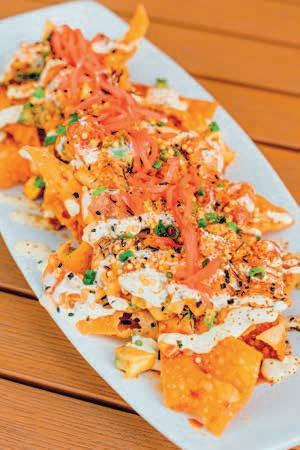

your favorite
kalapawaimarket.com 306 S Kalaheo Ave, Kailua, HI 96734 (808) 262-4359 kailua beach KAILUA TOWN 750 Kailua Road, Kailua, HI 96734 (808) 262-3354 41-865 Kalanianaole Hwy Waimanalo, HI 96795 (808) 784-0303
711 Kamokila Blvd #105, Kapolei, HI 96707 (808) 674-1700 KAPOLEI Our food is designed to fuel every local lifestyle Our classic favorites are inspired by home cooked meals, backyard BBQs & beachside picnics, because we know how Hawaii loves to eat.
stop in the neighborhood
WAIMANALO

“ After extensive investigation and survey
it was found that the only method in which to
FEATURES

on the part of various organizations organized to rehabilitate the Hawaiian race,
rehabilitate the race was to place them back upon the soil. ” —
55 IMAGE BY _
Jonah Kūhiō Kalaniana‘ole
JOHN HOOK
Past Meets Present

 TEXT BY IMAGES BY _ TIMOTHY A. SCHULER _ JOHN HOOK
CHRIS ROHRER
TEXT BY IMAGES BY _ TIMOTHY A. SCHULER _ JOHN HOOK
CHRIS ROHRER
FLUX _ FEATURE 56 56 _ FLUXHAWAII.COM
PLACELESSNESS

PLAGUES
COMMUNITIES
IN THE STRUGGLE TO CREATE AFFORDABLE, DIGNIFIED HOUSING.
FEATURE _ ADAPTIVE REUSE
57
Afew years ago, I was invited to the opening of a new affordable housing development in Kakaʻako. Several hundred people mingled on the eighth floor rooftop, a carpet of synthetic turf underfoot. Television crews pointed their cameras up at the boxy tower, its lines of windows and yellow accents meant to evoke, according to the developer and its PR team, the patterns of Hawaiian kapa and the spirit of Keaomelemele, a kumu hula described in numerous moʻolelo who was said to have formed Nuʻuanu Valley. Later, we took the elevator up to one of the building’s two “sky lānai” on the 33rd floor, an open-air gathering space that was meant to democratize the 43-story building’s panoramic views. I stood at the glass railing, framed within the lānai’s mustard-yellow box, and wondered if this was the future of housing in Hawaiʻi. If it was, what did that future look like?
There are few topics in American culture more divisive than housing. Many people agree that the cost of housing has reached crisis-levels. In Hawaiʻi, and elsewhere, rents have skyrocketed, particularly during a global pandemic. In 2021, while my wife was pregnant with our son, our landlord raised the rent on our 1-bedroom apartment from $1,600 to $1,800.
Particularly controversial is the construction of new housing, which has become a bogeyman for residents across the political spectrum. For homeowners, contemporary housing developments can be seen as a threat to neighborhood character and, possibly, their property values. For renters, those same projects are often seen as a harbinger of gentrification. An overlooked thread in these
debates is the look of the housing, which, regardless of price point, tends toward large, squarish, flat-faced blocks punctuated by a pattern of colored panels.
The writer Jerusalem Demsas has documented the ways in which aesthetics and concerns about gentrification have become conflated, and not just among design critics. On TikTok, Demsas found that #gentrification brings up countless “posts criticizing modern homes for mostly aesthetic reasons.” One video, captioned “honestly, so ugly,” critiqued an affordable housing project in Camden, New Jersey, for being what the user assumed was a “gentrification building,” mostly based on its size and color scheme. Commenters piled on, with this quip collecting tens of thousands of likes: “why is it ALWAYS h&r block green?” Contemporary architecture and fears of gentrification have “simply become inextricable,” Demsas wrote in 2021.
Aesthetic-based opposition to new housing isn’t confined to TikTok. Throughout the country, historic preservation boards and design review panels regularly reject proposals for new apartment or condominium buildings on architectural grounds—the proposed building is too tall, or too large, or too contemporary to meld with the existing neighborhood.
The aesthetic in question has become so common that in 2023, the New York Times published an article titled “America, the Bland.” The style has birthed a whole array of derogatory descriptors, which fellow design writer Patrick Sisson compiled for Curbed in 2018: Minecraftsman, McUrbanism, developer modern, contemporary contempt, lo-mo (low modern), and, what CAN ADAPTIVE REUSE RESCUE OUR HISTORIES?

58 _ FLUXHAWAII.COM
_ ADAPTIVE REUSE FEATURE
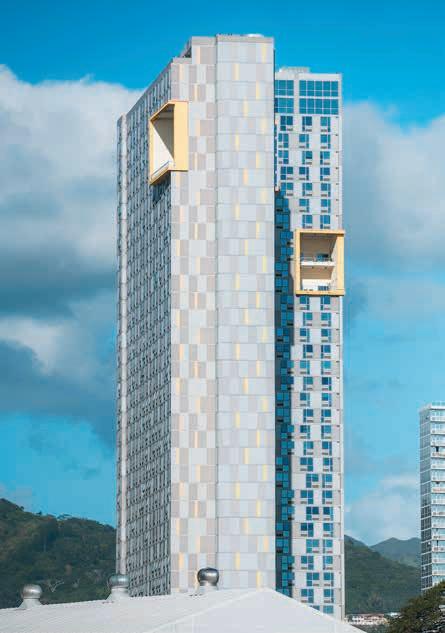
ARCHITECTURE CRITIC KATE WAGNER HAS WARNED THAT OPPOSITION TO NEW HOUSING ON STYLISTIC GROUNDS IS AN EXAMPLE OF “AESTHETIC MORALISM,” THE BELIEF THAT ONE STYLE OF BUILDING IS BETTER SUITED OR MORE APPROPRIATE TO A PLACE THAN OTHER STYLES.

has arguably become the most enduring: fast-casual architecture. If you live or have spent time in Honolulu, you’ll recognize the style from Hale Mahana, the pixelated, gray-and-white-paneled apartment building at the intersection of University and King — or, yes, from Ke Kilohana, the condo tower with the yellow “sky lanai.”
I have a certain respect for the idea that animates Ke Kilohana’s high-altitude amenity spaces: the inversion of conventional developer logic, which typically reserves the highest floors for the highest-paying tenants. But I can’t in good faith argue that the building is beautiful. The not-quite-staggered, not-quite-straight lines of windows; the
59
Opening spread, Modea Formerly Davies Pacific Center 841 Bishop St. Left, Ke Kilohana 988 Halekauwila St.

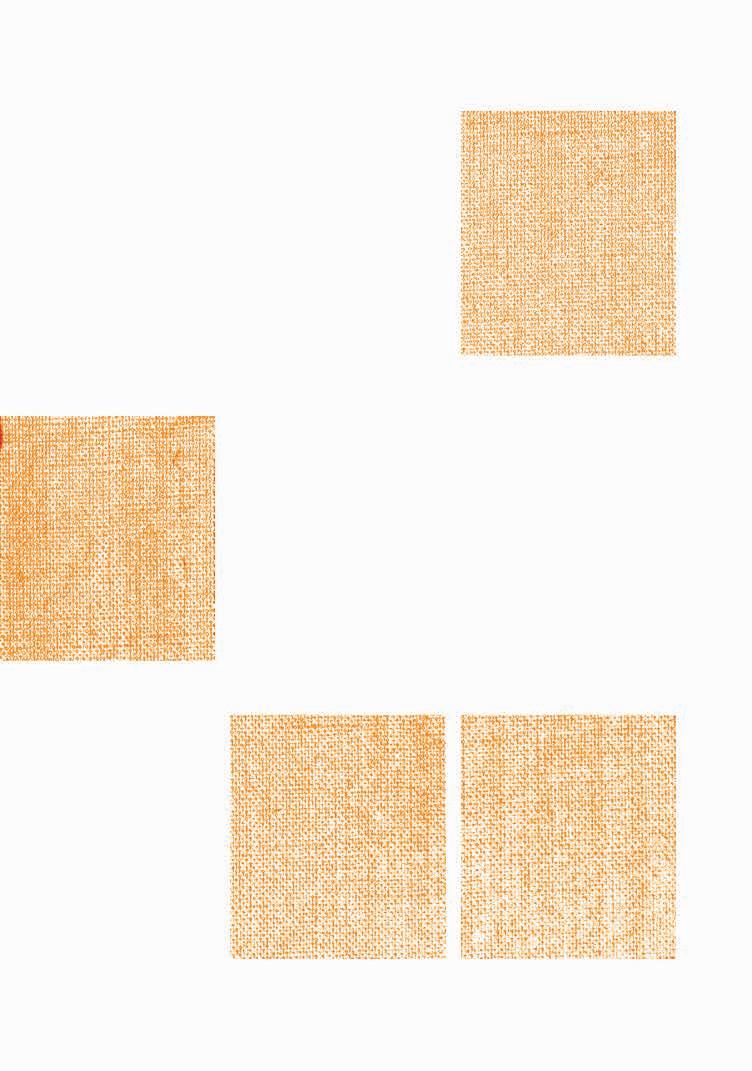


61

chaotic splatter of colors and materials; the deadening effect of a seven-story podium (most of which is parking) — the whole thing feels cheap and strange, like it was built in the sad, plasticky environs of the Metaverse. Honestly, Minecraftsman sounds better.
The architecture critic Kate Wagner has warned that opposition to new housing on stylistic grounds is an example of “aesthetic moralism,” the belief that one style of building is better suited or more appropriate to a place than other styles. This distracts us, she writes, from debating the underlying forces making housing unaffordable and, in a lot of places, unbuildable. But, if the war against new housing — par-

to be waged in aesthetic terms, then style matters. The look and feel of new housing can be either an ally or an enemy in its very materialization.
I’m not about to argue that kowtowing to residents’ (often petty) complaints should stop us from building new housing, and I’m not suggesting that politically difficult policy reforms — particularly on subjects like zoning and rent control — aren’t necessary if we’re to solve the affordability crisis, in Hawai’i and elsewhere. But I do think this moment offers a chance to invest in a building practice, and general design and urban development philosophy that can circumvent this kind of aes-
IN ARCHITECTURE, ADAPTIVE REUSE REFERS TO THE PROCESS OF RENOVATING AN EXISTING BUILDING, OFTEN VACANT HISTORIC STRUCTURES, FOR A NEW PURPOSE OTHER THAN ITS ORIGINAL INTENDED USE.
62 _ FLUXHAWAII.COM
FEATURE
917 Kokea St.
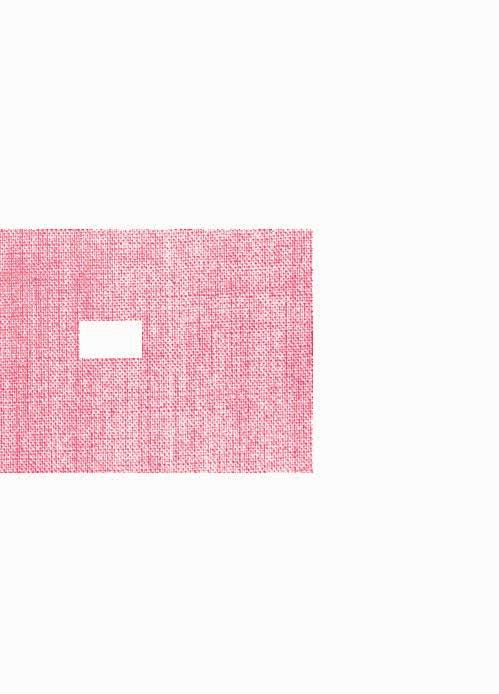
thetic opposition while also preserving layers of Hawaiʻi’s history and avoiding unnecessary carbon emissions: adaptive reuse.
Adaptive reuse is a wonky term that simply means converting a structure from one use — say, a warehouse — to another, such as condos or a coworking space. It’s basically recycling, but at the scale of entire buildings. The practice isn’t new, even in Hawaiʻi: The old circuit courthouse in Wailuku, Maui, was adapted into office space and a museum in the mid-1990s. Our old apartment building, Lili‘uokalani Gardens, began its life as vacation rentals marketed to Japanese tourists. And most of Kakaʻako’s galleries and artist studios occupy

spaces built for manufacturing or warehousing goods. But adaptive reuse is beginning to catch on in an even bigger way, in part due to the rise of remote work and the subsequent emptying out of offices. As of 2022, a majority of architectural billings come from renovations of existing buildings, not the design of new ones. A full quarter of that work is on adaptive reuse projects.
“The office vacancy issue happened even before the pandemic, with technology and just different lifestyles. The pandemic just sped up that trend,” said Janice Li, a Honolulu-based architect and studio director for Lowney Architecture, which also has offices in Oakland and Los Angeles. Li and her team
are currently working to convert the bulk of Davies Pacific Center, a Brutalist office building at the corner of Bishop and King streets designed by the late Honolulu architect Steve Au, into residences.
Li and other architects who have worked on adaptive reuse projects in Hawaiʻi say it offers a quicker, less costly pathway to more affordable housing for the islands because converting an office building into apartments avoids the time-consuming work of conducting an environmental assessment, preparing the building site, and erecting the structure. Some researchers have estimated that the construction costs of adaptive reuse projects can be as much
63


Maybe we already have what we need. Maybe what looks like an abandoned newspaper office is actually future workforce housing.

as 48 percent lower compared to new construction. These savings theoretically can produce housing that a wider swath of the population can afford. I say “theoretically” because our current system doesn’t guarantee that those cost savings will be passed on to potential buyers or renters. At Davies Pacific Center, for instance, all of the housing units will be sold at market rate.
The financial picture is just one benefit of adaptive reuse. Another is its ability to avoid the public handwring-
ing that often accompanies new housing. The struggle to create affordable, dignified housing isn’t confined to the spreadsheets of loan officers or the computer screens of architects. It plays out in the public sphere. Many of the barriers are social or political in nature, whether it’s basic NIMBY-ism or the understandable distrust residents have for real estate developers. But people rarely protest a building that’s already there. “I would say that that is one of the primary benefits of adaptive reuse,”
Jonathan Helton of the Grassroots Institute of Hawaiʻi told me. He points to Hocking Hale in Chinatown, which is currently being converted from office space to affordable housing. “I haven't heard of anyone who's coming out and complaining about it.”
Repurposing buildings from the past also guarantees a more heterogeneous urban landscape, avoiding the placelessness that people seem to associate with “fast-casual” architecture, and offers opportunities to preserve spaces
65
FEATURE _ ADAPTIVE REUSE
that hold important cultural memories. Not long ago I interviewed Brent Leggs, the executive director of the African American Cultural Heritage Action Fund, about the value of preserving the past. He told me that the loss and erasure of African American historic places is its own kind of trauma. Watching buildings and spaces that had served as safe gathering places, or had been places of great community pride or simply part of the background of everyday life, become derelict or disappear has psychological ripple effects on the communities who claim them.
For many residents of Honolulu, loss and erasure has been the defining experience of their relationship to the city, from the destruction of fishponds and loʻi kalo in the early 20th century to the intentional torching of Chinatown in response to fears of the bubonic plague. Despite government protections for the most significant places, in Hawai‘i, the wrecking ball still seems to swing with the regularity and precision of a pendulum, leaving gaps in communities’ collective memory.
As an architect raised in Honolulu, Dean Sakamoto has an intimate understanding of these effects. “When you clear a site, or you take something down that's been there for a long time, it's catastrophic change,” he told me recently. “There's not much difference between building demolition and a war[zone], when you think about it, physically. A bomb hitting a building or a building being knocked down — it’s catastrophic.” Sakamoto worries that history will continue to repeat itself unless we begin to see the built environment differently: as part of a cultural fabric that can either be tossed aside or rewoven into something even stronger and more beautiful, a tapestry that contains threads of both the present and the past. “I think part of our responsibility as architects is to help society see what's overlooked and to re-establish value,” he said.
Sakamoto has become something of a poster boy for adaptive reuse in Honolulu. He’s at work converting a former office building in downtown Honolulu into a teaching lab for Hawai‘i Pacific University and even recently purchased Chinatown’s Liberty Bank building, designed by Vladimir Ossipoff in 1952, which he plans to use as an office for his organization, SHADE Institute, as well as for cultural events and programs. His latest effort has been co-leading an architecture studio at Yale University that explores turning Hawaii Hochi building, designed by Pritzker Prize-winning architect Kenzo Tange for the Japanese-language newspaper in 1972, into workforce housing.
Sakamoto’s mother grew up in Kalihi just down the street from the building. “My grandmother used to read the Hawaii Hochi in Japanese religiously. She would say, ‘Where's my Hochi?’ and you’d have to go find it for her.” The paper, and its sister publication, the Hawaiʻi Herald, moved to a new building in 2022, and today the building sits vacant. Sakamoto is pushing Kamehameha Schools, which owns the building, not to tear it down. “I [told them], there’s three reasons why you gotta save this thing. Number one, you’ll look really bad, environmentally, because all that sequestered carbon gets thrown away. Number two, it’s going to cost you a lot of money to demolish this thing. And number three, this [area] was a Japanese-American enclave. There's a cultural memory of that.”
Adaptive reuse is not a cure-all for Hawai‘i’s housing woes. Despite its growing popularity, it remains a niche practice in a niche discipline, and not all buildings are well-suited to become housing. But the idea of recycling our buildings gestures toward a larger ethic of resourcefulness and circularity and even to ideas about abundance. Maybe we already have what we need. Maybe what looks like an abandoned newspa-

66 _ FLUXHAWAII.COM
FEATURE _ ADAPTIVE REUSE


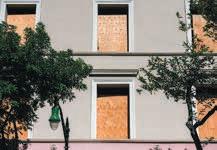
per office is actually future workforce housing. Maybe we honor the past — good and bad — when we take the time to consider how a space might be given new life, rather than bulldozed into the ground.
Perhaps the word to describe this next century’s economic aspiration should not be “growth,” but “adaptabil-
ity.” In the same way that once-brittle systems must become more flexible and responsive in a time of climate chaos, perhaps our conception of housing must become equally malleable.
“THE OFFICE VACANCY ISSUE HAPPENED EVEN BEFORE THE PANDEMIC, WITH TECHNOLOGY AND JUST DIFFERENT LIFESTYLES. THE PANDEMIC JUST KIND OF AMPLIFIED OR SPED UP THAT TREND,” EXPLAINED HONOLULU-BASED ARCHITECT JANICE LI.
Building 2 North King St.
67
Hocking
FLUX _ FEATURE 68

“THE REALITY IS A LOT OF US WILL

NEVER
BE ABLE TO OWN A HOME, NO MATTER HOW HARD WE TRY HERE.”

Housing Gen Z
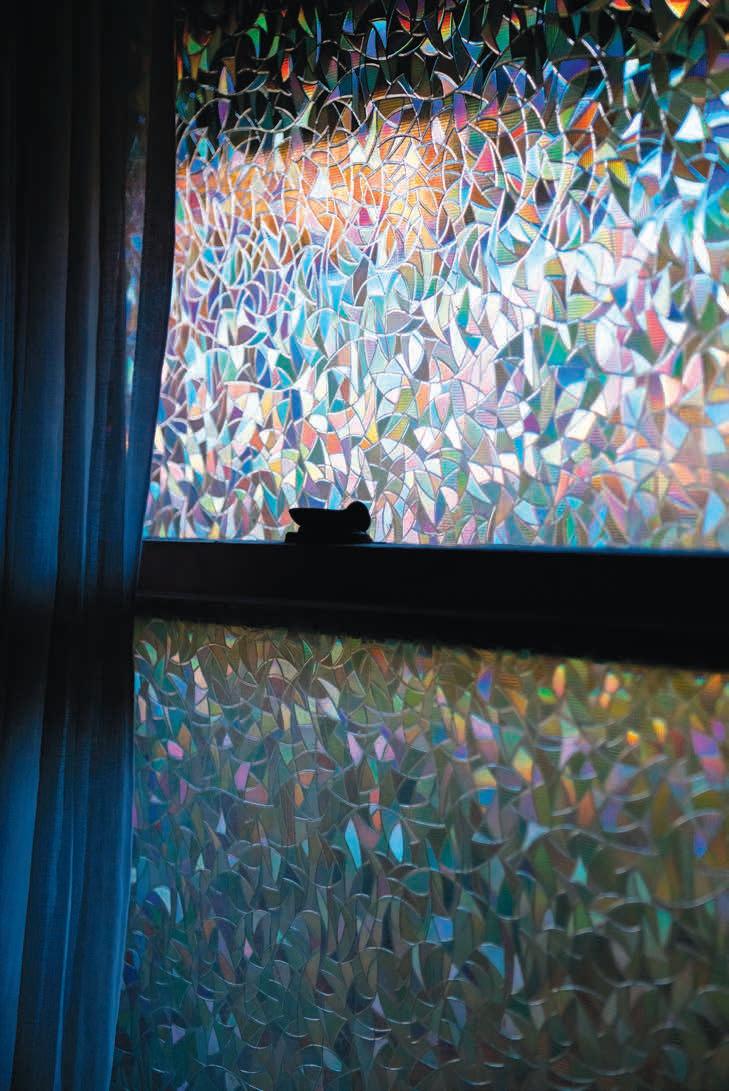
KAIA STALLINGS
JOHN HOOK
SHANDELLE NAKANELUA
TAYLOR NIIMOTO
ERICA TANIGUCHI
TEXT BY
IMAGES BY
_
MATTHEW DEKNEEF
_
DESMOND CENTRO
WHAT’S ON THE MINDS OF THE YOUNGEST GENERATION IN THE LOCAL WORKFORCE WHO CAN BARELY AFFORD HAWAI‘I?
With its warm weather and beautiful beaches, Hawai‘i is heralded in the public imagination as a so-called tropical paradise. But, it’s no secret that these islands are also one of the most expensive places to live in the United States. Multi-pronged factors ranging from the state’s reliance on imported goods to strict zoning regulations all contribute to the hefty price tag. In May 2023, the median cost of a home on O‘ahu rose to $1,109,000; the state’s median household income hovers at $83,000, according to a study with data obtained from the 2020 American Community Survey.
Enter Generation Z.
Born between 1997 and 2012, they are the latest batch of emerging adults, the eldest being approximately 27 years old. Their median annual earnings in Hawai‘i land at $37,770. Not only do Gen Z-ers living across the islands have to face the challenge of keeping up with its cost of living, but they also have to deal with the ever-growing economic downturn that began during the pandemic (supply-chain driven inflation being one of the contributing factors to the steady increase in the cost of living around the nation). As Hawai‘i navigates this post-pandemic
landscape, addressing housing affordability is crucial to ensuring a sustainable future for the state’s younger generations. Flux spoke with Gen Z-ers from a range of backgrounds and occupations across the islands to learn more about their living situations and direct experiences with the current housing landscape. Nearly all of them are renting, most are just scraping by. Collectively they portray their generation’s current-term strategies and solutions to retain decent accommodations in a scarce affordable housing market, along with their hopes and anxieties about future homeownership. —Kaia Stallings
FEATURE FLUXHAWAII.COM _ 71
_ GENERATION Z


RESIDES IN ‘AIEA, O‘AHU
HAILEY MEDLOCK
21-YEAR OLD STUDENT AND SWIMWEAR DESIGNER
SPENDS 0% ON RENT
Medlock lives with her parents in their home. “I also work part time, but my parents understand that at the end of the day what I make working part-time and what I make with my business is what I need to be putting away and saving to actually move out. I’m really lucky that they don’t charge me rent,” she says. “Lately, I’ve been going on Zillow and not only has the base cost of owning an apartment in Honolulu gone way up, but rent has also gone way up, too. Just seeing how much the economy really increases [the cost of housing] in a short amount of time kind of adds to my fears.”
73 FEATURE _ GENERATION Z
IMAGE BY _ JOHN HOOK
RESIDES IN KAKA‘AKO, O‘AHU
DANIEL THOMPSON
25-YEAR OLD STUDENT AND GRAPHIC DESIGNER
SPENDS 45% ON RENT
JAYSEE MOORE
22-YEAR OLD STUDENT AND RETAIL SUPERVISOR
SPENDS 40% ON RENT
Thompson and Moore share a studio apartment. “We are most likely never going to buy a home. I think at this point, having each other, our own place, a cat — that’s all we ever wanted,” Thompson says. “We are very fortunate that we are a healthy, happy couple. Getting our own place would not have been possible if we were not dating. I just don’t think within our generation it’s even possible to afford a home in Hawai‘i.” The couple are hopeful, however, about eventually moving abroad. Moore says, “One of our dreams and goals would be to possibly open a small coffee shop in Japan that is also a home.”
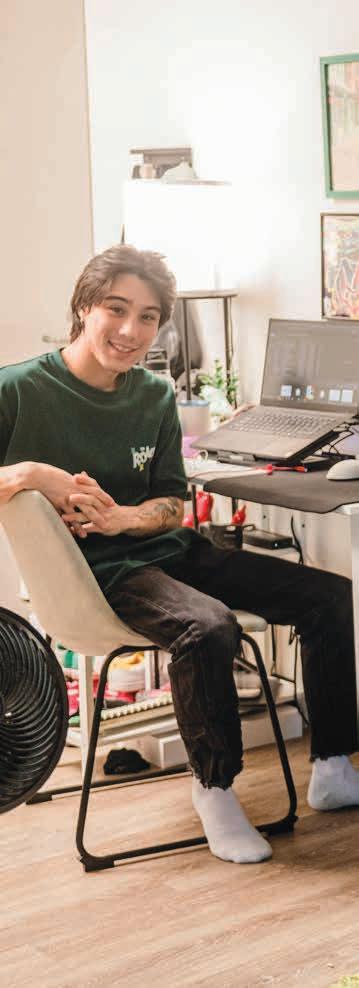
74 _ FLUXHAWAII.COM
FEATURE _ GENERATION Z
IMAGE BY _ JOHN HOOK

 KODIE SOLIS-KALANI 27-YEAR-OLD NONPROFIT COORDINATOR
KODIE SOLIS-KALANI 27-YEAR-OLD NONPROFIT COORDINATOR
SPENDS 50% ON RENT
IN PA‘AUILO,
Solis-Kalani lives with her partner and child in a one-bedroom house. “Thinking from a Hawaiian perspective, you can’t ‘own’ ‘āina, you steward ‘āina. But I do want something that I can cultivate and not have to worry about someone taking away from me,” she says. “I’m starting to dive into that now, looking at properties, looking at what we can afford and, now that I have a keiki, what I want to pass down to her. There is a dream [to own], but it seems like you have to find the right timing and you have to have the money. We’re trying to raise our family, but also trying to make money and trying to do all these things to eventually own a home. And it’s hard.” Her landlords, who are from California, are close associates of her employer and believe in the food resiliency work the nonprofit does. “They’re really good people that are part of that crowd that wants to give back to locals. So I kind of scored on having a home so close [to work] and it’s pretty affordable for this area. The hardest part to accept of all of it is that I lucked out having this house, and that shouldn’t be the case.”
77
RESIDES
HAWAI‘I ISLAND
FEATURE _ GENERATION Z
IMAGE BY _ SHANDELLE NAKANELUA
RESIDES IN KALIHI, O‘AHU
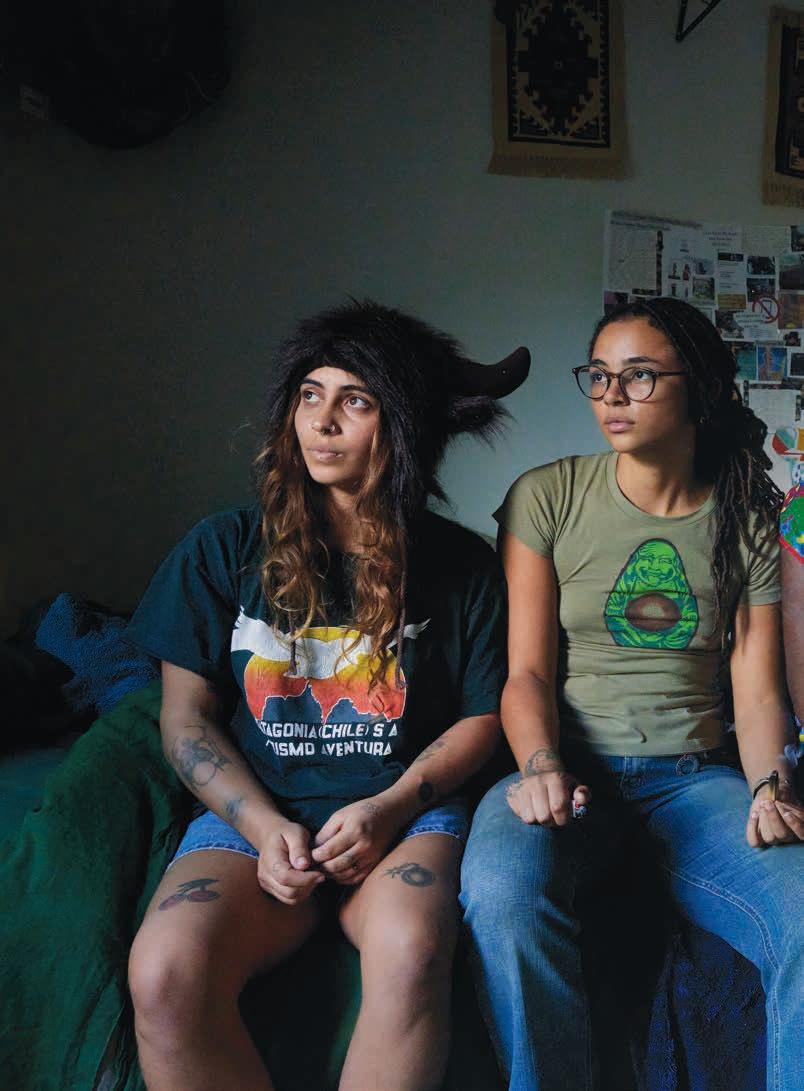
AMINA GIWAH (CENTER)
20-YEAR-OLD YOGA TEACHER
SPENDS 0% ON RENT
KYLA MICHELLE (RIGHT)
21-YEAR-OLD EDUCATOR
SPENDS 60% ON RENT
THEIR FRIEND KAYA (LEFT) WHO LIVES NEARBY
78 _ FLUXHAWAII.COM FEATURE _ GENERATION Z
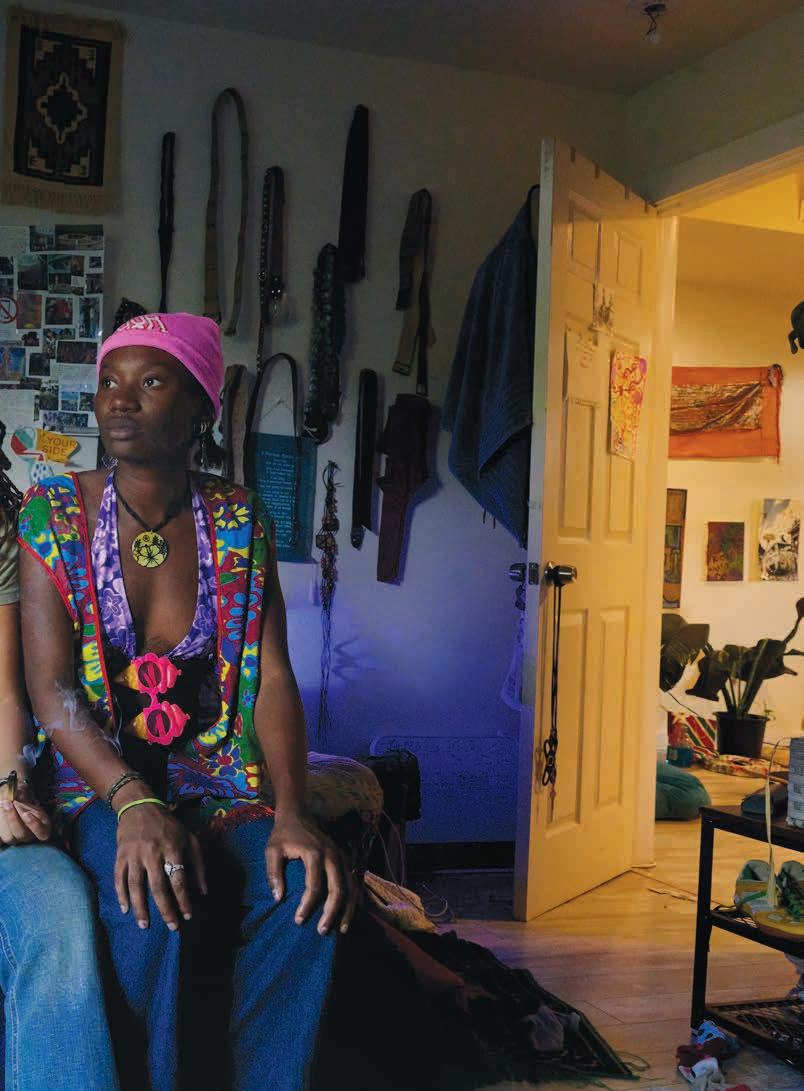
Giwah and Michelle are close friends and roommates, who live in a two-bedroom duplex. “My current anxiety is that I’ll never be able to afford to financially support myself in this world,” says Giwah, who has family assistance for now to pay her rent. “And that goes for people in situations less fortunate than mine, so I’m just concerned about the housing situation in our society and where it’s going.” Michelle echoes that sentiment, saying, “Working at the middle school down the street has made me aware of the roots of the neighborhood and the people who’ve been living here for a very long time. My concerns include increasing prices for the working class and how people can’t afford to live on their own land anymore.”
79
IMAGE BY _ DESMOND CENTRO
SKYLER NAKAMURA
28-YEAR-OLD ARCHITECTURAL DESIGNER
SPENDS 45% ON RENT
KELLEY HO
25-YEAR-OLD TEACHER
SPENDS 45% ON RENT
Ho and Nakamura live in a one-bedroom condominium. Nakamura’s mom, who is also their landlord, rents the property to the couple. “I worry a lot more about the future because my mom kind of instilled, like, an old-school mentality in me of, ‘You need to buy a house. This is the way to succeed,’” Nakamura says. However, he finds that “near impossible” in Hawai‘i’s market, saying, “No one is able to afford [to buy] without a lot of luck or coming into money somehow.” Ho feels blessed to be renting from Nakamura’s family, but says they’re both worried that should they want to start a family, they’ll require more space. “I don’t know how to say this without being really blunt,” she says, “but, honestly, I feel like we’re never going to be able to buy a place until somebody dies. We can inherit, then use that. I mean, that’s the reason why my dad is holding on to his house. In the event that he passes, he wants us to be able to sell it, and then we can use it as a down payment.” Nakamura echoes that this is “the conversation that our parents have with us” in 2024, he says. “A little morbid, but the reality.”
BY _
TAYLOR NIIMOTO
80 _ FLUXHAWAII.COM FEATURE RESIDES IN M Ō ‘ILI‘ILI, O‘AHU
_ GENERATION Z
IMAGE

RESIDES IN WAILUKU, MAUI
MOANANUI PELEIHOLANI-BLANKENFELD
25-YEAR-OLD
NONPROFIT EXECUTIVE DIRECTOR
SPENDS 45% ON RENT
Peleiholani-Blankenfeld lives alone in a one-bedroom cottage. She describes it as “a branch off of the main house,” which is where the property owners dwell. While her rent is “kind of crazy expensive,” she feels lucky to have found a peaceful area to call home given how limited housing is on Maui. Peleiholani-Blankenfeld moved to Wailuku from Hilo for a better job opportunity. As a single woman on a new island, she prioritizes privacy and safety in her living situation and recognizes she may be taking a “big financial hit” to ensure both. “There’s a lot of things that I’ve had to sacrifice,” she says. “I don’t get to spend a lot of time with family or going out and doing fun things.” Even so, the recent college graduate is maintaining a positive outlook that the investment she made in her law school education will benefit her in her future homeownership goals. “I’m pretty hopeful and optimistic and I’ve been trying my best,” she says, “trying to save money to go toward my own place.” Her rental coexists with a few other separate units, whose residents she refers to as her “ʻāina-mates” since they share a common plot of land. Her landlord even granted her space for her own garden. “The land is very lush over here,” says Peleiholani-Blankenfeld, who looks forward to growing her own food sustainably and “to be able to not spend more money on groceries and just sustain myself at home.”
BY _ SHANDELLE NAKANELUA

82 _ FLUXHAWAII.COM
FEATURE
_ GENERATION Z
IMAGE
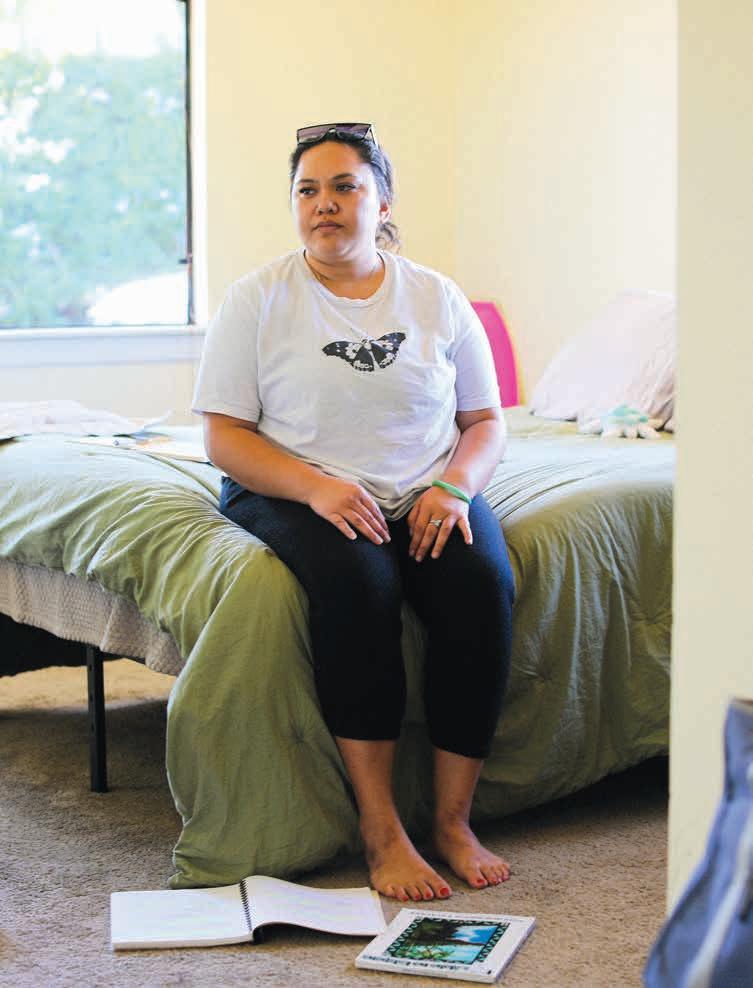
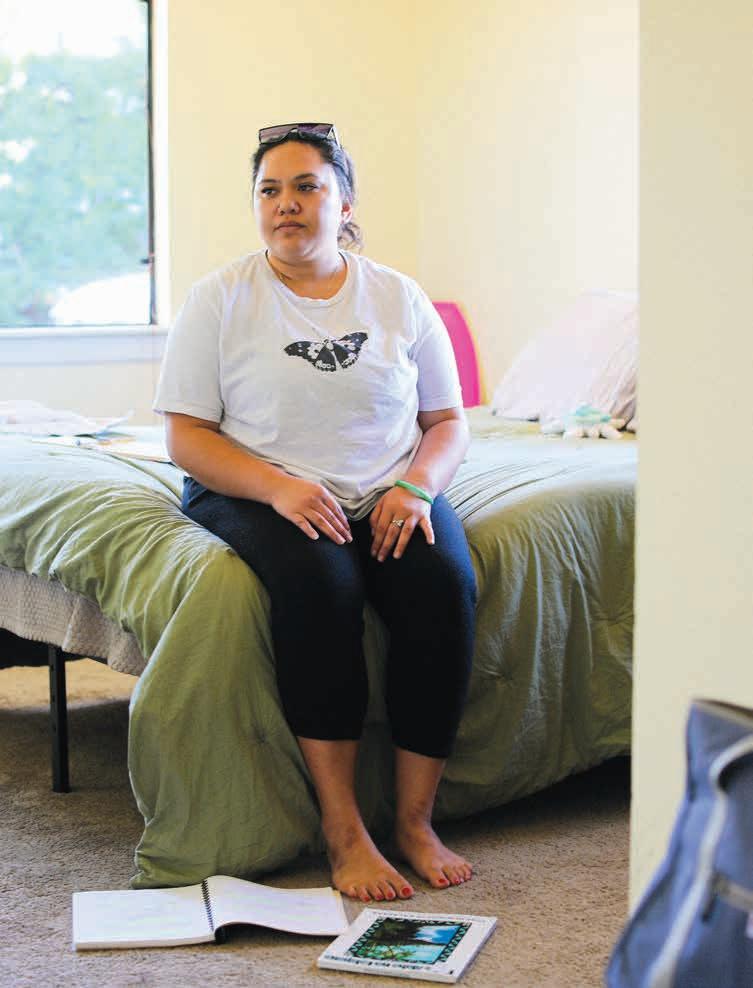
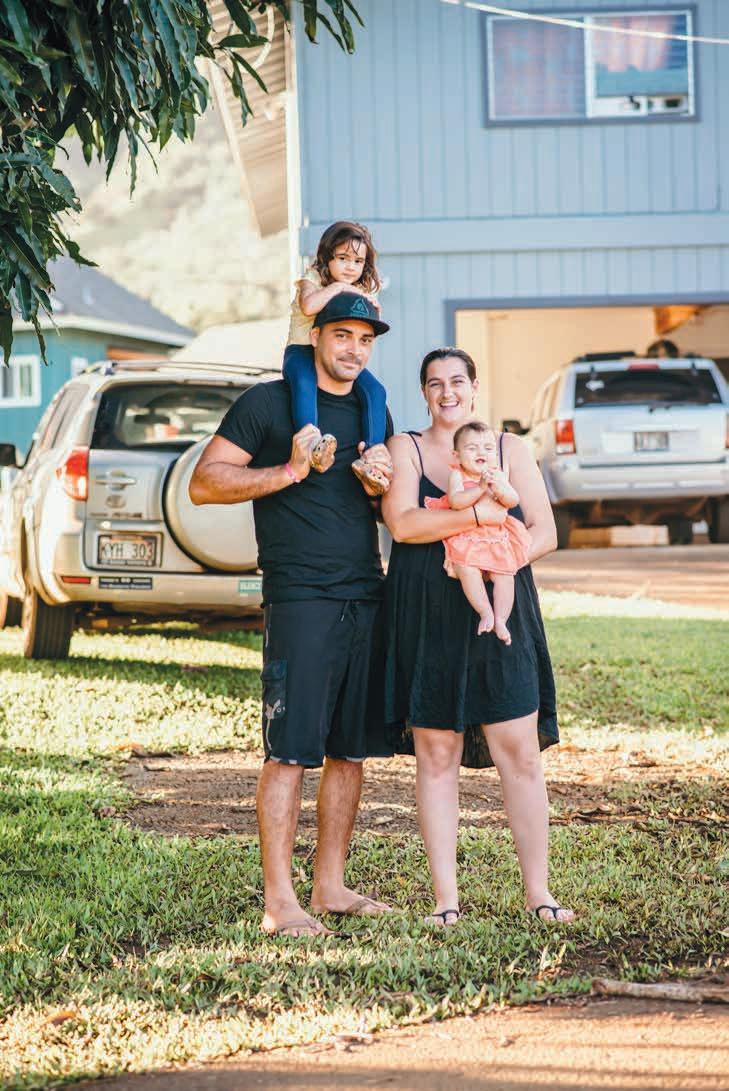
LEILANNA AND JOEL BILYEU
22-YEAR-OLD STAY-AT-HOME MOM
27-YEAR-OLD WINDOW CLEANER
SPENDS 50% ON RENT
The Bilyeus and their two infant girls live in a one-bedroom duplex. The home’s location — which is close to Leilanna’s mom and an easy commute for Joel’s job — along with its “best-wecould-find price” for the island’s east side, works for their family at the moment. But, “we’re obviously going to need more room eventually,” Leilanna says, referring to their kids as they grow. The married couple have even discussed moving out-of-state. “We’ve considered [moving elsewhere],” she says. “It’s been a serious topic, deciding whether or not to stay.” Joel admits trying to buy a place where he was born and raised is becoming a difficult thing to think is achievable. He hasn’t lost hope on the generation after him, though. “I think it’s possible to instill certain values in my children,” he says, “that could lead them to eventually purchasing a home here with more financial stability for themselves.”
FLUXHAWAII.COM _ 85
RESIDES IN KAPAHI, KAUA‘I
FEATURE _ GENERATION Z
IMAGE BY _ ERICA TANIGUCHI

FEATURE _ GENERATION Z

RESIDES IN PAPAK Ō LEA, O‘AHU
NALEOOLOKAHI FAUROT
21-YEAR-OLD STUDENT AND MODEL
SPENDS 0% ON RENT
Faurot lives with her boyfriend in his family’s three-bedroom, multigenerational homestead on Hawaiian Home Lands. Faurot, who grew up in ‘Ewa Beach, feels fortunate to now be living in a community centralized around her culture where there are “Hawaiians everywhere just living life as Hawaiians.” Both of her siblings, however, have moved to the U.S. continent where the cost of living is lower. “That’s one thing that I hate about the living situation, families being split up,” she says. Meanwhile, “you see so many houses where people barely even live in them, they’re just sitting there for a couple of months and it’s just, like, empty.” Faurot, who is part-Hawaiian, is enough to qualify to inherit a Hawaiian Home Lands lot, but not enough to apply for them on her own. “There should be more Hawaiian homes,” Faurot says. “It shouldn’t be a struggle for a Hawaiian to get a home in Hawai‘i.”
87
IMAGE BY _ DESMOND CENTRO
TAYLOR KANEAKUA
Kaneakua lives with her boyfriend, Chance Olanolan, and their son, Kū‘au, in a single-studio accessory dwelling unit on his family’s property lot. They may be on Kaua‘i’s covetable north shore, but the small size of the unit, which is all her family can afford, “definitely takes a toll,” Kaneakua says. “You feel like you’re living right on your things.” Kaneakua says she and her boyfriend have decent incomes. “Enough to survive, but it’s not enough to save and survive, if that makes sense,” she says. Because of the lack of affordable housing, she also worries about the swiftly changing demographics of the character of the neighborhoods around her. She cites grocery store visits where recognizing folks from the area is more infrequent and elementary school classrooms where children born and raised on Kaua‘i are the minority. “There’s barely any locals, let alone Hawaiian people, down here that own a property,” she says. “I could probably name only five out of 300 houses here still owned or lived on by Hawaiian people. It’s becoming a town where you sadly don’t know everybody anymore.”
ERICA TANIGUCHI

88 _ FLUXHAWAII.COM
26-YEAR OLD VACATION RENTAL CLEANER
ON RENT
SPENDS 35%
RESIDES IN H Ā ‘ENA, KAUA‘I
FEATURE _ GENERATION Z
IMAGE BY _

FLUX _ FEATURE 90

HAWAIIAN HOME LANDS ARE MEANT TO GENERATE NATIVE HAWAIIAN SELF-SUFFICIENCY, YET ONE COMMUNITY ON HAWAI‘I ISLAND IS AWFULLY OVERCHARGED FOR FRESHWATER.

WHAT WENT WRONG?
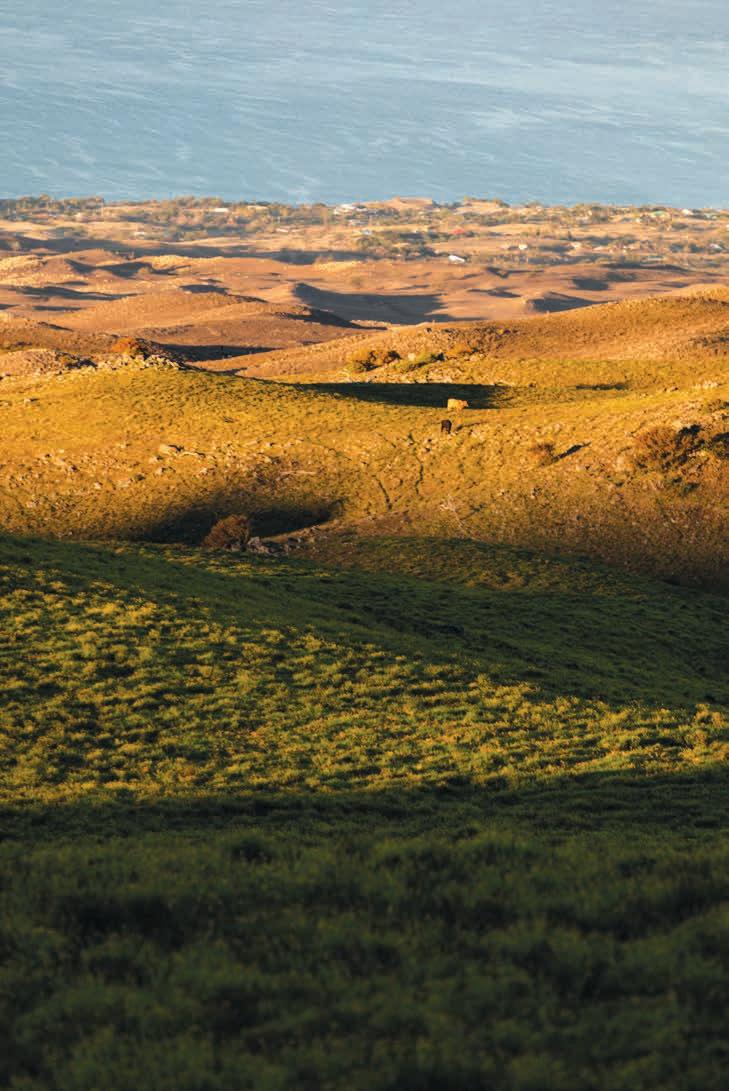
A People Deserted
TEXT BY
IMAGES BY _ KEALI‘I THOENE
_ NANI WELCH KELI‘IHO‘OMALU
The view from Kailapa, the Hawaiian homesteads community on Hawai‘i Island’s leeward side, is remarkable not because of what you see but because of what you do not. No buildings on the makai side of the highway obstruct the panoramic view of the Alenuihaʻa Channel. Here, the water is a shade of blue so dark that you almost sense the 6,000-foot chasm between the churning ocean surface and the sea floor. Annie Kahikilani Akau, a native daughter of Kawaihae, named the subdivision Kailapa, meaning “lapping waters,” for the waves that hit the cliffs during high surf.
On land, what you do not see is a diversity of plant life. Instead, the two dominant species kiawe and buffelgrass, drought-tolerant vegetation introduced to Hawaiʻi in the 1820s and 1930s respectively, have replaced the area’s bountiful native dry forest. In 1913, botanist Joseph Rock was dazzled by the biodiversity of Hawaiʻi’s dry forest regions because it was “in these peculiar regions that the botanical collector will find more in one day collecting than in a week or two in a wet region.” On his tour of Hawaiʻi Island, Rock found himself upslope of where the Kailapa community is today, already beginning to note the extinction that was taking place. “Three miles south of Waimea, the land is known as Kawaihaeiuka, and must have been once upon a time covered in a plant growth similar to Puuwaawaa now,” he observed in his field writings. “In fact, the land is now very open and only a few trees can still be found, cattle having destroyed them very rapidly.”
In Kailapa there is not much soil left to see, either. When cattle chomp and stomp plants, saplings are unable to take root. Bare soil slips off the steep mountain slopes. Today, two thin layers of material above the bedrock of Kailapa consist of mostly pebble fragments and dead grass that has yet to blow away. A 2006 study of the area’s soils concluded that the se-
vere nutrient losses “likely result from the strong downslope winds that can carry dead plant material, litter and/or ash into the adjacent ocean.” This fierce wind, called Mumuku, can also mean amputated, mutilated, or maimed.
Brandy Oye is familiar with this Mumuku wind. She was in high school when her father took her to visit the family’s lot in Kailapa in 1990. Under the blazing sun, he drove Brandy in their four-by-four pickup down a rutted dirt road past one of only two residences at the time, that of community stalwart Jojo Tanimoto.
“I remember passing Aunty Jojo’s house and I thought, ‘Where is Dad’s lot, and how do we know?’ Because there was no road. It was just offroading until Dad said, ‘Right here! This is it!’” Oye remembers. “And it was just red dirt and a flag pin.”
Teenaged Oye was dismayed. “I thought, ʻWhere are we?’ It was just red dirt and boulders.”
Oye was on the empty lot of what was to be her family’s home.
The 10,153-acre Department of Hawaiian Home Lands Kawaihae parcel, in which Kailapa sits, encompasses the entire ahupuaʻa of Kawaihae I. With an average annual rainfall of 120 inches in the forested mauka portion and around 5 inches at the coast just 7 miles away, this ahupuaʻa boasts one of the most magnificent rain gradients in the world. But you wouldn’t know it by the cost of water at the Kailapa homestead. Today, rates are over six times Hawai‘i county’s rates, and are slated to increase by 400 percent before the decade is out. The freshwater system that was meant to be a temporary solution has now been in place for more than 25 years. In addition to the exorbitant water bills, Kailapa residents face water insecurity.
The Hawaiian Homelands Commission is a Hawai‘i state agency regulated by the Hawaiian Homes Commission
_ KAILAPA FEATURE FLUXHAWAII.COM _ 93
Act. The HHCA is a U.S. law that “provides direct benefits to Native Hawaiians in the form of 99-year homestead leases at an annual rental of $1.” It was passed in 1921 when Hawaiʻi was a territory. After Hawaiʻi joined the union in 1959, the responsibility for administering the law was transferred to the state; today, it is the responsibility of the nine-member, governor-appointed, Hawaiian Homes Commission. The commission also oversees the Department of Hawaiian Home Lands, or DHHL, which is the larger state organization responsible for most day-to-day management of the land trust. The reason the trust exists at all is largely due to the efforts of Jonah Kūhiō Kalaniana‘ole, a forward-thinking Hawaiian prince.
land back
By the time a 49-year-old Kalaniana‘ole introduced the HHCA, which he would spend the remaining years of his life working to pass, he had already witnessed the overthrow of his kingdom and spent a year in jail for joining the forces who attempted a counter-revolution. The busy, globe-trotting aliʻi had introduced surfing to California, fought in a war in South Africa, and been sent, as a boy, to Japan for a year in hopes of being married off to Japanese royalty. By 1920, Kalaniana‘ole was a veteran delegate to the United States Congress when he testified before a full U.S. House of Representatives in Washington D.C., explaining why a Kānaka rehabilitation program was imperative.
“The Hawaiian race is passing,” he said. “And if conditions continue to exist as they do today, this splendid race of people, my people, will pass from the face of the earth … The legislation proposed seeks to place the Hawaiian back on the soil, so
that the valuable and sturdy traits of that race, peculiarly adapted to the islands shall be preserved to posterity.”
Hawaiian extinction was not hyperbole. As many as 800,000 Hawaiians lived and flourished across the pae ʻāina in the year 1779. Fifty years later, due to virulent diseases introduced by early European voyagers, that number had plummeted to around 130,300. A Hawaiian teenager in 1800 could have watched something like 75 percent of her people perish, if she was lucky enough to survive into her 70s. By 1919, the number of Hawaiians was 22,500. Hawaiian Homesteads would not be a nice thing to have — it was imperative. But with no voting power in Congress, Kalaniana‘ole compromised, bending to the demands of the sugarcane and ranching lobbyists working to protect their land and capital. With each compromise, the bill was revised and rewritten to tip the scales in favor of big business. When the final version of the HHCA bill passed, it was a shattered and reassembled vestige of Kalaniana‘ole’s original dream of prosperity for his people.
While the law ultimately did dedicate land and resources to Hawaiian homesteading, two major provisions have always stymied successful implementation of the homesteading program. One revision required potential beneficiaries to have the settler-imposed idea of 50 percent Hawaiian blood quantum in order to receive leased land. The other revision severely limited the type of land that would be made available for homesteading.
The revised language of the HHCA made sure that “all cultivated sugarcane lands” be excluded from consideration. The exemption of sugarcane land along with “all lands within any forest reservation” meant that hundreds of thousands of some of the most farmable land was off the table. In 1900, sugarcane fields comprised 100,000 acres of land in Hawaiʻi. By 1941, that number had exploded to 238,000. Hawaiian homelands would have to be scraped together from the assortment of leftovers that sugar barons wouldn’t even attempt to plant.
“I look at the sky and look at the beautiful ocean and then think, ʻI’m blessed.’ If I don’t do that, I think I might go nuts.”
donna parker
Agricultural expert Albert Horner submitted written testimony to congress regarding the fourth version of the bill. He opened his letter by scolding the integrity of the legislation: “If this bill was conceived in honesty of thought and purpose,” he wrote, “those behind it would have selected lands better adapted for the purpose than are those named in the bill.” He went on to catalog all proposed homestead land and describe exactly how each parcel was unsuitable for homesteading. In his conclusion, Horner stated, “You will note that all ‘cultivated sugar-cane lands’ are excluded from ‘available lands’...
_ KAILAPA FEATURE
94 _ FLUXHAWAII.COM

thus confining the lands available for the rehabilitation project to those upon which it is not possible for the Hawaiian or anyone else to make good. In short, it gives the plantation all arable and the Hawaiians all arid lands.”
Despite the shortcomings of the HHCA, the bill did pass, and 203,500 acres were set aside in hopes of turning marginal land into fruitful homesteads.
In a speech Kalaniana‘ole delivered less than a year prior to the bill’s passage, we can hear him gripping on tightly to the hope of a successful homestead program: “This will save the Hawaiian peo-
ple from being a dead race. . .” A parched Kawaihae was a significant parcel of Hawaiian homesteads’ waterless acreage.
the luck of the drill
The DHHL Kawaihae property was initially explored for development in the late 1960s. At that time, the only paved road with access to the property was Kohala Mountain Road, which sits about 3,000 feet above sea level. Potable water is needed to develop any homestead, so in 1969, the State Division of Water and Land Development investigated diverting water from the former Kehena sugarcane ditch
KANEALI‘I ON THE LĀNAI OF HER HOMESTEAD IN KAWAIHAE, HAWAI‘I ISLAND.
above Kohala mountain road and piping it down to the property. The resulting study revealed a historically intermittent and unreliable flow of ditch water. Additionally, with the Clean Water Act of 1972 soon to be passed, the law would require a treatment facility for the distribution of raw ditch water. With an unreliable water source and a high project cost, the idea was scrapped.
Kawaihae was explored again for development in the early 1990s. By this time, Akoni-Pule Highway connected Kawaihae Harbor to North Kohala and passed directly in front of Kailapa. DHHL
KAILAPA RESIDENT DIANE MAKA‘ALA
95
had high hopes for Kailapa’s future. Its 1992 annual report boasted “the department’s 10,000 acres at Kawaihae have the potential to become a major commercial, industrial, residential, shopping, recreation area.” DHHL commissioned a 10-year master plan and environmental impact statement complete with maps, architectural renderings, and plant species lists. As far as fresh water, the report simply mentioned that “this development plan will require new water sources.”
There is a luxury development at the northern boundary of Kailapa called Kohala Ranch. The developer drilled wells in Kohala Ranch in 1979, 1982, 1989, and 1993. Luck struck twice when those last two drills hit freshwater 136 feet and 18 feet above mean sea level. It appears that ancient geology underneath the area traps fresh water before it reaches the island’s sea-level basal lens, where it would more typically sit atop saltwater that has intruded underground. The perched water was tapped, filtered, and distributed throughout the gated community.
Following Kohala Ranch’s lead, DHHL drilled two test wells on their property in 1990 and 1992. Dr. Jonathan Likelike Scheur, an experienced water policy consultant for DHHL, explained how DHHL was not so lucky: “The same water consultant who told Kohala Ranch where to drill their wells told us where to drill our wells. Kohala Ranch’s wells are potable with sweet water and our wells are salty.” According to a DHHL-commissioned Kawaihae Water Assessment study in 2015, one of the wells “could never produce quality potable water” while the other well was drinkable, but just barely so. In order for DHHL to feel confident about distributing the water to beneficiaries, the study recommended “additional desalination treatment.”
the high cost of water
Without high-quality water of its own, DHHL dramatically scaled back its 10year master plan. It eliminated plans for schools, shopping complex, hiking trails, and golf course. It installed roads
and power lines to service 195 empty residential lots. Then it struck an agreement with Kohala Ranch Water Company to purchase water and pipe it about two and a half miles laterally across the landscape. Beneficiaries moved in and largely built homes with their own hands. Today, about 192 ʻohana and almost 600 residents call Kailapa home. Still reliant on the private water system, these Kailapa residents pay “some of the highest water costs of any customers in the State,” according to HHC Chairman Kali Watson in his September 2023 testimony to the U.S. Senate Committee on Indian Affairs.
The reason water costs so much is because water is heavy. Moving water from its source and pumping it to consumers takes a lot of energy. Hawaiʻi claimed the title for the highest average residential retail price of energy in the United States in 2023 at 41.74 cents per kilowatt hour. The further water is pumped away from its source, the more it costs.
The County of Hawaiʻi Department of Water Supply has 23 water systems on the island of Hawaiʻi. Systems where water is minimally moved cost less to operate. On the Hilo side of the island, heavy rainfall, shallow wells, surface springs, and diverted rivers mean water does not have to be pumped relatively far. On the Kona side of the island, however, much of the water is sourced from deep wells and must first be pumped against gravity to ground level before it is additionally pumped and distributed. The county is able to spread operating costs for all 23 systems across its entire customer base. Dr. Scheur explains that “the policy of the County Board of Water Supply is to charge a single rate across the island which, as an environmental justice issue, means that poor people in Hilo are subsidizing wealthy people in Kona.” It is not perfect, but it is the department’s form of equity.
The consumers of Kohala Ranch water are not so lucky. “[T]he Kohala Ranch system as a standalone system has no cheaper water sources that are balancing it out,” says Scheur. In 2023, all 506 cus-
tomers of Kohala Ranch Water Company are sharing the high cost of pumping water, including DHHL. From 1998 to 2018, DHHL attempted to create its own form of equity for its beneficiaries through fiscal policy action; it paid Kohala Ranch Water Company the full amount for water and then charged Kailapa residents the more realistic rates set by the County of Hawaiʻi Department of Water Supply. DHHL covered the difference in cost to the tune of hundreds of thousands of dollars a year. In 2018, however, DHHL decided it could no longer afford this massive shortfall.
The policy decision that the commission faced was: Do we spend $1 to help our existing lessees with their water bills, or do we spend that same dollar to help those on the waitlist? explained Andrew Choy, DHHL program planning manager. “At that time, the choice that the commission made was to try to utilize more of the trust resources to help those on the waitlist.” DHHL redistributed the money they were saving every year by no longer subsidizing Kailapa residents — $165,783 in 2016 — toward programs designed to shrink the infamous waitlist.
This decision to prioritize a backlogged waitlist over offsetting Kailapa’s expensive water is the manifestation of DHHL’s scarcity mindset. A scarcity mindset presumes more for others means less for some. With the mindset of abundance, DHHL could both take care of current beneficiaries and move potential beneficiaries onto homestead land. But abundance is not a word used often in the department. DHHL has a history of receiving meager funding, and Choy is frustrated. “Instead of trying to generate revenue off trust lands to help with the department's mission,” he says, “getting consistent and sufficient funding from the legislature would help make those choices easier for the department.”
IN THE KAILAPA SUBDIVISION, WATER RATES ARE OVER SIX TIMES HAWAI‘I COUNTY’S RATES AND SLATED TO INCREASE BY 400 PERCENT BEFORE 2030.
FEATURE 96 _ FLUXHAWAII.COM
_ KAILAPA

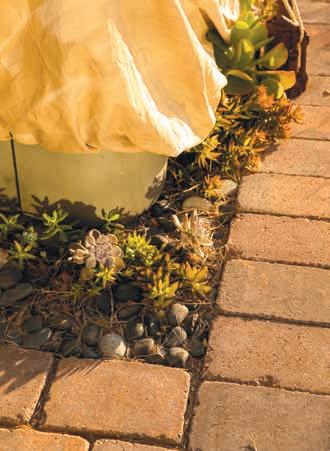
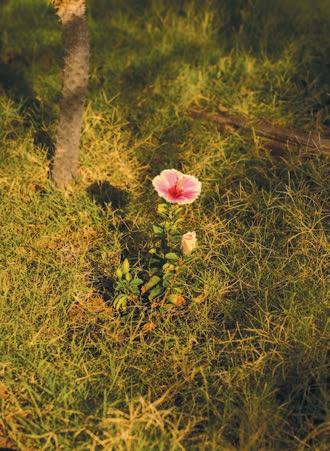

97



Choy is referring to the historic practice of DHHL transferring land to non-beneficiaries for commercial use to generate operating revenue for the department. Although the department is required by law to be adequately funded by the state, this has never happened. Since 1959, the State of Hawaiʻi has thwarted the success of DHHL by providing a fluctuating amount of inadequate funding each year, or in some years, no budget at all. On top of that, the state has fought DHHL in court, fought beneficiaries in court, and neglected to act on recommendations set forth in federal audits
such as developing a comprehensive Home Lands infrastructure development plan and providing a target date for proposing legislation to sufficiently fund the Home Lands program. The 1992 audit found 7 unresolved recommendations and only 1 implemented. Kailapa resident Donna Parker sums her feelings up clearly: “I feel like nobody gives a rip. They really don’t.”
waiwai for some Donna Parker lives on a ridge in Kailapa with an impressive view. From her lānai, the cobalt horizon meets the rugged
100 _ FLUXHAWAII.COM _ KAILAPA FEATURE
RESIDENT SHAWNA KAULUKUKUI BECAME PRESIDENT OF THE KAILAPA COMMUNITY ASSOCIATION IN 2022. SHE WANTS TO RAISE HER TWO SONS IN THE HOUSE HER FATHER BUILT IN KAILAPA.

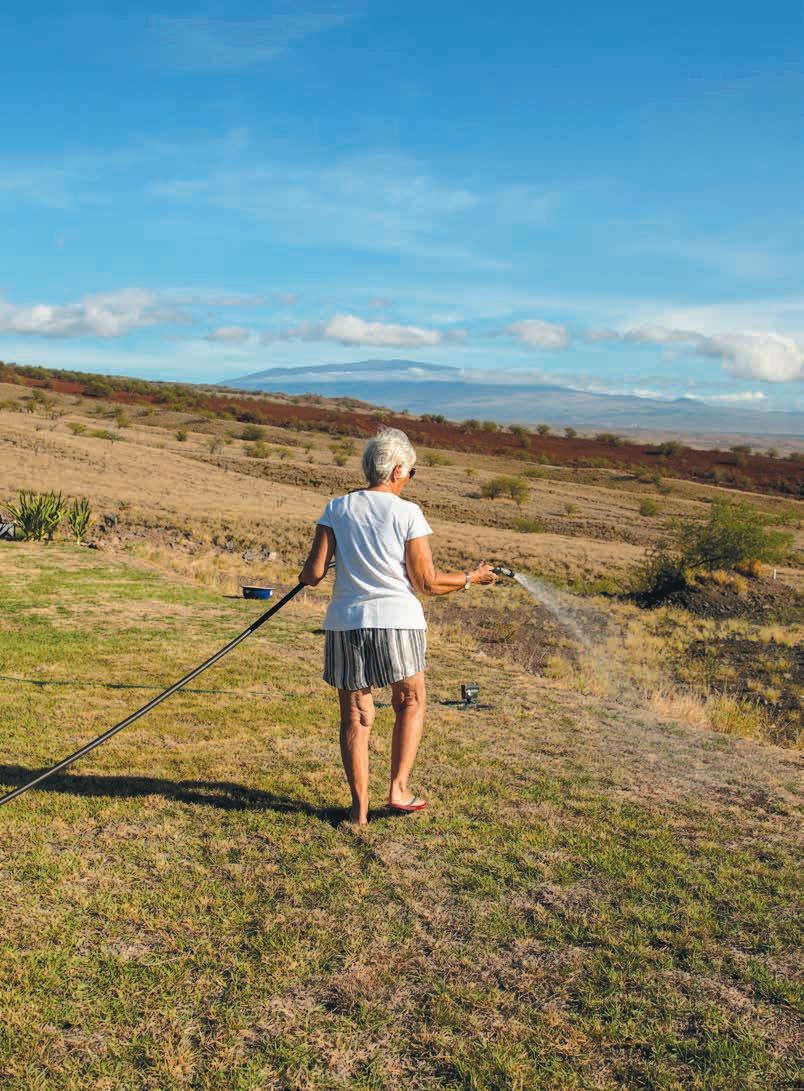
Kona-Kohala coastline and stretches up to the three massive mauna in the interior of the island. In the near distance, an out-of-place patchwork of vibrant green hugs what would naturally be arid kahakai leeward land. The lush landscaping of Mauna Kea Beach Hotel, the Westin Hapuna, and their associated collection of luxury resort homes is fed by water from the county water system. Unsurprisingly, this oasis comes with an “extremely high average water use,” according to the 2010 Hawaiʻi County Water Use and Development Plan, which “can likely be attributed to the large water users in the Mauna Kea Resort.”
As the resort delivers a carefully crafted and heavily irrigated version of Hawaiʻi, just down the road, Parker’s lawn tenuously hangs onto life. Parker loves her plants and still waters what she can, despite her high cost of water. At 83 years old, she has learned how to keep a positive attitude, despite the daily visual reminder of resource inequity. “I look out there at all the stuff down by the ocean, meaning all your hotels and all those God-blessed high makamaka homes, and then I look at my mauna,” she says, “and I look at the sky and look at the beautiful ocean and then think, ʻI'm blessed.’ If I don’t do that, I think I might go nuts. I don’t want to be grouchy all the time about stuff that doesn’t happen here.”
Sadly, history is repeating itself. In 1957, 100 Hawaiian Homes beneficiaries were unable to move onto unoccupied homestead land in Waimānalo. The Honolulu board of supervisors claimed there was not enough water for the development in its Suburban Water System while simultaneously providing water for an adjacent subdivision and approving the construction of a new one down the road. The newspaper Honolulu Record reported that “many are asking why … Harold Castle’s Kaneohe Ranch is getting ample water for its subdivisions and is planning more subdivisions with hundreds of homes.”
From the ʻio’s eye view, Kailapa is meant to accelerate Kānaka economic
self-sufficiency through the provision of land. But self-sufficiency will never be achieved when beneficiaries are being gouged with every turn of the faucet. DHHL is aware that the water crisis is negatively impacting its mission fulfillment. In 2014, DHHL published its Water Policy Plan with the vision of “adequate amounts of water and supporting infrastructure” across all homesteads so beneficiaries may return to ‘āina with the “self-sufficiency and self-determination” that HHCA intends. The water policy plan is well worded, but like President Eisenhower said: “Plans are worthless, but planning is everything.”
an intact ahupua‘a
In the early 1990s, a few homesteaders founded the Kailapa Community Association to begin planning the new community’s identity and direction. It became a nonprofit in 2010, and Kailapa resident Diane Makaʻala Kanealiʻi led its volunteer board of directors through the process of seeking grant awards to fund community visioning sessions. The sessions aimed to answer the question of how to thrive, not just survive, in Kalaniana‘ole’s vision of self-sufficiency.
What resulted was the 2019 Kailapa Community Resilience Plan titled “Ehuehu i Ka Pono – Thrive in Balance,” a co-created and tirelessly researched proposal for turning the ahupuaʻa into ʻāina momona. Speaking from her living room, Kanealiʻi remembers the excitement surrounding the visioning process.
“We had around 20 UH students that came to Kailapa, and they brought all of our community into my home. It was so windy that we couldn’t go outside, so we were packed like rats in here!” she says. “People showed up! A lot of our neighbors, especially the ones who have been here for a while. They wanted to see something happen.”
University of Hawaiʻi law students at Ka Huli Ao Center for Excellence in Native Hawaiian Law led the creation of what has become a roadmap for economic self-sufficiency, community cohesiveness focused on human interaction, and
the resourceful management of water and land. Kawaihae I is one of only two ahupuaʻa solely owned by DHHL. If this resilience plan were actualized, Kailapa would be a prototype of indigenous wisdom flourishing in a modern world. Kailapa would be a functioning 21st century ahupuaʻa, from the summit of Kohala to the sea.
A zoning map in “Ehuehu i ka Pono” reimagines all 10,153 acres of the DHHL Kawaihae land. The land is divided into traditional wao, or, biological resource zones, as well as more modern campuses. Kahiko and ʻauana ideas are blended seamlessly. Beans and grains grow along with kalo, and ʻuala, demonstrating how Hawaiian lifeways are not a romanticized past but a living continuum. There are pastoral parcels, solar farms, restored forests, hiking trails, salt pans, and fishing grounds. According to the report, “The goal is to reconnect the ahupuaʻa system, restoring forests where there were forests, replanting agriculture where there had been agriculture, and building a thriving community.”
This report is more place-based than DHHL’s 10-year plan for Kailapa from the early ’90s that never came to fruition. Unlike DHHL’s version, there are no golf courses or water-guzzling plants. But just like DHHL’s 1992 plan, nothing can happen without water.
the passing of the torch
Shawna Kaulukukui is raising her two sons in the house her father built in Kailapa. Only the two-laned Akoni-Pule highway separates her corner lot from the crashing waves.
“My dad built this house 15 years ago, and we would come here on the weekends,” she says. “This was like our getaway from home when we were younger.”
Kaulukukui grew up in Hilo and moved to Honolulu to pursue her career. After she had her first keiki, the busy urban Honolulu lifestyle had her reflecting on memories of a life more fully connected to her community, the sea, and her father. “My dad loved it over here. He loved the fishing, the weather, the people,” she
_ KAILAPA FEATURE 103
recalled. She returned to Kailapa in 2014 to raise her two sons the way she was raised, in a caring community and easygoing environment.
In 2022, Kaulukukui became president of the Kailapa Community Association. She gives her time, just like board presidents before her, to the pursuit of grant funding for community projects and initiatives. Just as it has always been, water is a top priority for the board. The year Kaulukukui took over, DHHL awarded the Kailapa Community Association a grant for $49,375 that the previous board sought for “research and feasibility to use a DHHL well and desalination treatment facility.” The board contracted Edward Halealoha Ayau of Halealoha Consulting Inc to execute the project, with the goal of showing DHHL that using an existing well with an additional water treatment facility is a feasible option. The grant delivery date is July 31, 2026. Kaulukukui and the board are trying to move things forward to meet that deadline.
It would seem that Kaulukukui and the rest of the association could benefit from paid support. But there is just one grant specialist in all of DHHL, and unfortunately, this person was on medical leave for most of 2023. Underfunded and understaffed, DHHL continues to struggle to make good on the promise of the HHCA. Putting the burden of planning on beneficiaries — many of whom work full time like Kaulukukui — means projects move along painfully slowly, or, as is the case of finding a new water source for the people of Kailapa, not at all.
finding water in a desert Kailapa community sits in a true desert. By nature, water will always be scarce in this community by the sea. The county
water system may be capable of transmitting water to Kailapa like it does the Mauna Kea Resort, but the system truncates a mile short of Kailapa. The County of Hawaiʻi Department of Water Supply is clear about the fact that extending the water system is neither its top priority nor, ultimately, its responsibility. DWS Manager-Chief Engineer Keith Okamoto told attendees at a July 2023 Waimea town hall meeting: “We are looking at other ways to extend our system along state highways across the bridge from Kawaihae side, but that is going to take a long time and is going to cost a lot of money. … We don’t have the funding resources to do what really, maybe, Hawaiian Homes really needs to take care of.”
That same 2015 water assessment study from DHHL confirms Okamoto’s fears. Extending the county water system across Honokoa Gulch would cost $18.5 million to $28.1 million. Even if DHHL could find the money, it would have to find a whole new source of water since, according to the study, “there is no available water source that is not already allocated to development.” Allocated to development, just not Kailapa’s development.
The sting of this statement is painful given the topography of the area. The fully allocated Waimea water originates from stream diversions in the “wet mountain regions of the Kohala Mountain forest reserve,” according to the 2010 Hawaiʻi County Water Use and Development Plan. This is the same forest reserve that abuts the mauka boundary of the DHHL Kawaihae property. The redirected Waimea water goes on a 12-mile, circuitous journey down the mountain, east and west through Waimea, down Kawaihae hill, and laterally across the coast where it finally stops short of Kailapa. The water is pumped 12 miles every
PREVIOUS PAGE, DONNA PARKER USES A HOSE TO WATER THE LAWN OUTSIDE HER PROPERTY. OPPOSITE, INSIDE THE KAULUKUKUI’S KITCHEN.
FEATURE 104 _ FLUXHAWAII.COM
_ KAILAPA


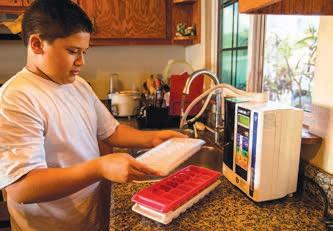
day, while Kailapa sits seven miles below the source.
reverse osmosis
Extending county water to Kailapa will not happen anytime soon, and piping water seven miles downhill from the intermittent Kahua ditch is too unreliable. The last option, which is desalination of its well water, is the most feasible solution. A prototype functions only five miles from the neighborhood.
In 2019, tech entrepreneur and former Reddit CEO Yishan Wong was looking to retire in Hawaiʻi when he drove past Kailapa on Akoni-Pule Highway. A few miles down the road, Wong stopped when he saw a for-sale sign. The 50-acre parcel had no power grid to connect to, but the property did come with a brackish water well and plenty of year-round sunshine. Years prior, Wong may have continued down the highway without a thought of purchasing the property, but a monumental shift had just taken place. Since 2019, the least expensive way to build a new energy grid has been with renewables — that year a new solar facility became 177 percent cheaper than a new power facility run on coal. With this data, Wong understood he could develop a 100 percent clean energy grid at an exceptionally reasonable cost. What he did not understand was that he could live out DHHL’s dream for Kānaka. He could build a kauhale for his ʻohana and raise his kids next to the ocean in Hawaiʻi.
Today, Wong has a reverse-osmosis water treatment facility run entirely on solar power on a property five miles away from Kailapa. With it, roughly 25,000 gallons of brackish water are pumped from the well, forced through membranes in a process called “reverse-osmosis,” and turned into fresh water that not only flows from
105
As a luxury resort delivers a carefully crafted and heavily irrigated version of Hawaiʻi, just down the road, a resident’s lawn tenuously hangs onto life.
the tap but also irrigates the native dry forest garden on the property. Because of the photovoltaics, this process also happens without burning any fossil fuel.
While Kohala Ranch Water Company pumps water using electricity that is the most expensive in the country and passes the cost burden onto DHHL consumers, Wong shows us that, perhaps, another way is possible. Cleaner photovoltaic energy can power pumps to desalinate and distribute water at cheaper rates. The question then becomes, who is responsible for seeing these solutions through to completion? If we look at history, the state seems to believe the kuleana falls on DHHL.
But, stretched thin and underfunded, DHHL has put the onus on its beneficiaries. The beneficiaries try their best to thrive in a messy situation inherited from the intentionally impaired HHCA. Since the overthrow of the Hawaiian kingdom, Kānaka Maoli have been tenacious in fighting for the bare minimum — the right to speak Hawaiian in public school, the end to military bombing of Kahoʻolawe, no jet fuel in drinking water. But it is time the state gives Hawaiians more than the bare minimum, and Kailapa could be a perfect opportunity. Kānaka deserve to run their own experiments with a significant amount of land.
After all, so much land in Hawai‘i has been lent to experiments. We know what happened when we experimented with planting thirsty sugarcane across Kohala and watered the fields via concrete stream diversion ditches; the sugar industry boomed then vanished, leaving fallow fields to catch fire in high winds on a heating planet. We know what happens when we experiment with allowing cattle to run across the forested slopes of volcanoes; watersheds shrink underhoof, taking harmonious native ecosystems with them. Native plants and native bodies are one in the same; Kānaka ancestors, family members, and kino lau are replaced by fire-prone monotypic stands of imported grasses. We know what happens when we experiment with allowing hotels and resorts to indiscriminately irrigate landscaping and golf courses dotted along the desert coastline; limited water is not allocated to infrastructure for more local housing solutions, leaving families across the island to subsidize the aesthetic appreciation of thousands of jet-lagged malihini.
We also know what happened when a group of the greatest sailors ever known launched from the shores of Tahiti 1,000 years ago in boats carved from trees and lashed together with plant fiber. They navigated to a group of islands, bounti-
ful with nonhuman communities, and learned how to live in ecological interdependence. The sailors fed hundreds of thousands of people for hundreds of years, retaining about 85 percent of the native forest cover while no money exchanged hands. This proven ʻāina usecase scenario is called the ahupuaʻa.
DHHL has only two intact ahupuaʻa in the catalog of land tossed its way in a legislated act of codified racism and corporate greed. One of these ahupuaʻa is Kawaihae I. Descendants of these magnificent sailors and land managers are asking to experiment with stewarding this ahupuaʻa in order to find out if socio-ecological harmony can happen once again. It’s unclear if this type of stewardship has been attempted at this scale in the last 250 years. We do not know what will happen. We do know what can happen if we don’t allow it. We have allowed others to use this land. We have seen the results. It is time the State of Hawaiʻi and the United States of America give the Kānaka ʻŌiwi of Kailapa the resources they are asking for so they may caretake their own land in their own way. Imagine what can happen. Ua mau ke ea o ka ‘āina i ka pono.
FEATURE 106 _ FLUXHAWAII.COM _ KAILAPA


108 IMAGE BY _ DAEJA FALLAS
SPECIAL SECTION: LAHAINA

gather anything from Kahiki, Lahaina has all the pleasantries necessary!] ” — Puuhanau “ Aohe hua kii i Kahiki, o Lahaina wale no ia walea ia! [There is no need to
acrylic on canvas Kihawahine,
To accompany this essay, Maui artist Aubrey Ke‘alohi Matsuura created a trio of paintings, exclusively for Flux, drawing on the mo’olelo of Lahaina, past and present.
He Lei No Ka Malu ʻUlu o Lele
IN THIS LEI DEDICATED TO THE COOLING ‘ULU OF LELE, THE STORIED APPELLATION FOR PRESENT-DAY LAHAINA, ONE WRITER DESCRIBES ITS MANY HISTORICAL MODES OF SHELTER, BUILT AND DEFENDED BY THE REGION’S MAKA‘ĀINANA.
TEXT BY ART BY
As early as I can remember, summer trips to Maui meant spending time with my Tūtūhine Gertrude Lilian Mahi, a famed lei-maker from Molokaʻi. Tūtū made a living through selling mākila lei at craft fairs, making feathered-style ribbon lei for Kamehameha Schools’ song contest, and as a preschool teacher. Even though she lived in Kahului, where rain leaked into metal pots during the Makahiki winter months, we often found ourselves at Lahaina Cannery Mall for craft fairs. I would play Pokémon on my Gameboy and she would share family moʻolelo in ʻōlelo Hawaiʻi about Lahaina. Tūtū sometimes mentioned her kāne, my great-grandfather, and plantation life in Lahaina. Once in a while we would run into my Nana, my great-grandmother on my Filipino side, Bentorada Domogma, who immigrated to Lahaina from the Philippines to w or k at the Royal Hawaiian Hotel and at Baldwin Packers picking pineapple. Those moments together in Lahaina are a prized lei of memories which string together moʻolelo passed down by generations of makaʻāinana who have frequented this area.
In an article published in Ke Au Okoa on June 22, 1871, Puuhanau of Puakō pro-
D. KAUWILA MAHI AUBREY KE‘ALOHI MATSUURA
vides an evocative description of the sights, people, and aesthetics of Lahaina. He recalls proverbs, place names, and stories of life in “ka Malu ʻUlu o Lele.” He transports readers mauka, where the Hauola wind begins to hug the mountains, calmly rustling the leaves on groves of lehua, kou, ʻulu, wauke, kukui, niu, and tall maiʻa. Then, Puuhanau takes us to the surf at ʻUo that breaks with a cloak of rainbows from the Līhau rain. ʻUo, meaning a group of feathers for a lei or cloak, is the name of a famed surf break in Lahaina, just outside of Mākila. He notes the many waters of Auwaiawao tumble ocean-bound, enriching the many bays of Lahaina. Puuhanau mentions how ʻōpelu and kawakawa poke is so abundant they feed rumbling stomachs until the jaw unhinges. Mākila, the Maui-specific term for stringing lei, aptly describes the way Puuhanau also threads a lei of moʻolelo using the names of peaks, mountains, and rains; he does so in a way that recognizes Lahaina’s unique geography, ahupuaʻa system, and engineered waterways.
The rich landscape made it easy for kō ʻIhikapalaumaewa (the people of Maui) to recognize Lahaina as a central seat of power. The residences at Mokuola and
_ FLUXHAWAII.COM FLUX _ LAHAINA _ HISTORY
110
All
2024
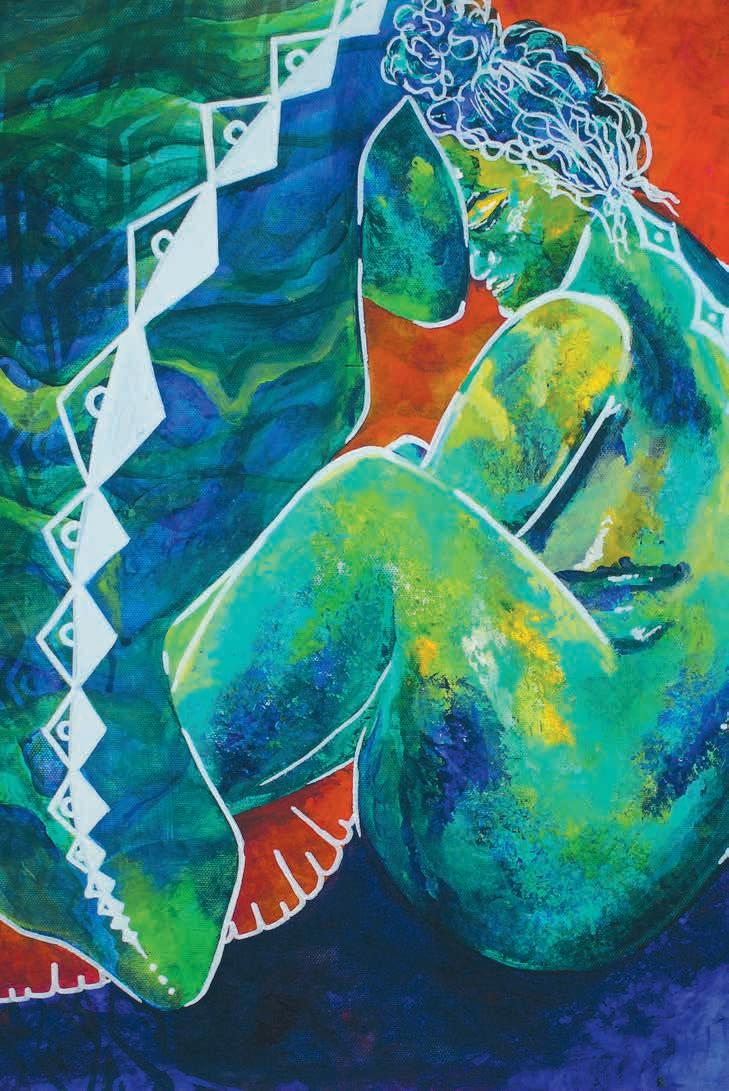



114 _ FLUXHAWAII.COM LAHAINA _ HISTORY
Mokuhinia housed generations of akua, aliʻi, and makaʻāinana who shaped the region into a model for other lands across the archipelago. This persisted into the reigns of Kamehameha II and Kamehameha III, who recognized Lahaina as the capital of kō Hawaiʻi Pae ʻĀina, a site to incite their lāhui, their nationhood. Lahaina’s makaʻāinana also participated in governance, not hesitating to contest their aliʻi when necessary. For example, renowned scholar and historian Davida Malo contested Kamehameha III for encroaching on his home by sending the kingdom an invoice for cutting off some of his water and stepping on his plants to
expand a new road. Likewise, ʻōlohe hula, ʻōlapa hula, and kumu hula of Lahaina often hosted performances and dedicated hula altars — a practice that endures to this day — despite a ban on public displays of hula as early as the 1830s.
Lele became a foundation of education within the kingdom in the early nineteenth-century. In the 1820s, Lahaina’s makaʻāinana quickly established 51 schools, where wāhine scholars initially outnumbered kāne until the early missionaries recognized a need for an institution of higher education to privilege young men of piety. In 1831, Kuhina Nui Kaʻahumanu contributed to establishing Lahainaluna Seminary by offering a portion of land to the American Board of Commissioners for Foreign Missions at Puʻunau. The seminary began in hale pili, thatched houses, which eventually became the home of the earliest printing press. Lahainaluna scholars immediately began printing newspaper series which offered insights about life in Lele and beyond to readers across Hawaiʻi. The people of Lele had undergone the intimate rigor of subsistence living which appear in countless newspaper articles stringing extensive accounts of daily life embellished with siteand season-specific names for winds and rains like feathers bound to storied lei. Lahaina’s model for education galvanized other aliʻi to offer their lands for the purpose of educating makaʻāinana across kō Hawaiʻi Pae ʻĀina.
Even after the feathered cloaks departed Lele for Honolulu and new industries came to Lahaina, the makaʻāinana continued to be the mākila. The best sugar cane in all of Hawaiʻi came from Lahaina. Kānaka ʻŌiwi found early success in the crop but by the 1860s industrialized sugar planting and processing changed the demographics of the region. Pioneer Mill established itself as a sugar plantation company, and quickly incorporated Lahaina Sugar Company and the West Maui Sugar Company. But the plantation oligarchy of America did not take hold in Hawaiʻi until the later portion of the 19th century because Kānaka ʻŌiwi had ancestral ties to ʻāina that predated Western notions of
property. Kānaka ʻŌiwi resisted working at sugar mills; instead, they owned grocery stores, farms, clothing stores, and liquor houses in the bustling town. Other Kānaka in Lahaina found themselves selling off portions of their loʻi and other ancestral lands to survive; some even became whalers or gold miners abroad. Pioneer Mill’s need for a workforce led to imported labor from other nations such as China, Japan, Korea, Okinawa, Puerto Rico, Philippines, and Portugal.
Puuhanau would have seen first hand the political and agricultural changes of Lele over the course of his life. Yet, he completes his lei with a proud expression for Lahaina. He exclaims that Lahaina cannot compare to Kahiki, “Aohe hua kii i Kahiki, o Lahaina wale no ia walea ia! [There is no need to gather anything from Kahiki, Lahaina has all the pleasantries necessary!]” Here, Kahiki symbolizes all matters foreign: foreign ideologies, foreign land tenure systems, foreign foods, foreign language, and foreign pleasures. By asserting the abundance of Lahaina’s pleasantries, Puuhanau employs the tradition of ʻauʻa-refusal to all adventitious ways of thinking and being. The people of Ka Malu ʻUlu o Lele activated lāhui where they saw fit, unfailing in reminding others of their authority over their beloved home. The deep love for ʻāina and lāhui that the people of Ka Malu ʻUlu o Lele have consistently shown is the cooling shade that provides relief from the undulating heat of Lahaina. Stories of life in Ka Malu ʻUlu o Lele is a lei strung together over generations of ancestral resistance and tidalectics, an oceanic worldview that acknowledges the natural ebb and flow of our existence. In this current moment, the people of Lahaina maintain their love of their homeland, making clear that they will stay to fight against land and water theft, climate catastrophes, and uncivil government agents. Makaʻāinana of Lahaina remain steadfast lei-makers, stringing moʻolelo from Ka Malu ʻUlu o Lele from the past into the present and planting seeds of ʻulu to ensure sovereignty for future generations of our lāhui. If that isn’t nationhood, then what is?
115
Left ‘Uo, 2024
Previous spread
Malu ‘Ulu o Lele, 2024
Voices in the Dark
FROM GRASSROOTS SUPPORT TO COORDINATED EFFORTS, MAUI’S FILIPINO COMMUNITY HAS FOUND ITS FOOTING IN THE AFTERMATH OF THE DEVASTATING LAHAINA FIRE, AND THEY ARE ASKING THEIR GOVERNMENT TO DO BETTER.
TEXT BY IMAGES BY VIOLA GASKELL
JOSHUA GALINATO
SAVANNAH GLASGOW
On the morning of August 8, 2023, Jerome Menesses was supposed to start his new job as a teacher at Lahaina Intermediate School. Instead, the 30-year-old awoke to an email that said school had been canceled and the sight of smoke billowing from the mountainside. He and his wife, a teacher at Princess Nāhiʻenaʻena Elementary, had moved to Lahaina from the Philippines three weeks earlier as part of a cultural exchange program that allows Filipino educators to teach in the United States for up to five years. With no power and no internet, they played cards and kept an eye on the encroaching fire. Their landlord, a Filipina woman who moved to Lahaina decades ago, said that if they needed to evacuate, firefighters or police officers would notify them. But as the fire moved closer, no one came, and they received no alerts. Suddenly the blaze was just a few houses away. They packed a small bag, their passports and IDs, ran to their landlord in a small car, and escaped the flames on a little-used backroad. “Everything we had, it’s all turned into ashes,” Menesses says. “I don’t know if we’d be here if not for our landlord.”
The fire that Menesses and his wife narrowly survived was the deadliest in the U.S. in the last century, killing 100 people, a quarter of whom had ties to the Philippines, according to the state’s Philippine Consulate General. The flames destroyed more than 2,000 buildings, most of them residential homes. Downtown Lahaina, the historic whaling town that was once the seat of the Hawaiian Kingdom, burned to the ground.
Filipinos are strongly represented in Lahaina. Around 40 percent of the town’s residents, which numbered around 13,000 prior to the fire, were Filipino. Many are third- or fourth-generation

116
FLUX _ LAHAINA
_ RELIEF _ FLUXHAWAII.COM



THIRD-GENERATION LAHAINA RESIDENT KRIZHNA BAYUDAN, HERSELF DISPLACED BY THE WILDFIRE, STARTED HELPING WITH RECOVERY EFFORTS IN THE DISASTER’S IMMEDIATE AFTERMATH.
locals, descendants of plantation workers who farmed sugarcane in West Maui. But today, one in three Lahaina residents are recent immigrants, which has only further complicated the town’s already fraught road to recovery.
In the weeks after the fire, as national relief organizations and politicians — President Joe Biden, Governor Josh Green, congresspeople, state representatives — flew in to Lahaina to assess the damage, national and local news stories lamented the absence of a prominent Filipino voice. Nestor Ugale, the founder of nonprofit Kaibigan ng Lahaina (which means “Friends of Lahaina” in Tagalog) says he suspects the initial lack of representation was in part because of the unprecedented nature of the loss: communication was out for days, people were in shock and didn’t know who to trust. “Where were our Filipino resources in the beginning?” asks Ugale, who formed Kaibigan ng Lahaina after the fire to connect the area’s more established population with newer Filipino immigrants who have less government and family support. “This part of the community was severely impacted, and they were in trauma mode.”
In late September, the Maui Filipino Chamber of Commerce and their O‘ahu counterpart put on a resource fair at the Lahaina Civic Center that drew around 2,750 people. Kit Zulueta Furukawa, the MFCC director, and her team partnered with local Filipino businesses to give away sorely needed basics such as soap and clothing, along with familiar snacks
like Ligo sardines and Vcut potato chips, fresh vegetables from Aloha Harvest, and malunggay (moringa) and avocados picked from volunteers’ yards. The fair was called Hawak Kamay (Tagalog for “holding hands”), the first in a series of events that brought the island’s Filipino population together to access resources from federal agencies. “It also brought familiarity and language,” Furukawa says, “not just spoken language, but the languages of care and comfort.” The center was filled with the sounds of Ilokano and Tagalog, with clergy, doctors, lawyers, barbers, and massage therapists tending to the needs of the survivors. Fresh orchids donated by a Maui farmer brightened the space and lifted spirits especially for the “manang,” Furukawa says, an endearing Ilokano term akin to auntie. Lahaina chef Joey Macadangdang donated 1,000 adobo and pancit bentos. Meanwhile, Honolulu-based nonprofit Tagnawa and its fiscal sponsor, Hawai‘i Workers Center, gathered Ilokano and Tagalog speakers from around the community and from University of Hawaiʻi at Mānoa to offer translation services. Nadine Ortega, an Ilokano instructor at the university who created Tagnawa in response to the fire, and a team of volunteers carried out the only on-the-ground Filipino-specific needs assessment, reaching more than 800 displaced families. Most urgently, these survivors needed financial assistance, housing, and communication in their mother tongue. Tagnawa found that approximately 75 percent of Filipino families in need of assistance included
_ RELIEF _ LAHAINA 119
At Lahaina Civic Center, the fair was filled with the sounds of Ilokano and Tagalog, with clergy, doctors, lawyers, barbers, and massage therapists tending to the needs of the survivors.
elderly people, some of whom had been denied funding because they lived in multigenerational homes and only the head of household was eligible. Some interviewees were new arrivals who, in addition to being ineligible for federal funds, did not have a bank account set up to receive private donations. Others had received abrupt hotel eviction notices in languages they could not read. “All of this compounds,” Ortega says. Citizenship status, elderly parents, two or more children in the household, language barriers — “[that all] made it particularly difficult for the Filipino community.”
In Filipino circles, Ortega says, people are more open to addressing mental health collectively, as opposed to Westernized one-on-one therapy sessions. “Talking with these groups right after the fire, they would reject concerns about mental health,” Ortega says. “But, we could see the effects of the fires and the trauma in their tears and in their stories about what happened to them, who they lost, their homes, their old lives.”
Tagnawa is slated to receive a $150,000 Hawai‘i Community Foundation grant, that will help the organization further its Filipino values-based support system centered on the matriarchal and collectivist spirit of Filipino culture that allows people to tell their stories in Tagalog and Ilokano to
a group that understands their grief.
So far, Federal Emergency Management Agency and the U.S. Small Business Administration have doled out $300 million in direct assistance to date, but those without a green card are ineligible for federal assistance. This includes Menesses, despite his being employed by the Hawaiʻi State Department of Education. The Filipino community and the greater Maui ʻohana helped Menesses and his wife find a place to stay and gave them gift cards, food stamps, clothes, hot meals, and emotional support. Despite the difficulties and financial hardship — including an outstanding $13,000 loan Menesses and his wife attained just to come to the U.S. — that have colored their experience so far, he says they want to stay. He and his wife have been teaching Lahaina students since their schools partially reopened in nearby churches, before returning to campus. “We love Lahaina and we really love the kids, so we can’t leave here,” he says. “They really need us.”
Third-generation Lahaina resident Krizhna Bayudan started helping with recovery efforts in the fire’s immediate aftermath, from translating for Ilokano speakers to helping displaced people fill out aid forms. When Hawai‘i Workers Center offered her a full time job as a community organizer, she put her grad school plans
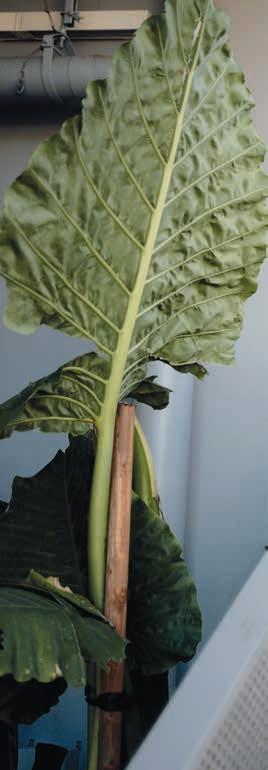
KIT ZULUETA FURUKAWA AND HER TEAM PARTNERED WITH LOCAL FILIPINO BUSINESSES TO CREATE HAWAK KAMAY, THE FIRST IN A SERIES OF EVENTS HELPING AFFECTED FILIPINOS ACCESS RESOURCES FROM FEDERAL AGENCIES.
120 _ FLUXHAWAII.COM
_ RELIEF LAHAINA
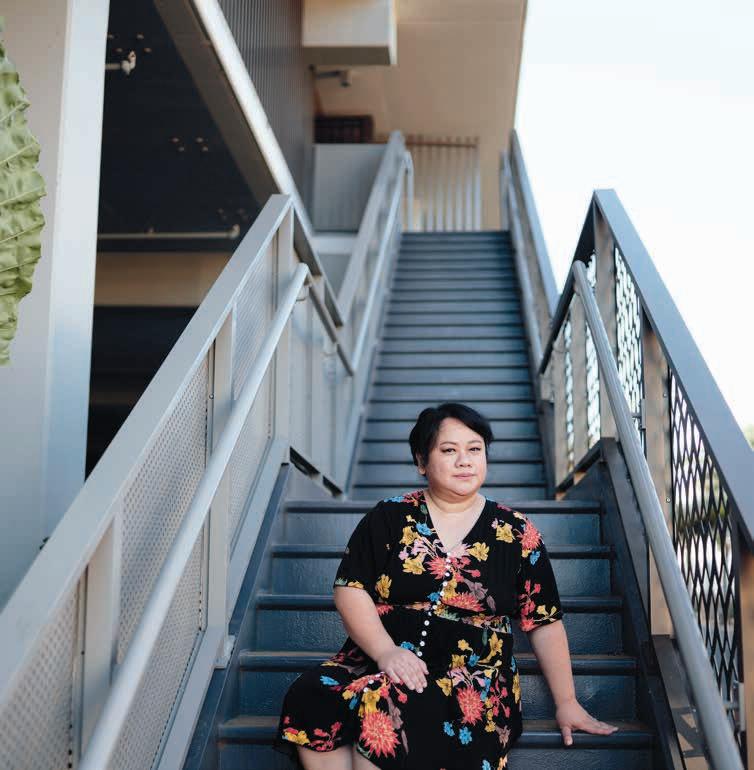
on hold in order to help attain dignified housing for affected residents, including those who had been pressured into paying rent on houses that had burned down or become unlivable after the fire.
Bayudan herself has moved four times since the fire, which claimed her family’s recently renovated family home in Wahikuli, where she lived along with her two
sisters, parents, and a few renters. “Being a part of a neighborhood like Wahikuli was a blessing,” she says, recalling the array of fruits and vegetables popular in Filipino cooking that her grandparents had planted on the property: bitter melon and eggplant, banana and calamansi. They lived only a few minutes from their cousins, and the palm tree-lined highway between their
121

street and the horizon gave way to a mesmerizing Hawaiʻi sunset most nights. But Bayudan has had little time to reminisce. She worries if Honua Kai’s impending notice to vacate will be extended by the Red Cross, even though it had already been extended four times. Bayudan says that in order for Filipinos and the greater Lahaina community to recover they need access to dignified housing. “We all really do just need a home, somewhere we can feel safe and comfortable and not have to live at the mercy of our condo owners,” she says. “I am extremely grateful we have a place to stay, but it’s nothing compared to what we lost.”
In December, four months after the fire, around 6,200 people were still displaced. Many remained in temporary housing in hotels and overpriced vacation rentals or doubled up in family homes elsewhere on Maui. In the days after the fire,
Lahaina residents voiced fears that people would leave and forever alter their communities, making way for new, wealthier residents and more tourist accommodations in Lahaina’s future. The Council for Native Hawaiian Advancement estimates that 1,000 people have already moved off island. Ugale, who was born and raised within Lahaina’s multigenerational Filipino enclave, says people have been leaving “in droves” for places like Nevada, where their insurance payouts will stretch further. “Every week I hear of this person, that person, this family member, making a decision and then they’re gone, so suddenly,” he says.
Despite so much uncertainty, Ugale says people are doing what they can to recover emotionally and spiritually through sharing food and prayer. The white crosses along the Lahaina Bypass represent the lives lost, a lot of them of Filipino ancestry.
OPPOSITE: ABOVE, NADINE ORTEGA, AN ILOKANO INSTRUCTOR WHO CREATED TAGNAWA IN RESPONSE TO THE FIRE. BELOW, A GRASSROOTS COMMUNITY RESOURCE HUB RUN BY VOLUNTEERS IN WEST MAUI.
“We still need to grieve those losses together,” Ugale says. He and other local leaders are working with County officials to coordinate a community-wide viewing of Lahaina town in its devastated state before all of the rubble is cleared. The plan: An escorted drive by bus through what remains of Lahaina, he says, “to get closure and say a final goodbye to the town we love.”
122 _ FLUXHAWAII.COM LAHAINA _ RELIEF

The People Versus The West Maui Developer
CONTROVERSIAL DEVELOPER PETER MARTIN SPENT DECADES
GUZZLING WATER AROUND LAHAINA. THEN CAME THE FIRE.
TEXT
BY IMAGES BY INFOGRAPHICS BY
Just weeks after the deadliest wildfire in modern U.S. history ripped through the coastal town of Lahaina, Native Hawaiian taro farmers, environmentalists, and othe r residents of West Maui crowded into a narrow conference room in Honolulu for a state water commission hearing.
The chorus of criticism was emotional and persistent. For nearly 12 hours, scores of people urged commissioners to reinstate an official who had been key to strengthening water regulations and to resist corporate pressure to weaken those regulations. One after another, they calmly and deliberately delivered scathing criti-
cism of a developer named Peter Martin, calling him “the face of evil in Lahaina” and “public enemy number one.”
One person summed up the mood of the room when he said, “F— Peter Martin.”
More than 100 miles away on Maui, Martin followed parts of the hearing through a livestream on YouTube. Despite the deluge of criticism, he wasn’t upset. He wasn’t even surprised. After nearly 50 years as a developer on Maui, he’s used to public criticism.
“When you’re around a gang of people, a mob, the commissioners just listen to the mob, they don’t listen to reasoned voices,” Martin told Grist. “I’m not comparing these people to Hitler; I’m just saying Hitler got people involved by hating, hating the Jews.”
Martin, who is 76, has long been controversial. He moved to Maui from California in 1971 and got his start picking pineapples, teaching high school math, and waiting tables. Before long, he began investing in real estate. His timing was perfect: Hawaiʻi had become a state just 12 years earlier, and Maui’s housing market was booming as Americans from the mainland flocked there. By 1978, local headlines
ANITA HOFSCHNEIDER & JAKE BITTLE, GRIST
CORY LUM, GRIST
DAEJA FALLAS, FLUX
CLAYTON ALDREN, CAMILLE FASSETT, CALEB DIEHL, GRIST

OPPOSITE, PETER MARTIN POINTS TO WHERE HE HOPES TO BUILD HOMES ON A WEST MAUI MAP. IMAGE BY CORY LUM. ABOVE, KALO FROM THE LO‘I OF DANIEL PALAKIKO. IMAGE BY DAEJA FALLAS.
124 FLUX _ LAHAINA _ WATER RIGHTS
_ FLUXHAWAII.COM

were bemoaning the high price of housing, and prices only went up from there.
Over the last five decades, Martin has made millions of dollars of f this real estate boom, building a development empire on West Maui and turning hundreds of acres of plantation land into a paradise of palatial homes and swimming pools. He owns or holds interest in nearly three dozen companies that touch almost every aspect of the homebuilding process: companies that buy vacant land, companies that submit development plans to local governments, companies that build houses, and companies that sell water to residents. His real estate brokerage helps find buyers for homes built on his land, and he’s even got a company that builds swimming pools.
Companies associated with Martin own more than 5,500 acres of land around Lahaina, according to an analysis of county records, making him one of the area’s largest private landowners, and his web of businesses wields immense influence in West Maui, which is home to about 25,000 people. He drives his white Ford F-150 around the island with a large, black Bible on the center dashboard and peppers his conversations and emails with quotes from Scripture or libertarian economist Milton Friedman. He once served on the Maui County salary commission, where he helped determine pay for elected officials and county department heads, and he has donated $1.3 million to the Grassroot Institute of Hawaii, a libertarian think tank that has fought Native Hawaiian sovereignty. So extensive is the reach of his land empire that the command center for the response to the August wildfires is located on land owned by a company in which he has a stake.
Development on Maui, where the median home price now exceeds $1 million, often sparks controversy, and Martin is far from the only builder who has inspired opposition. But his staunch ideological commitment to free market capitalism and Christianity, coupled with his companies’ persistent pushback against water regulations intended to protect Native Hawaiian rights, has evoked particularly passionate distaste among many locals.
“F— the Peter Martin types,” reads one bumper sticker spotted in Lahaina.
And that was before the wildfire. Just two days after the outbreak of a blaze that would go on to kill 100 people, fueled in part by invasive grasses on Martin’s vacant land, an executive at one of Martin’s companies sent a letter to the state water commission. Glenn Tremble, who works for West Maui Land Company, wrote that the company’s request to fill its reservoirs on the day of the fire had been delayed by the state. He also asked the commission to loosen water regulations during the fire recovery.
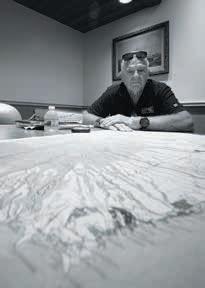
“We anxiously awaited the morning knowing that we could have made more water available to [the Maui Fire Department] if our request had been immediately approved,” he wrote.
Tremble’s letter implied that a state official key to implementing local water regulations — and the first Native Hawaiian to lead the state water commission had impeded firefighting efforts. He soon walked back the claim, but his first letter had immediate effect. The state attorney general launched an investigation into the official, the governor suspended water regulations, and the official was temporarily reassigned. Critics saw it as
an attempt to capitalize on the grief of the community for profit.
It didn’t help that within weeks, when the Washington Post asked about the role the invasive grasses on Martin’s land played in the deadly wildfire, Martin said he believed the fire was the result of God’s anger over the state water restrictions.
Most people in West Maui get water from the county’s public water system. But Martin-built developments such as Launiupoko, a community of a few hundred large homes outside of Lahaina, draw their water from three private utility systems that he controls, siphoning underground aquifers and mountain streams to fill swimming pools and irrigate lawns. More than half of all water used in the Launiupoko subdivision, or around 1.5 million gallons a day, goes toward cosmetic landscaping on lawns, according to state estimates. Just over a quarter is used for drinking and cooking.
The scale of this water usage is stunning: According to state data, Launiupoko Irrigation Company and Launiupoko Water Company deliver a combined average of 5,750 gallons of water daily to each residential customer in Launiupoko, or almost 20 times as much as the average American home. The development has just a few hundred residents, but it uses almost half as much water as the public water system in Lahaina, which serves 18,000 customers.
Martin says he didn’t set out to make Launiupoko a luxury development, but that its value spiked after Maui County imposed rules that limited large-scale residential development on agricultural land. Martin’s development was grandfathered in under those restrictions, and demand for large homes drove up prices in the area. He says criticism of swimming pools and landscaped driveways is rooted in envy.
“People come over and make their land beautiful by using water,” he said.
Martin also maintains that there’s more than enough water for everyone, but that doesn’t seem to be the case. Annual precipitation around Lahaina declined by about 10 percent between 1990 and 2009, drying
126 _ FLUXHAWAII.COM _ WATER RIGHTS LAHAINA
PETER MARTIN, OF WEST MAUI LAND COMPANY. IMAGE BY CORY LUM.
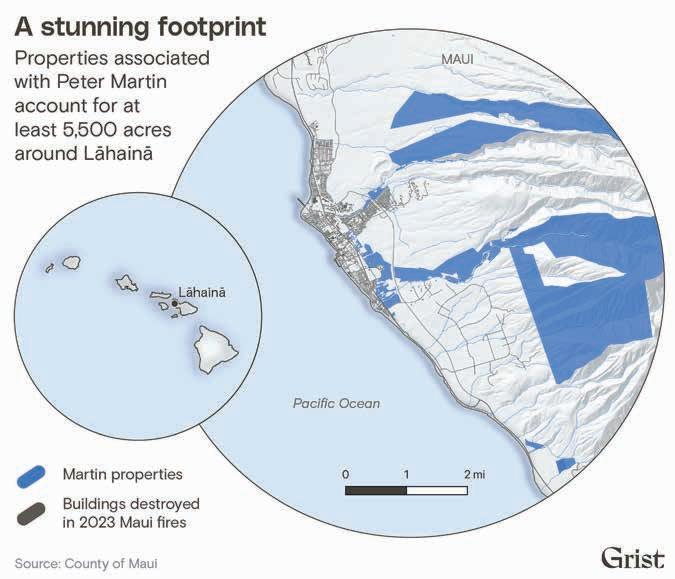
out the streams near Launiupoko, and now Martin sometimes can’t provide water to all his customers during dry periods. The underground aquifer in the area is also oversubscribed, according to state data, with Martin’s companies and other users pumping out 10 percent more groundwater than flows in each year on average. Climate change could exacerbate this shortage by worsening droughts along Maui’s coast: Projections from 2014 show that annual rainfall could decline by around 15 percent over the coming century under even a moderate scenario for global warming.
In response, the state water commission has intervened to stop Martin and other developers from overtapping West Maui’s
water, setting strict limits on water diversion and fining his companies for violating those rules. Last year, the state took full control of the region’s water, potentially jeopardizing the future of Martin’s luxury subdivisions and making it harder for him to build more in the area.
Now, though, Martin is poised to play a key role as West Maui recovers from the Lahaina wildfire, which destroyed 2,200 structures, including six housing units Martin had developed. Nine of his employees lost their homes. As of early November, more than 6,800 displaced people on Maui remained in hotels or other temporary lodging. Millions of dollars in federal funds are expected to flow
into the state for reconstruction. Martin, with his dozens of development companies and thousands of acres of vacant land, is perfectly positioned to build new homes. And his concerns about water regulations slowing development may find a more sympathetic audience as local officials seek to address a post-fire housing crisis.
Moreover, he is itching to build. Before the fire, county and state officials were shooting down most of his new building proposals amid a concern about overdevelopment, even the ones that Martin pitched as affordable workforce housing. Martin thinks he can mitigate West Maui’s fire risk and its housing crisis by
127

getting rid of the barriers that prevent developers like himself from building more houses with irrigated farms and green lawns.
“What I just want is the water to be able to be used on the land, which God intended it to,” he said.
Daniel Kuʻuleialoha Palakiko doesn’t know what deity Martin is referring to.
“Ke Akua is a God of love and restoration and abundant life,” he told the water commission during September’s hearing, using the Hawaiian word for God. Palakiko had flown to Honolulu with many other Maui residents to
urge the state officials to uphold their responsibility to protect water.
Palakiko doesn’t take his land, or water, for granted. He was a teenager in Lahaina in the 1980s when his family started getting priced out by rising rents. That’s when his dad remembered that his own father had once shown him the family’s ancestral land in nearby Kauʻula Valley. According to Palakiko’s grandfather, the family had been forced out by the Pioneer Mill sugar plantation, which had diverted the Palakikos’ water to irrigate crops. Palakiko’s family still owned the title to the land, and his father was determined to find a way to reclaim it.
First they cleared brush by cutting firebreaks and burning the overgrowth,
controlling the flames with five-gallon buckets of water hauled from a nearby river. Once they had opened enough land to build a house, the Palakikos worked out a deal with Pioneer Mill to restore free water access to their property, connecting their home to the plantation’s water system with a series of 1½-inch plastic pipes.
Access to that water meant that the Palakikos could live on their ancestral land for the first time in generations. Back then, Palakiko says, their property felt isolated from Lahaina, accessible only by old cane field roads that could take 45 minutes to reach town. But the family didn’t mind. It was enough to be able to stay on Maui when so many other Native
128 _ FLUXHAWAII.COM
Hawaiians were forced by economic necessity to leave.
That isolation didn’t last. In 1999, Pioneer Mill harvested its last sugar crop, ending 138 years of cultivation in Lahaina. The abandoned fields turned brown and Palakiko heard that the company was selling off thousands of acres. Where once the Palakikos had seen Filipino plantation workers tending to crops, they noticed fair-skinned strangers and surveyors exploring the fallow grounds.
The Palakikos soon realized that the land was now in the hands of Peter Martin, who had joined other local investors to buy everything he could of the old plantation land. These new owners soon subdivided the land and sold parcels at ever higher prices as demand for the area known as Launiupoko kept increasing. It didn’t matter that the area was zoned for agriculture: Like many other developers, Martin took advantage of a legal provision that allowed homeowners to build luxurious estates on such land as long as they did some token farming of crops like fruit or flowers, no matter how perfunctory it might be.
By the time Martin finished the development, which included around 400 homes on around 1,000 acres, he was diverting almost 4 million gallons from the stream every day, according to state data, almost as much as the 4.8 million gallons Pioneer Mill had diverted each day before it shut down.
Some days the Palakiko family would wake up to find no water running through the pipes. By the afternoon, puddles along the stream would evaporate and fish would flop on the hot rocks, suffocating. It wasn’t just the Palakikos who were suffering, but the whole river system: As Martin diverted water from the mountains, the waterway dried up farther downstream, threatening the native fish and shrimp that lived in it. Palakiko appealed to Martin’s new water utility, Launiupoko Irrigation Company, but he said the company was hostile. First it tried to shut off the water the family had been receiving through plastic pipes, then asked the family to pay for water they’d always drawn for free, only relenting after the Palakikos fought back.
In addition to diverting water away from Native Hawaiian families, Martin has tried to force some from their land. In 2002, his Makila Land Company filed a so-called “quiet title” case against the Kapus, another farming family whose land borders the Palakikos, seeking to claim a portion of the family’s ancestral land as its own. This legal strategy, which allows landowners to take control of properties that may have multiple ownership claims, later gained notoriety when Mark Zuckerberg used it to consolidate his holdings on Kauaʻi.
When the Kapus fought back, the company kept them in court for almost two decades, appealing over and over to gain the rights to a 3.4-acre parcel. The situation between Martin and the Kapu family became so tense that in 2020, Martin sought a restraining order against one member of the family, Keeaumoku Kapu, accusing him of “verbally attack[ing] me with an expletive-laced tirade” and blocking Martin’s access to the disputed land. The court imposed a mutual injunction against Martin and Kapu later that year; two years later, Kapu finally prevailed in court and secured the title to his property.
Martin’s companies filed multiple quiet-title lawsuits over the years as Martin sought to consolidate control of the land around Launiupoko. Just after it began litigation against the Kapus, Makila Land Company made a similar claim against a neighboring taro farmer named John Aquino, seeking to seize a portion of the land belonging to Aquino’s family. The company won the slice of land in an appellate court in 2013, but the Aquino family stayed put. Police arrested Aquino in 2020 after two of Martin’s employees drove a semi onto the land; Aquino had smashed the truck’s windows with a baseball bat. Makila later filed a trespassing lawsuit in 2021 against Brandon and Tiara Ueki, who also live near the Kapus. The parties agreed to dismiss the case the following year after an apparent settlement. More recently, Martin has fanned even more frustration by selling properties with contested titles, prompting at least one ongoing legal battle.
Meanwhile, Martin and his fellow investors sought to expand to other parts of West Maui with several large-scale developments in areas along the coastline. In one instance, he and another pair of developers named Bill Frampton and Dave Ward proposed building 1,500 homes, including both single and multifamily housing units, in the small beachfront town of Olowalu, even though water access in the area is minimal and rainfall is declining. The developers later scrapped the project following protests from environmental activists, but in the meantime, Martin sold off a few dozen more lots in Olowalu, where he has a home. He also created another utility, Olowalu Water Company, to supply homes in the area with stream water.
Hawaiʻi, like most of the Western United States, allocates water using a “rights” system: A person or company can own the right to draw from a given water source, often on land they own, but they can’t own the water source itself. In states like Oregon and Arizona, this system has led to conflicts between settlers and tribal nations, but in Hawaiʻi the law provides explicit protection for Native Hawaiian users. State law stipulates that traditional and cultural uses, such as taro farming, “shall not be abridged or denied.” In times of shortage, Native users have the highest priority.
In 2018, the state water commission imposed so-called “flow standards” on several West Maui streams, capping the amount of water that Launiupoko Irrigation Company and Olowalu Water Company could divert at any given time. Palakiko had mixed feelings about this: He didn’t want to cede more control over the water that his family had used for generations, but it felt necessary in order to ensure someone could hold the companies accountable.
Even after these rules took effect, though, Martin’s water utility companies violated them dozens of times. When the state threatened to fine the companies, Launiupoko Irrigation Company stopped taking water from its stream completely. Residents of the lush Launiupoko subdivision soon had to ration irrigation water, and the Palakikos lost their access altogether. Their pipes stayed dry for more than a week
_ WATER RIGHTS LAHAINA 129
until a judge ordered Martin’s company to turn on the tap back on.
As the state cracked down on stream diversions, Martin sought to secure more water by tapping an aquifer beneath Lahaina. Here again, he was accused of infringing on Native Hawaian cultural resources: When his West Maui Construction Company started digging a ditch for a water line in 2020, it excavated an area that contained Native Hawaiian burial remains, triggering protests. Five Native Hawaiian women activists climbed into the company’s ditch to stop the construction project and were arrested. A judge later found the company broke the law by starting construction on the water line without all the requisite permits.
The new restrictions started to hamper Martin’s development activities. Last year, his Launiupoko Water Company applied to the state’s utility regulator for permission to deliver water to a new area near Lahaina. The company said it had agreed to supply a nearby landowner with potable water for 11 new homes, and told the state it needed to increase its groundwater pumping by at least 65,000 gallons per day. The regulator rejected the expansion plan, saying the company had omitted “basic information” about where it would get this new water. The landowner that would have received the water was another company in which Martin has an ownership stake.
Even as his companies’ plans faced headwinds, Martin continued to benefit. He loaned Launiupoko Irrigation Company a total of $9 million in recent years as the company tried to expand its Lahaina well system, charging 8 percent interest. The company tried in 2021 to secure a bank loan for the project, but three banks turned it down, with one noting that the company’s “interest payments to Pete” were “substantial.”
Glenn Tremble, a top executive at West Maui Land Company, the company at the center of Martin’s development empire, said in response to a list of questions that Grist’s statements were “generally false and often libelous.” Tremble noted that Martin has built affordable
housing units on West Maui and donated to churches. He said that Martin is “well positioned to assist with recovery and efforts to rebuild.”
If Martin’s track record with water and land made him infamous in Lahaina, it also invigorated local support for even stricter water controls. Palakiko’s long campaign for more attention to the region’s water problems finally bore fruit last year when the state designated West Maui as a “water management area.” Instead of just setting limits on how much water Martin’s companies could take from West Maui streams at any given time, the state water commission announced that it would revamp the area’s entire water system, giving highest priority to Indigenous cultural uses like taro farming. That may mean limiting access for Martin’s luxury developments, though Tremble disputes this.
“We’ve heard a lot from the community about the development of West Maui Land’s holdings in Launiupoko,” said Dean Uyeno, the interim chair of the state water commission, about the decision. “To continue building in these types of ways is going to keep taxing the resource.” The question, Uyeno said, is whether developers “can … find a way to [be] building more responsible development that balances the resources we have.”
Martin thinks the argument that water is a scarce resource is a “red herring.” He argues that the market is calling for more housing, not more water for native fish that rely on the streams.
“All the people [who] ever come to me say, ‘Peter, can you get me a house? I want a place to live,’” he said. “They don’t go, ‘Oh, I wish I had [shrimp] for dinner.’ That’s not what people tell me. They say, ‘Can’t you give me some house, some land?’ I go, ‘I’d love to but the government won’t let me.’”
water usage and seeking more, in accordance with the state’s revamp of the area’s water system. They submitted the applications just days before the state’s August 7 deadline. The day after the deadline, Lahaina burned.
To Martin, this is not a coincidence. He believes the state water commission’s efforts to more strictly regulate water enabled the fire by preventing more construction of homes with irrigated lawns — in other words, more development would have made West Maui more resilient to fire. The day before the water commissioners met in September, he wondered if the commissioners would acknowledge their responsibility for the wildfire deaths and regretted not pushing harder against their restrictions.
“I feel I actually have blood on my hands because I didn’t fight hard enough,” he said.
There’s no evidence that the state management rules, which are still in the process of going into effect, had any bearing on the fire. When Grist relayed this argument to the interim leader of the state’s water commission, he was stunned.
“That actually leaves me speechless,” said Uyeno. “I don’t know how to respond to that.”
Palakiko and his family spent the day of the fire watching the smoke rising from the coastline, watering the grass on their property and praying the winds wouldn’t shift, sending the flames their way. Five years earlier, another fire fueled by a passing hurricane had burned down two homes on their land.
That day, their prayers were answered. But when Palakiko’s son, a firefighter, came home shaken from his shift fighting the blaze, the family realized that the West Maui they had known their whole lives was gone.
In the days before the wildfire, Martin’s executives worked long hours in his West Maui Land Company office filling out 30 state applications justifying their current
Two days later, Palakiko received another shock when he read Tremble’s letter accusing Kaleo Manuel, the deputy director of the water commission, of delaying the release of firefighting water. The letter argued that Manuel had waited to release water to West Maui Land Company’s reservoir until he had checked with
130 _ FLUXHAWAII.COM
_ WATER RIGHTS LAHAINA
 Daniel Palakiko believes the future of water in Lahaina is about more than who controls the streams. It’s a referendum on what future Hawai‘i will choose: preservation or profit. Above and overleaf, images by Daeja Fallas.
Daniel Palakiko believes the future of water in Lahaina is about more than who controls the streams. It’s a referendum on what future Hawai‘i will choose: preservation or profit. Above and overleaf, images by Daeja Fallas.
the owners of a downstream taro farm. That farm belongs to the Palakikos.
The company’s allegations were explosive. The state attorney general launched an investigation and requested that the commission reassign Manuel, who had been instrumental in establishing the Lahaina water management area and was the only Native Hawaiian to ever hold that position. Governor Josh Green temporarily suspended the rules that limit how much water Martin’s companies and other water users can draw from West Maui streams. The state later reinstated Manuel and restored the rules. In a statement to Grist, Tremble said he respects Manuel’s “commitment and his integrity” and said that “the problem is the process, or lack thereof, to provide water to Maui Fire Department and to the community.”
While there was no evidence that filling the reservoir would have stopped the fire from destroying Lahaina, and firefighting helicopters wouldn’t have been able to access the reservoir due to
high winds on the day in question, there’s a growing consensus among scientists in Hawaiʻi that one factor in its rapid spread was the proliferation of nonnative grasses on former plantation lands — including lands that Peter Martin owns. Before the overthrow of the Hawaiian Kingdom in 1893, before the dominance of the sugar industry allowed plantations to divert West Maui’s streams, Hawaiian royalty lived on a sandbar in the midst of a large fishpond within a 14-acre wetland in Lahaina, which was known as the Venice of the Pacific.
After plantation owners diverted streams for their crops, the royal fishpond became a stagnant marsh, and later was filled with coral rubble and paved over. Now, Palakiko imagines what it would be like if the streams were allowed to resume their original paths: what trees would grow, what native grass could flourish, what fires might be stopped. He doesn’t think this vision is at odds with the need to address Maui’s housing crisis.
Palakiko imagines if streams were allowed to resume their original paths: what trees would grow, what native grass could flourish, what fires might be stopped.
For Palakiko, the fight over the future of water in Lahaina is about more than just who controls the streams in this section of Maui. It’s also in some ways a referendum on what future Hawaiʻi will choose: one that reflects the worldview of people like Palakiko, who see water as a sacred resource to be preserved, or that of people like Martin, who sees it as a tool to be used for profit.
To Martin, such a shift is unsettling.
“I mean, for a hundred years, you could take all the water, and all of a sudden these guys come in, and say, ‘Oh, you can’t take any water,'” Martin said. “And they made it sound like I’m this terrible person.”
This story was originally published by Grist.
132 _ FLUXHAWAII.COM
LAHAINA _ WATER RIGHTS

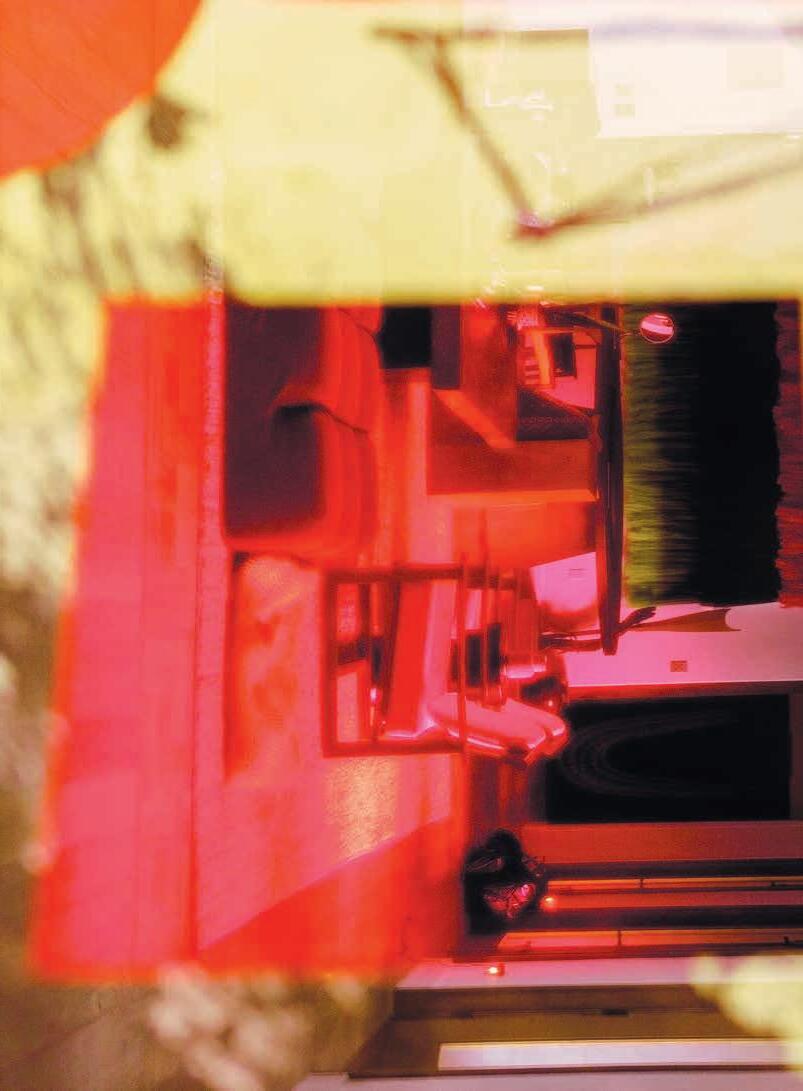
“ I want to make something that when a kid sees it, they want to
If they’re tired of having no grocery stores in their community, I want them to stop wai
ting and know they can make one .” — Michael Bennett make that. They want to change the sidewalk.

LIVING WELL
135 IMAGE BY _ MICHELLE MISHINA
Designed to Gather
INSIDE THE CREATIVE PRACTICES OF SPATIAL DESIGNER MICHAEL BENNETT AND ARTIST PELE BENNETT. TOGETHER, THEY STRIVE TO FOSTER SPACES THAT STRENGTHEN COMMUNITY CONNECTIONS THROUGH FURNITURE, ARCHITECTURE, AND EVENT SERIES.
TEXT BY IMAGES BY BEAU FLEMISTER MICHELLE MISHINA
Sitting across from Michael Bennett, the NFL Super Bowl champion and threetime Pro Bowler turned furniture and architecture designer, it might be tempting to think the transition from sports to art to be some sort of seismic leap. That somehow there’d be a wide gulf between a world of brute strength and bodies colliding to another of form, function, and gallery spaces.
But Bennett sets me straight, knowing what bush I was beginning to beat around by suggesting his entrance into the design world could seem on the surface like a completely new chapter of his life after retiring from football in 2020.
“I feel like sports is art,” he says. “I think in being a defensive end, there’s a lot of art in there. There’s abstraction in it. There’s movement. There’s spatial hierarchy. There’s everything: rhythm, skill, form.”
Football, he insists, involves profound mental agility, an aspect often sidelined by spectators who tend to focus on the overt strength displayed by its players. Being able to judge a play, break it down, and move in a certain way using another man’s body in order to navigate the field
theorizes that football is less about being strong than it is about setting up and negotiating movement in space. “I’ve always been an artist in that way,” he says.
We are sitting at the corner of a long communal table in the open air lānai of his home, a sweeping view of the eastern O‘ahu shoreline in one direction and the Honolulu cityscape in the other. A cool trade wind blows through the space and the fibrous material of a mixed media piece by Lauren Halsey, one of the many African American artworks on the walls, dances subtly. The sound of his daughters’ laughter bounces playfully off the walls somewhere within the large home.
Bennett seems relaxed and at ease in this familial space, but every word he utters is assured and deliberate. One gets a swift sense that he is an incredibly
_ FLUXHAWAII.COM 136
_ DESIGN FLUX _ LIVING WELL
MICHAEL & PELE BENNETT AT THEIR HAWAI‘I KAI HOME. BEHIND, A SCULPTURE BY THE AFRICAN AMERICAN ARTIST NICK CAVE.

thoughtful, introspective person, even if throughout his 11-year NFL career he has been known for some comical gameday antics like his hilarious sack dances or that time he “borrowed” a police officer’s bike for a victory lap around the stadium field after his Seahawks beat the Packers in an NFC Championship game. Concurrently, Bennett is also known for his ongoing social activism. A generous humanitarian who has supported multiple organizations such as #iamtheCODE, which has sponsored more than 100 Senegalese girls into STEAMED education programs, Bennett is also a published author (Things That Make White People Uncomfortable, co-written with Dave Zirin) and an advocate for women’s rights. The Bennett Foundation, which he founded with his wife, artist Pele Bennett, educates and supports underserved children and communities around the United States and Africa.
But as for his design practice, attending architecture school at the University of Hawai‘i at Mānoa, and touring art installations and exhibitions around the country — this wasn’t something he just fell into after a prosperous professional football career. Bennett tells me that even as he was extensively traveling around the world in his twenties and early thirties, design and the urge to build something was always on his mind, even if he couldn’t quite express what that would be.
“I didn’t know how those things would play a role in what I would be doing in the future, but looking back, there were moments where I was in a forest, or
somewhere, seeing something so beautiful — the way the shadows would hit something — but I didn’t know the terminology for it,” he says. “So, finding my own voice has been an interesting thing, because I’m still finding it, right?”
An athlete’s own process is often undersung, as far as Bennett is concerned, and he draws parallels between how one approaches sports and art-making. “There are so many parts working, trying to make one goal, to make one play, and most people don’t see the process of what it takes to get to that moment — the amount of work you have to do in the body,” he explains. “And the body is similar to architecture, right? For instance, when I think about my own body, and I think about architecture and the connection there, both are places that hold memories.”
Speaking of memory, Bennett confesses that that was a constant consideration when transitioning careers from football to design. “There definitely was this fear with CTE [chronic traumatic encephalopathy],” he says, referring to the progressive brain disorder linked to repeated head injuries and most commonly associated with former professional U.S. football players. “Will I not be able to use my brain fully? Will I only conquer the body? Or will I get an opportunity to conquer the mind? These were things I was thinking about as I was retiring, where it was like, I can’t be broken to the point where I won’t be able to put things that are in my mind out into the world and for them to become alive. You achieve these
138 _ FLUXHAWAII.COM
_ DESIGN LIVING WELL



riches, but it comes with a cost,” he continues, “and it’s a quiet cost because you don’t know when CTE is going to sneak up on you.”
Never one to shy away from hard work, Bennett’s second act has proven nothing short of remarkable. After studying design at Seattle’s Heritage School of Design, he enrolled in the architecture school at the University of Hawai‘i at Mānoa, simultaneously showing his work in exhibits around the country in 2023, from the sculptural installation “Urban Decay” at Honolulu’s Hawai‘i Walls public arts festival to the cross-laminated timber gath-
ering space Public Display at the NYCxDesign Festival. His latest exhibit, We Gotta Get Back to the Crib, unveiled January 2024 at Rebuild Foundation’s 6-Flat gallery in Chicago, showcased sculptural furniture works inspired by his family’s leg in the Deep South.
In 2020, Bennett founded Studio Kër, a design studio that explores African diasporic forms and languages through storytelling, architecture, and design. Through these engagements, his design practice strives to uplift Black agency and autonomy through community engagement and accessibility, and to be, as he describes it,
“a well-rounded forum that has multiple outlets and mediums to express important narratives of Black identities and cultures.”
“I want people thinking about spaces in different ways,” he explains. “I hope to build museums, I hope to build chapels actually, no, I will build museums. I will build chapels…”
When Bennett refers to rethinking spaces, one area where he’d like them redesigned is within Black communities. In his eyes, there are plenty of areas that foster physical competition, but rarely any that cultivate a different type of in-
140 _ FLUXHAWAII.COM
LIVING WELL _ DESIGN


THE BENNETTS, INDIVIDUALLY AND AS A DUO, AIM TO INSPIRE PEOPLE TO REIMAGINE SPACES AND EXPLORE THEIR IDENTITIES.
141
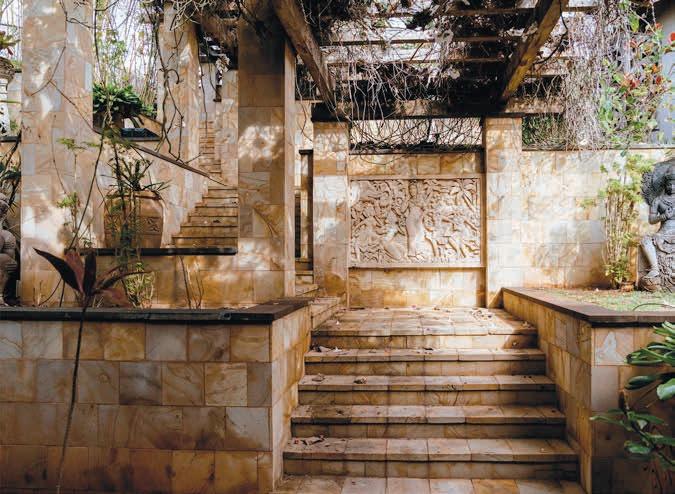
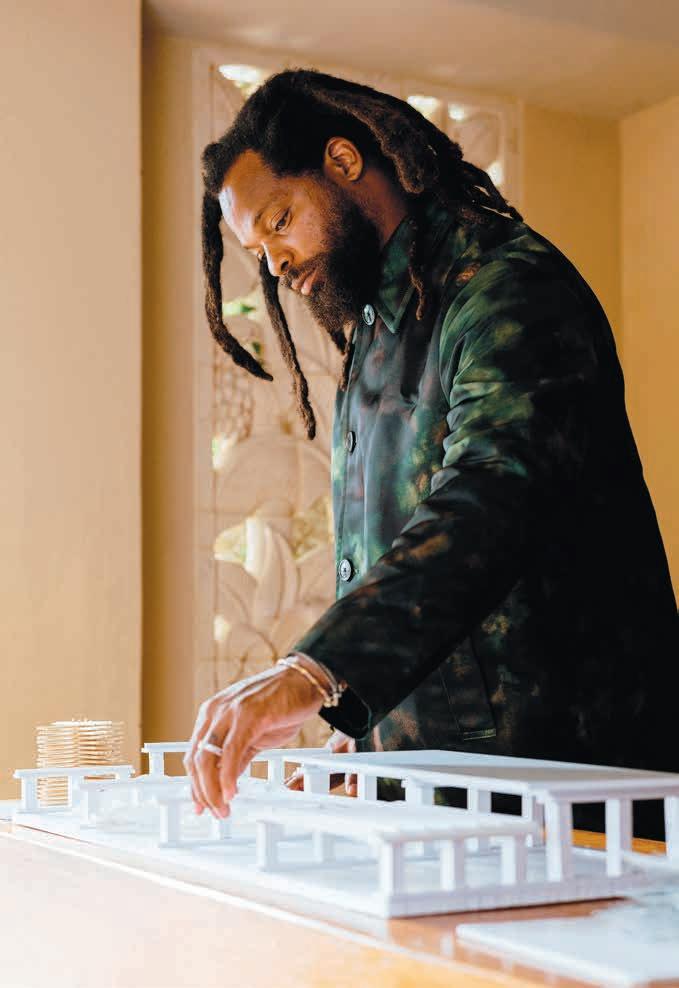

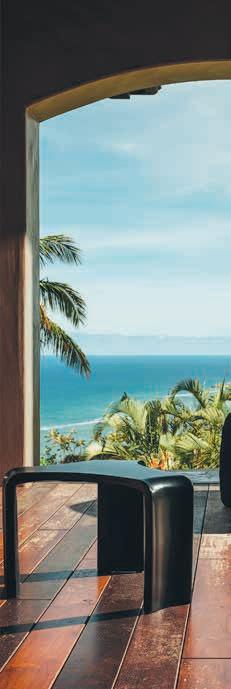 Gumbo Chair & Stool, 2022
Fiberglass, linen, and upholstery
Gumbo Chair & Stool, 2022
Fiberglass, linen, and upholstery
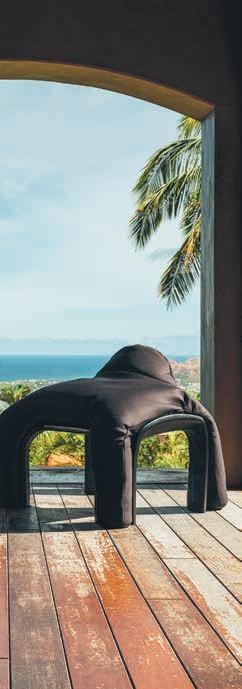
 IMAGES BY _ MARK KUSHIMI
IMAGES BY _ MARK KUSHIMI

ward wellbeing, a balance he’d like to see restored. “We talk about mental health now, but when I’m mapping an urban area, I see a lot of football fields, I see a lot of basketball courts — I don’t see any meditation spaces.” Bennett points to countries like Japan where there are a lot of public spaces that encourage an experience of serenity. “There are a lot of places where you can have a moment to connect to nature and get back into the senses,” he says. “I feel like nature and light is what fills us with joy and pushes us forward.”
Creating spaces where people can gather undergirds Bennett’s design practice. “Which is something I’m learning from her,” he says, gesturing to his wife, Pele, as she floats by the lānai. “You gotta see what she’s up to.”
Raised in Houston, the Bennetts met in high school and have been together ever since, now raising three daughters. Pele’s family, who have Samoan and Tokelauan roots, is from Hawai‘i, hence their home on O‘ahu and the connection her husband has developed with this land. Spending much of her childhood performing in her family’s traveling Polynesian dance production, Pele has been in the performing arts since she was five years old. She got into photography and painting over the years, as well as costume assemblage that draws on traditional Polynesian attire.
“I’ve gotten to see the evolution of Michael … the way he’s expressed himself in so many different spaces, and that’s been really beautiful,” she says, leading me into her and her husband’s art and design
IN 2020, MICHAEL FOUNDED STUDIO KËR, A DESIGN STUDIO THAT EXPLORES AFRICAN DIASPORIC FORMS. IN 2024, PELE WILL LAUNCH VAVE’AO, A POLYNESIAN HAIR CARE LINE.
space, two connected rooms around the corner from the lānai. Around us, hardcover art books line shelves or rise in stacks like small towers. Fabric and feathers lay on a table for cultural adornments. Easels, moodboards, photos; a bird’s nest of creativity. Currently, the two projects that she’s most consumed by are the launch of her new Polynesian hair care line Vave’ao and an event series she hosts for entrepreneurs and innovators, often centering women creatives, at their home called In the Vā.
A Samoan term, also common in other Polynesian languages, vā is a concept of “the space in between,” Pele explains to me. “I think I’ve always felt a little vā, ‘in between.’ Like, ‘Is she white or is she Black? Is she from here or not?’ The In the Vā events we host are a place for peo-
146 _ FLUXHAWAII.COM LIVING WELL _ DESIGN





ple that might not live in the categories that people want to assign them. This is their space to form relationships and connections.”
Bennett passes through and nods, giving Pele a knowing smile. Earlier, he had told me that the word “communion” kept running through his mind when he was making the transition from pro athlete to designer, and it appears that he, as well as his wife Pele, strive to gather people through the communal spaces they de-
sign. His furniture pieces featured in We Gotta Get Back to the Crib, for instance, reimagine seating used to congregate, from the church-inspired Pew couch to the Gumbo lounge chair, while Pele’s In the Vā events gather an array of voices and professionals, providing them space to form community.
“Sometimes design can feel like a group of people in a space, drinking fine wine, talking about design, but they’re not in touch with the common person,”
RAISED IN HOUSTON, THE BENNETTS MET IN HIGH SCHOOL AND HAVE BEEN TOGETHER EVER SINCE, NOW RAISING THREE DAUGHTERS
says Bennett. “And the people who are a part of the community can feel that. A lot of people feel like, ‘This design wasn’t made for me.’ I want to make something that when a kid sees it, they want to make that. They want to change the sidewalk. If they’re tired of having no grocery stores in their community, I want them to stop waiting and know they can make one. That’s what I want to do with Studio Kër, to create that pipeline of thinkers.”
151 _ DESIGN EXPLORE
THIS STORY WAS MADE IN PARTNERSHIP WITH KĪNĀ‘OLE FOUNDATION FOR FLUX’S HAWAIIAN-LANGUAGE
REPORTING SERIES FEATURING ARTICLES PRODUCED ALL IN ‘ŌLELO HAWAI‘I.
TO READ THIS STORY IN
ENGLISH: FLUXHAWAII.COM/ SECTION/OLELO-HAWAII
He Pōhaku Kihi Paʻa
EIA ‘O KIMEONA KANE, KE UHAU HOU NEI I NĀ KUAPĀ PŌHAKU
KAHIKO O KA LOKO I‘A ‘O PĀHONU. I KONA MANA‘O, UA PILI
KĒIA KULEANA I KA PONO O KĀNAKA A ME KO KA ‘ĀINA A PAU.
KĀKAU ‘IA E
PA‘I KI‘I ‘IA E
HO‘OPONOPONO ‘IA E
N. KAMAKAOKALANI GALLAGHER
JOSIAH PATTERSON
N. HA‘ALILIO SOLOMON _ UHAU HUMU PŌHAKU
I ka pā mai o ka makani ʻAlopali koʻu hui malihini ʻana me Kimeona Kane, kekahi mea nāna e kūkulu hou nei i ka loko iʻa ʻo Pāhonu ma Waimānalo. Ma ia lā makani nō i unoho iho ai māua ʻo ia ʻiwa kīkaha o laila, i lohe mai ai kou mea kākau i ka moʻolelo o kāna mālama ʻana iā Pāhonu. He ēwe hānau ʻo Kimeona o ka ʻāina kaulana i hoʻopuni ʻia e nā pali, iā Waimānalo hoʻi, a ua lohe ʻia nō ke aloha nui a me ka haʻaheo i ua ʻāina nei ma nā ʻōlelo a pau āna i kamaʻilio maila. ʻO kāna papahana nui, ʻo ia hoʻi ka hoʻopaepae hou ʻana i nā kuapā o ka loko iʻa, ma o ka uhau humu pōhaku, ʻo ia hoʻi ke kūkulu pā pōhaku ʻana ma nā loina Hawaiʻi kahiko, ʻaʻohe puna hamo. Penei kaʻu nīnau mua loa iā ia: “Pehea ʻoe i aʻo mai ai i ka uhau humu pōhaku?” Pane maila ʻo Kimeona, “Ua hoʻomaka koʻu aʻo ʻana i ka uhau humu pōhaku ma Pāhonu nei, i ka makahiki 2017, i ka wā i loaʻa ai ka ʻae i ka Waimānalo Limu Hui e hoʻōla iā Pāhonu ma ke ʻano he waihona no ka honu.” ʻAʻole paha e pūʻiwa ka mea heluhelu, ʻo ia nō ke ʻano o kēia loko iʻa i ka wā kahiko, he pā ʻo ia no ka iʻa kapu o ke aliʻi o laila. “Ua kono ākea ʻia ke kaiāulu, a ʻo au kekahi o nā mea i ō i ke kāhea” i hoʻomau ai ʻo ia nei i ka ʻōlelo ʻana. ʻO kona kumu aʻo i kēia hana, ʻo ia ʻo Kinohi Pizarro, he kumu uhau humu pōhaku ma Ke Kula Nui o Waimānalo a he limahana hoʻi ma Paepae o Heʻeia i ia manawa. “He kamaʻāina ʻo ia no Waimānalo,” wahi a Kimeona, “a ua lawe mai ʻo ia i ka ʻike, a i kona hui hoʻi i ʻaneʻi me ka manaʻo e aʻo mai iā mākou i ka mālama ʻana i kēia ʻano wahi pana ma o ka uhau humu pōhaku.” “Ua hoʻoholo kuʻu kumu i ka manaʻo,” i pane mai ai ʻo ia nei, “ua hiki nō ke lawe ʻia mai nā kānaka i kamaʻāina ʻole i kēia hana kuʻuna, i kamaʻāina ʻole hoʻi i kēia ʻano nohona, e kono mai iā lākou i nei kaiāulu a i nei wahi hoʻi, a e hoʻomaʻamaʻa i kēia hana koʻikoʻi o ka nohona o kākou.” I koʻu wahi ʻike hōlona i ka

_ FLUXHAWAII.COM 152
FLUX _ LIVING WELL

153

‘O kāna papahana nui, ‘o ia ho‘i ka ho‘opaepae hou ‘ana i nā kuapā o ka loko i‘a, ma o ka uhau humu pōhaku, ‘o ia ho‘i ke kūkulu pā pōhaku ‘ana ma nā loina Hawai‘i kahiko, ‘a‘ohe puna hamo.
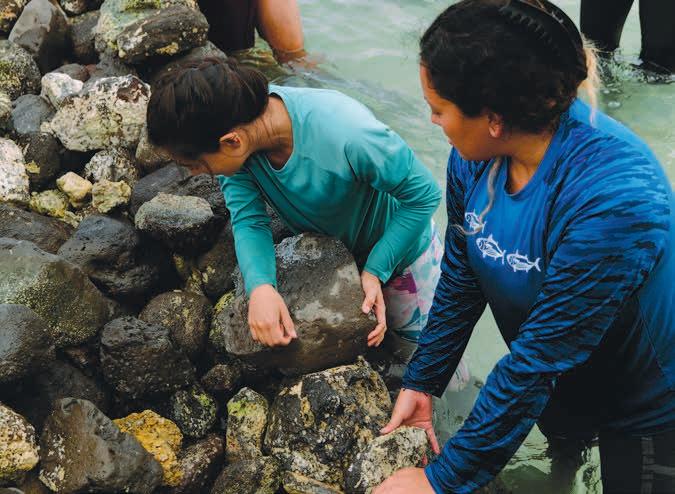
“‘O ka ha‘ina, aia i ke au o ka manawa. I ka noho ‘ana ma kēia wahi, i ka noho ‘ana ho‘i me nā pōhaku. ‘O ia ‘ano pilina ke ho‘okahua i kēia ‘ike a i kēia nohona, nā mea ho‘i e lilo ana he mea kōkua no Waimānalo nei.”

uhau humu pōhaku, ua maopopo leʻa, he hana ʻike ia. Ua nui ʻino nā mea e pono ai ka lehia ma ia ʻano hana noʻeau, ʻeā. Pēia pū ke alakaʻi ʻana i ke kaiāulu. No laila i nīnau aku ai au iā Kimeona, he aha kekahi mea i kuʻia iā ia ma kēia alaloa? Pane mai ʻo ia nei, “ʻO ka mea paʻakikī, ʻo ia ka hoʻihoʻi ʻana i nā kānaka ma ʻaneʻi, me ke kono ʻana i nā mea hoihoi a hoihoi ʻole paha i ka hana.” ʻO kona makemake, ʻo ia ke kipa nui ʻana o ka poʻe Kanaka Maoli i Pāhonu, “me ka ʻiʻini e aʻo. Me ka hoʻomaopopo ʻana hoʻi, ua hiki iā lākou ke hele mai me ka makaʻu ʻole i ke ʻano ʻakahi akahi i ka hana.” Hoʻomau ʻo Kimeona i ke kamaʻilio ʻana, “ʻO ia nō kekahi pilikia nui, ka pā ʻana aku i ko lākou mau naʻau i hoʻi ai lākou i kēia mau ʻike kupuna.”
“Eia hou, ʻo ke ʻano o hana kekahi mea nui. Pehea mākou e hoʻohiwahiwa aʻe ai i nā kūpuna, nā mea hoʻi nāna i hoʻoniho i nā pōhaku mua loa? Pehea e
pili ai kā mākou hana iā lākou? ʻO ka haʻina, aia i ke au o ka manawa. I ka noho ʻana ma kēia wahi, i ka noho ʻana hoʻi me nā pōhaku. ʻO ia ʻano pilina ke hoʻokahua i kēia ʻike a i kēia nohona, nā mea hoʻi e lilo ana he mea kōkua no Waimānalo nei.” I kaʻu nīnau ʻana i ka haʻawina nui a Kimeona i aʻo mai ai ma o kēia hana uhau humu pōhaku, ʻo ka hoʻomanawanui ka i lohe pinepine ʻia. Mea maila koʻu hoa ʻōlelo, “ʻO ka haʻawina nui … ʻo ka hoʻomanawanui ia, ka hoʻomanawa nui me ke aʻo, ka hoʻomanawanui me ka hoʻomaopopo, ka hoʻomanawa nui me ke kuanoʻo ʻana.” “ʻAʻole kēia he hana e nanea wale ai mākou no ka hopena pule. He mea kēia no ko mākou mau ola, a kau i ka puaaneane.”
“No laila e ke hoa,” i nīnau aku ai kahi keiki nīnauele i ke kupa o ke kai hānupanupa o Mānana, “He aha kou makemake no ka wā e hiki mai ana, e
pili ana i ka uhau humu pōhaku?” Pane maila ʻo Kimeona, “ʻO koʻu moemoeā ia, e ʻike ʻia ana ka uhau humu pōhaku ma nā kaiāulu a pau … i pili hou ai kākou i kēia mau wahi, i kamaʻāina ma o ka puke aʻo wale nō, ma o nā kiʻi i paʻi ʻia e haʻi.” “Inā ua loaʻa kahi kanaka hoʻokahi e lilo ana i kumu ma nā kaiāulu a pau,” i ʻōlelo mai ai ʻo ia nei, “he holomua ʻana kēlā.” Wehewehe ana ʻo Kimeona, he mea nui ke loaʻa nā wahi no ke aʻo ʻana a me ka launa aloha ʻana o nā kānaka me ka poʻe ʻike. ʻAʻole naʻe i pau ka pilina i ke ao o ke kanaka. ʻŌlelo maila ʻo Kimeona, ke hoʻihoʻi ʻia ka limu o ka loko, e hoʻi ana ka iʻa. E ola ana nā manu i ka iʻa, a e ola ana ka ulu nahele i nā manu, ʻo ia ihola ke ola o ka ʻāina. “Noho mākou ma ka ʻaoʻao hikina, kahi e pā mua mai ai ka lā. Pehea mākou e kilo ai i nā mea like ʻole o kēia ʻāina, a e hoʻomaopopo iā lākou ma ke ʻano like o nā kūpuna?”
156 _ FLUXHAWAII.COM
LIVING WELL _ UHAU HUMU PŌHAKU

Despite its location just minutes from the urban density of Honolulu, the stretch of the Ko‘olau range known as Tantalus somehow seems to inhabit a world of its own. As one ascends along its windy road, the air noticeably cools; at night, a dense fog descends down through the trees. As hikers and mountain bikers and daytrippers make their way home, wary of traversing its hairpin turns in the dark, Tantalus is left for those who live there.
Interior designer Ginger Lunt is one such resident. Though much of her family—Mormons from Utah who
Soul of the Mountain
AN INTERIOR DESIGNER AND PHOTOGRAPHER TEAM UP TO DOCUMENT THE ARCHITECTURE AND RESIDENTS OF TANTALUS.
& IMAGES BY IJFKE RIDGLEY
settled in Hawai‘i in the 1850s—has called La‘ie home for generations, Lunt’s parents bought and relocated to a property on the upper reaches of Tantalus Drive when she was 12 years old. “I’ve always had a soft spot for the mountain and being surrounded by the forest,” she says. “All of its sounds, layers of green, and scents of flowers and eucalyptus.” For Lunt, Tantalus remains a calming oasis away from the crowded concrete jungle of Honolulu. Today, Lunt lives in a property just two houses down from her childhood home. It also serves as headquarters
of her interior design firm, Tantalus Studio, lovingly named after the mountain on which it resides. Behind a blink-and-you’ll-miss-it wooden gate camouflaged by foliage, the two-story house stands with simple bones and an open, welcoming façade that was originally designed in 1954. Thin support beams uphold a wrap-around lanai, framing an original lava-rock chimney and poured-concrete entryway. Inside, koa wood floors, board-and-batten paneling, and built-in millwork were lovingly restored to their original glory in 2018 by Lunt and a team of
158
PROMOTIONAL CONTENT
FLUX _ LIVING WELL
_ TANTALUS STUDIO _ FLUXHAWAII.COM
TEXT

159

local craftsmen. “It has a lot of classic 20th-century Hawai‘i design elements,” Lunt says. “Luckily almost all of the house was still original and had never been changed, which I love.”
Lunt’s collection of artwork and furnishings are minimalist yet eclectic, offering a taste of Hawai‘i through the ages: vintage cane sofas, lauhala mats, a midcentury-modern dining set, contemporary Hawaiian art. The outdoor brick patio overlooking Pearl Harbor issurrounded by vegetation that turns from green to gold in the setting sun.
I follow Lunt up the rock pathway behind the house, through a dense thicket of bamboo, to the neighboring Potter residence. The Potters were the first family we interviewed in a nowyears-long quest to tell the stories of
Tantalus before some of its longtime residents are no longer here to do so themselves. Lunt asked me to photograph the many remarkable houses on the mountain, and the equally remarkable characters who reside in them, in hopes of compiling them all into a book.
“My passion for architecture and design, paired with my connection to the Tantalus community and deep love for this forest, is what inspired me to work on this project,” Lunt says. “There is such an authentic quality to the people and the homes that are up on this hill. There are homes built humbly and lovingly by their owners alongside homes created by wellknown architects, all deeply inspired by the surrounding natural environs in different ways.”
TUCKED INTO THE FOREST AND HIDDEN FROM VIEW, UNIQUE PROPERTIES ABOUND. MANY TANTALUS RESIDENTS HAVE BEEN THERE FOR GENERATIONS. IN THE LATE 19TH CENTURY, FAMILIES SOUGHT OUT THE AREA TO BUILD MODEST MOUNTAIN COTTAGES AS SECOND HOMES.
Tucked into the forest and hidden from view, unique properties abound: humble wooden cabins that date back more than 100 years, Asian-inspired dwellings, and midcentury-modern marvels, including ones designed by famed Honolulu architect Vladimir Ossipoff. There are manicured estates too, like the sprawling property perched on the top of Round Top Drive, whose owners can still be found tending to its acres of landscaping and “flossing” the surrounding bamboo forest late into their Golden Years.
Many Tantalus residents have been there for generations. In the late 19th century, families sought out the area to build modest mountain cottages as second homes, going without electricity and running water for months at a time in the summer.
160 _ FLUXHAWAII.COM LIVING WELL
PROMOTIONAL CONTENT
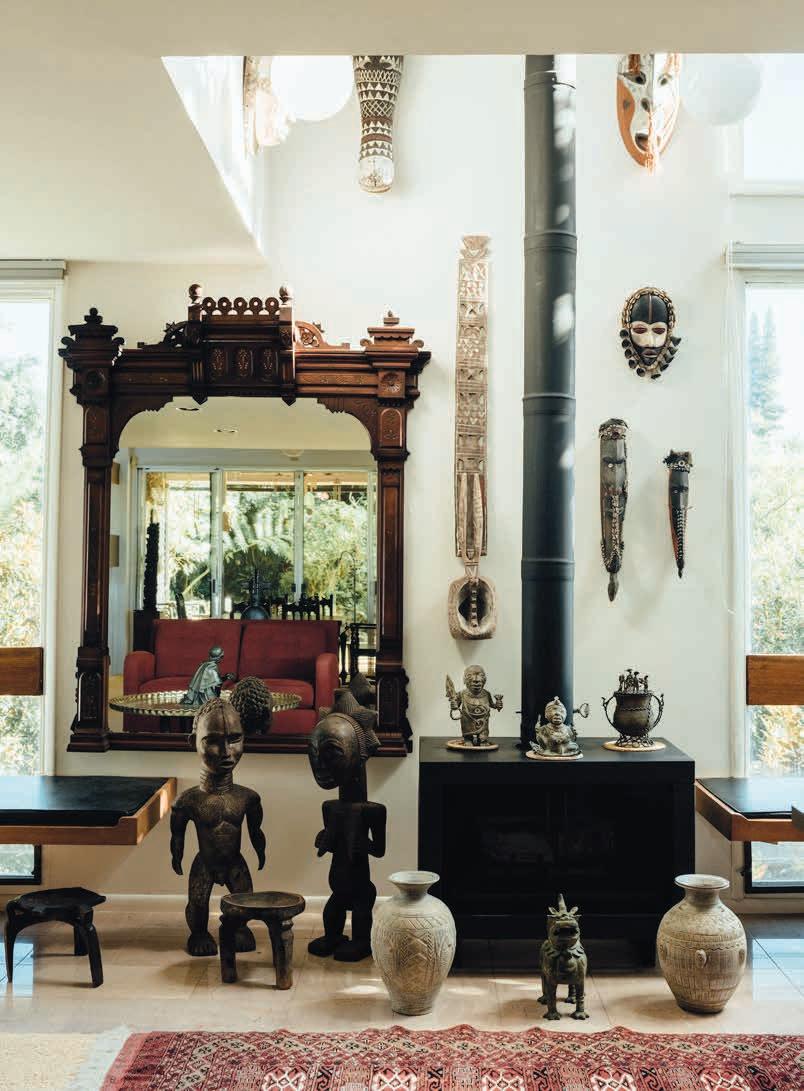

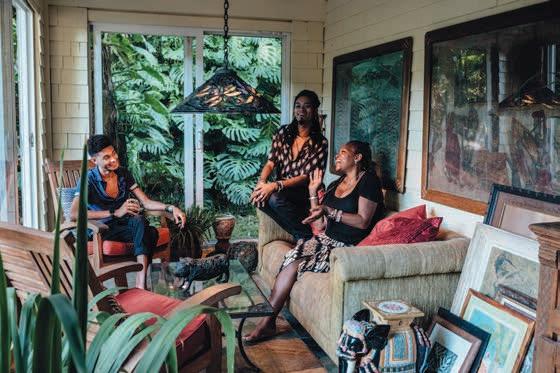
162 _ FLUXHAWAII.COM PROMOTIONAL CONTENT

LOCATED JUST MINUTES FROM THE URBAN DENSITY OF HONOLULU, TANTALUS SOMEHOW SEEMS TO INHABIT A WORLD OF ITS OWN.
163
Back then, Tantalus Drive was just a dirt road, and the trek up the hill by horse was arduous; a stop at the little grocery store that once stood halfway up the mountain supplied ice and basic groceries.
These days, the neighborhood continues to attract a specific breed. “It’s people who relish this kind of distance,” says Gary Gill, a former longtime resident whose family still calls the mountain home. “And you’ve got to be willing to put up with the wet and the mosquitoes and the fog blowing through your house, and your closet getting moldy in the winter.”
Resident Kim Coffee-Isaak echoes the sentiment. The active Tantalus Community Association member says the drive up the mountain is often polarizing for visitors. “When they get out of their car, they say, ‘Oh my god, that drive is so cool. It’s so beautiful. We just love it up here.’ Or, they get out of their car and say, ‘Oh my god, how do you do that drive every day?’”
Over the years, the mountainside enclave has been home to artists and intellectuals, architects and hermits—a down-to-earth bunch with a mutual appetite for nature and serenity. But as it turns out, a neighborhood defined by its mystery and isolation also tends to attract people who value their privacy, making the book project a challenging undertaking.
Thankfully, having grown up on the mountain, Lunt is friendly with the many families she passes on
her evening walks on the hill. Some, she’s known since childhood. In her company, old-timers open up about childhood memories of their own, like sliding down the steep hills on ti leaves and the firecracker battles between gangs of Tantalus kids who claimed the forest as their own. Former resident Joan White fondly recalls a set of stairs at the bottom of the mountain, where, for decades, neighborhood children could sit and wait for a ride up the hill from anyone with a Tantalus sticker on their car.
There were also the “great guava wars.” “When we were kids, we would colonize a guava tree somewhere and then sort of make a village in it,” Gill remembers. When the fruits ripened, he and his friends would pick guava and haul them home in gallon-sized Folgers Coffee cans to his mother, the neighborhood’s de facto jelly maker. “My mom would spend the week making guava jelly and pass it around the neighborhood,” Gill says. “The whole valley smelled of guava jelly.”
Despite their shared appreciation for privacy, Tantalus residents maintain a strong sense of community. “They’ll really watch out for you,” White says. “They’ll help you out.” As her husband, Perry, muses, “What would Honolulu be like if it didn’t have places like Tantalus? Where would the people who are there be? And how would not being there change them, and how would they’re not being there change the city?”
164 _ FLUXHAWAII.COM PROMOTIONAL CONTENT LIVING WELL

165
EXPLORE

“ If people aren’t aware of the cultural properties that are
 here, there aren’t going to be people that fight for it. ” — Skye Kolealani
here, there aren’t going to be people that fight for it. ” — Skye Kolealani
167 IMAGE BY _
Razon-Olds
JOHN HOOK
Cultural Ascents
THE NATIVE HAWAIIAN-LED KĀNAKA CLIMBERS EXPANDS STEWARDSHIP OF SACRED SITES.
TEXT BY IMAGES BY
ANNABELLE LE JEUNE
ELYSE BUTLER
Deep in the Waipiʻo lowlands, on the island of O‘ahu, the Kānaka Climbers met under a rising sun. Contrary to their name, this was no ordinary climbing excursion. Instead of chalk bags and climbing shoes, a dozen climbers were armed with trash bags and safety gloves, and rather than scrutinizing rock faces for handholds and routes, all eyes were trained on the trail underfoot.
“We don’t do much climbing at our events,” said Skye Kolealani Razon-Olds, executive director and co-founder of Kānaka Climbers, as she led the crew in a clean-up. These bimonthly trips are more educational than recreational, meant to enlighten climbers with the overlooked histories of the sites they frequent.
The group packed into truck beds, carpooling up the road to stop at an easy-to-miss trailhead that led down to Kīpapa Gulch. Leggy trees cast shadows overhead as the occasional off-distance hum of a dirt bike dragged by. They paused at a boulder where Razon-Olds and her family pointed out a few climbing routes before proceeding deeper into the gulch.
“We’re going to go way past the climbing area. We’re going to go to all the significant sites, really going to make sure that there’s a deeper understanding of the space,” said Razon-Olds, who reminded the team not to rush through the clean-up even as the trail proved laden with bouldering opportunities. They’re encouraged to return later, once they have learned more about the site.
In 2017, a since-wiped video circulated on social media within the local climbing community of climbers scaling across markings that resembled petroglyphs along a popular Nuʻuanu route. Upon seeing that clip, Razon-Olds

168
FLUX _ EXPLORE
_ ROCK CLIMBING _ FLUXHAWAII.COM

169
studied the area and confirmed that these were kiʻi pōhaku, or petroglyphs, and they were sprinkled throughout the site. “There was a misunderstanding of how significant the site was,” she said, prompting her to found Kānaka Climbers in the incident’s aftermath. Some carvings were so faint they could easily go unnoticed, a problem at such a high traffic route where regular human interaction can quickly erode the historical markings.
The lack of signage and resources is an issue seen across the islands, exacerbated by the lack of cultural education around outdoor sites. “The majority of cultural sites on the continental U.S. actually have signage. That is something Hawaiʻi has not jumped on board to,” she said. Contrast that with the past, said Razon-Olds, when Hawaiians protected sacred sites and kept them within their family’s kuleana, their responsibility.
Razon-Olds in particular grew up scaling rock walls and boulders to burial
sites of her ‘ohana, a practice she continues today with her children. Some were positioned in caves of varying elevations with handholds carved out for climbing accessibility. There she learned how to safeguard iwi kūpuna, or ancestral remains, removing invasive species or clearing up sites after rockslides. Through Kānaka Climbers, Razon-Olds uses the lessons learned from these traditional practices to better inform her fellow recreationalists.
“Climbing was innately Hawaiian and Indigenous,” she said, more so used “to complete a practice, to either get to a fishing site, a hunting site, a secluded place where people were living to make sure other valleys couldn’t get to them, or it would be for burial practices.”
Following the U.S. overthrow of the Hawaiian Kingdom in 1893, land rights and development severed families from sites that ʻohana once stewarded. Kānaka Climbers’ efforts are meant to preserve
SKYE KOLEALANI RAZON-OLDS IS THE EXECUTIVE DIRECTOR AND CO-FOUNDER OF KĀNAKA CLIMBERS THE PRESERVATION OF KI‘I PŌHAKU ARE AMONG THE GROUP’S MAIN OBJECTIVES. THEIR ETHOS TEACHES THAT PŌHAKU, OR ROCKS, ARE NOT MEANT TO BE CONQUERED WHILE CLIMBING.
EXPLORE 170 _ FLUXHAWAII.COM _ ROCK CLIMBING


the remaining sacred spaces frequented by hikers and climbers with the hope that state and local governance will eventually implement appropriate management such as signage, paved trails, and enforced access to properly protect these spaces.
The trail that runs through Kīpapa Gulch once connected the lowlands of Puʻuloa, or Pearl Harbor, to Līhuʻe, or Schofield. The areas in and around the stream are steeped in history. Its name translates to “placed prone,” a fourteenth-century reference to the slain warriors that paved its terrain, and recalls two notable battles fought along its banks. The now dried stream snakes through traditionally stacked rock wall terraces once used for dryland gardening, vestiges of a once thriving lāhui (nation). Scattered across its fields are rock faces carved with kiʻi pōhaku dating back to the 1400s and are one of the highest concentrations of petroglyphs on Oʻahu.
In 2023, Koa Ridge, a residential development parallel to Kīpapa Gulch, planned to build deeper into the Waipiʻo lowlands, an expansion that would have demolished nearby rock walls laden with kiʻi pōhaku. In an effort to preserve the sites, Kānaka Climbers members and archaeologists reported their findings proving the area’s cultural and historical significance in a board meeting to the State Historic Preservation Division, ensuring that the developer won’t be able to bypass cultural protection laws.
“I get it, I don’t own a home and I understand the larger aspect of housing our people,” says Razon-Olds. “For me, being able to partake in these larger development plans is important as a community member who wants to one day own a home but also make sure we maintain what makes Hawaiʻi, Hawaiʻi.”
At the end of the trail, Razon-Olds led the group up an unmarked path. Carved on a rock face was an assemblage of kiʻi pōhaku. Participants were encouraged to look closer, but not to touch. They were advised to report other petroglyphs they may find throughout the day.
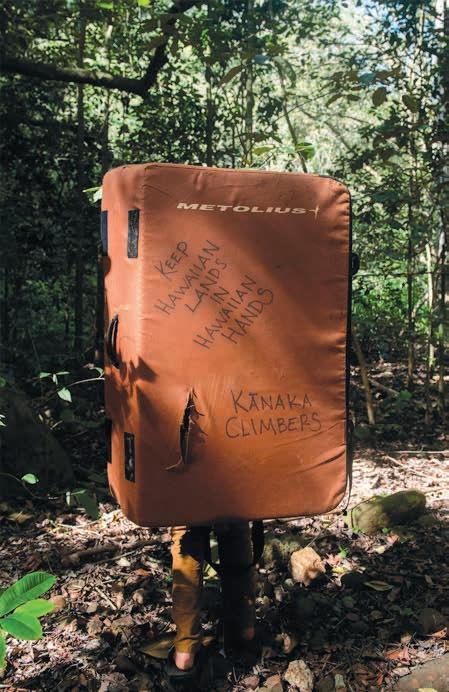
_ ROCK CLIMBING EXPLORE 173


The surveying, reporting, and preservation of kiʻi pōhaku are among the group’s main objectives. With a team of volunteer archaeologists and cultural advisors, the organization ensures that there is no risk of damage to a culturally significant site before inviting participants.
The group’s ethos teaches that pōhaku, or rocks, are not meant to be conquered while climbing. Instead, recreationalists should seek to cultivate a deeper relationship with these sites, respecting them as spaces with storied significance, and in ensuring the environment’s health, these
sites can continue to be used both traditionally and recreationally.
Upon arriving at so-called ʻŌpala Falls, nicknamed for its popularity as an illegal dumping site where trash gets chucked over the edge of the highway and runs down a steep rock wall into a pool of litter that pollutes the gulch down below, the group got to work clearing out the stream. They would end up collecting two truckloads of trash. But before the excursion’s end, two of the group’s keiki announced a discovery.
“We found more petroglyphs!” they shouted, pointing up a rock wall at least
THROUGH KĀNAKA CLIMBERS, RAZONOLDS USES LESSONS LEARNED FROM TRADITIONAL HAWAIIAN PRACTICES TO BETTER INFORM HER FELLOW RECREATIONALISTS.
175 _ FLUXHAWAII.COM _ ROCK CLIMBING
EXPLORE

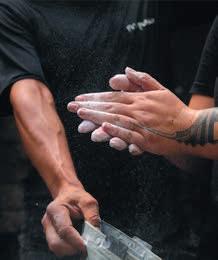
two stories high. There, kiʻi pōhaku were just visible underneath a thick layer of moss. It was of at least one figure, perhaps depicting familial relationships similar to the surrounding petroglyphs. The mountain face’s tricky topography alludes to the skill with which the carver had to climb.
A couple of climbers trekked up the hillside to get a closer look. They jotted down their observations; further proof that these sites, more than mere playgrounds, conceal centuries of stories yet to be told. “If people aren’t aware of the cultural properties that are here, there aren’t going to be people that fight for it,” Razon-Olds said. “That cultural education makes all the difference to making sure that we have space to protect it.”

EXPLORE _ ROCK CLIMBING 176 _ FLUXHAWAII.COM


Ka Waiwai of Waialua
FROM ATV-DRIVING KUMU HULA TO AN EXCEPTIONAL BANANA FARMER, MANY HANDS PITCH IN TO RESTORE AND REVIVE THE ABUNDANCE OF THE HISTORIC NORTH SHORE REGION.
TEXT BY IMAGES BY
Northbound on Route 803, the 5.9-mile stretch of rural highway leading folks from Wahiawa to the outskirts of the north shore, one is hit with this scenic vision: grand Mount Kaʻala kissing the highest clouds to the left, a breadth of farmland to the right; collectively their vastness recalls the creation story of Papahānaumoku and Wākea, the parent couple of the islands’ ruling chiefs and their abundant domain of fresh water springs, streams, fertile soil, and native plants.
This ʻāina momona is Waialua. A fertile land once rife with unceasing stretches of loʻi kalo and loko iʻa, Oʻahu’s most northern moku extends from coastal Kaʻena Point up into the Koʻolau Mountains and back down to Waimea Bay. This storied land, where ali‘i were birthed and then ruled until their departed spirits leapt into the sea, are eight ahupuaʻa: Kaʻena, Keālia, Kawaihāpai, two distinct acreages of Mokulēʻia, Kamananui, Paʻalaʻa, and Kawailoa. Today, without every islander sharing the kuleana of mālama ʻāina, like Native Hawaiian society traditionally mandated, entire fields, mountains,
SARAH BURCHARD JOHN HOOK
WAIALUA (WAI, MEANING “WATER,” AND ELUA, MEANING “TWO”) IS POSSIBLY NAMED AFTER TWO OF ITS LARGEST STREAMS: ANAHULU STREAM AND KAUKONAHUA STREAM
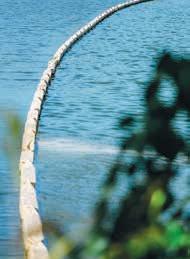
FLUX _ EXPLORE _ NORTH SHORE
_ FLUXHAWAII.COM 178
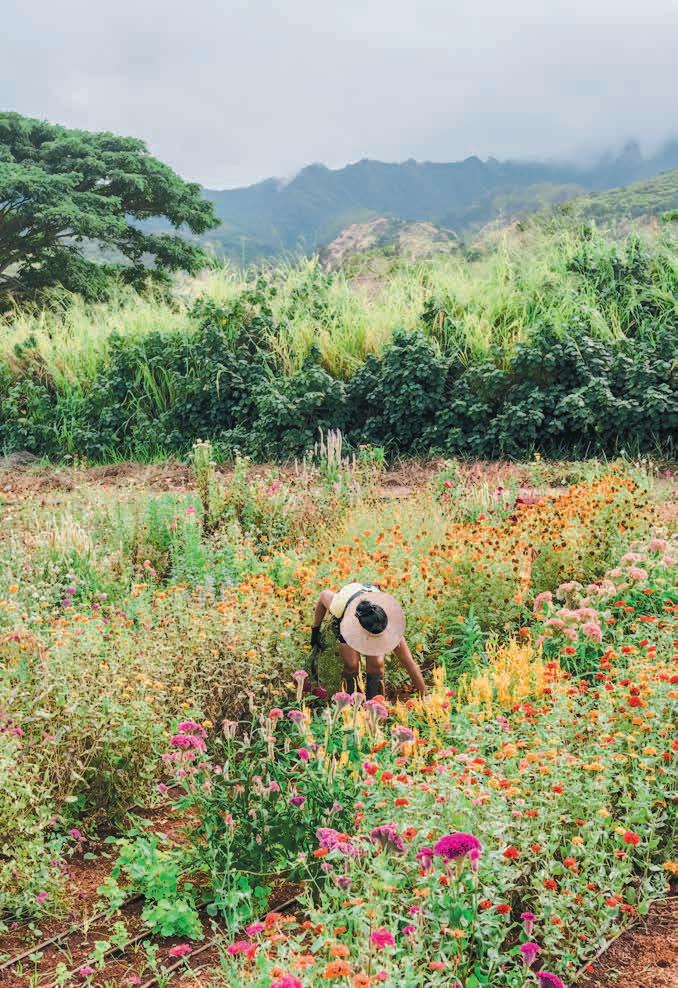
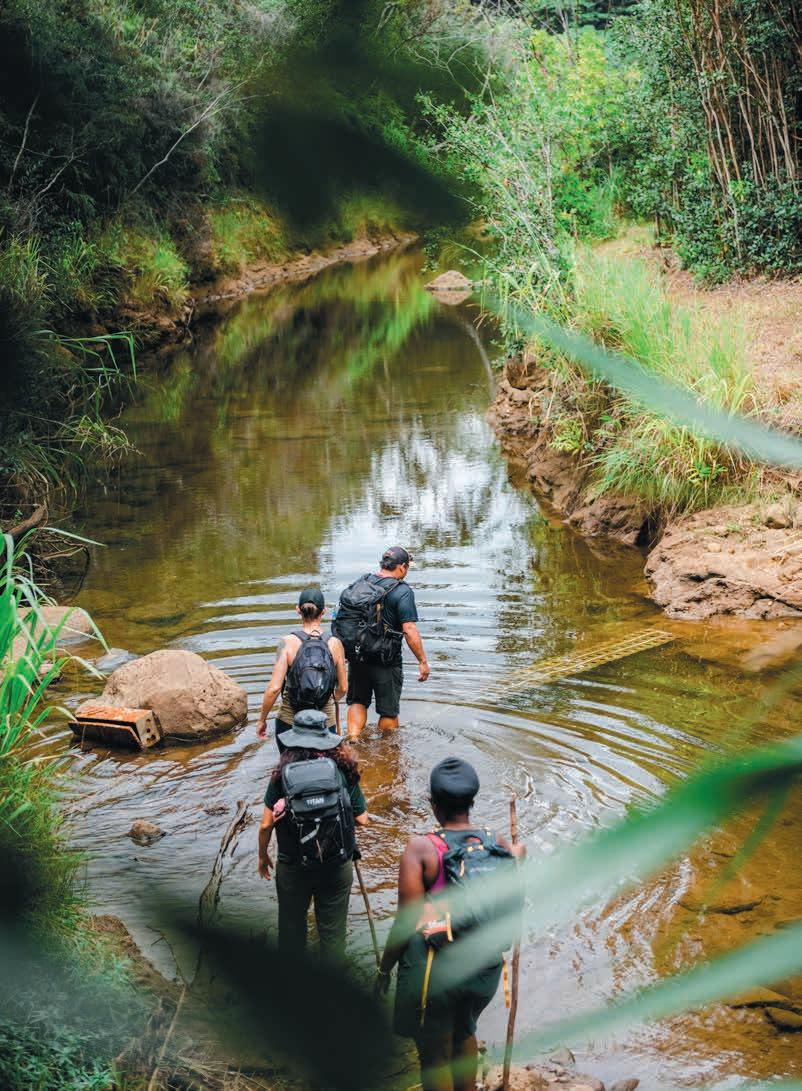

and waterways have become overrun with invasives. From up high one can see the extent of strawberry guava encroaching upon indigenous and endemic trees and plants.
Despite this, there are many committed folks chipping in to safeguard further degradation. Beyond the locked farm gates, homes, and businesses in and around Hale‘iwa Town, these farms and organizations make it their daily responsibility to be stewards of the land while offering something unique to a community fighting endlessly against more development.
makai
Mālama Loko Ea Foundation
Tucked behind the surf shops and popular eateries on busy Kamehameha Highway in Hale‘iwa, the loko puʻuone, or sand dune fishponds, of Loko Ea and ‘Uko‘a
quietly sit. The two have weathered centuries of wear from king tides to floods to modern-day development. Under the highway runs an ‘auwai kai that delivers fish from the ocean to these spring-fed ponds, which are connected by underground caves. The brackish water environment is home to pāpio, mullet, and ōholehole, which swim alongside native a‘ia‘i, endemic ducks, coconut trees, tī, and kalo. Tiny bubbles rising to the surface show the ponds’ bounty of phytoplankton creating oxygen and food for fish.
In 2007, the Waialua community asked landowners Kamehameha Schools if they could get back into these fishponds to restore them. When community work days began a year later, Kamehameha Schools eventually approached two dedicated volunteers, James Estores and Benson Lee, to start a nonprofit. One of the men, a heavy equipment operator, had the vision back
then for the dredging being done now. Fifteen years later, Mālama Loko Ea is about a decade away from reaching its goal of reconnecting the ahupua’a of Kawailoa, meaning “the long water.” Working with traditional aquaculturist Buddy Keala, the nonprofit studies tides, cloud cover, and wind patterns everyday to understand how the loko pu‘uone operated precontact. After they are finished dredging Loko Ea the next step will be to reconnect it with its sister pond ‘Uko‘a, resulting in a 135acre fully functioning fishpond that will produce an estimated 500 pounds of fish per acre every year. Each decision the nonprofit makes is carefully calculated to serve the community and Laniwahine, the kia‘i moʻo of this space.
“We’re super mindful of our place and our responsibility and how it looks to our community," executive director Rae DeCoito said. “We work hard for them.”
181 _ FLUXHAWAII.COM
_ NORTH SHORE EXPLORE


Annually, Mālama Loko Ea hosts 400 community volunteer events and welcomes 80 schools, reaching over 9,000 students from Mākaha to Lā‘ie. One of the organization's greatest strengths is instilling the values of mālama ʻāina in the next generation. Their climate education coordinator Honuʻāina Nichols is a perfect example. Fresh out of college, the 23-yearold is actively building a climate plan for Waialua and taking steps to make Loko Ea a resilience hub. “Our watersheds and wetlands are incredible at mitigating sea level rise, especially our kuapā,” Nichols said. Their favorite fact about how fish-
ponds can combat climate change is that they are “carbon sequesters,” meaning loko i‘a not only provide food, but also reduce the amount of carbon dioxide in the atmosphere.
kula Petal Mettle
Laarni Gedo’s Chevy pickup leads the way ahead a billowing cloud of red dust. We arrive at a dirt road dividing 35 acres into two parcels: one for flowers, one for bananas. Gedo sits near her mother, Norma, who is taking a short break. “She’s a work-
horse,” Gedo said. “She’s here four to five hours every day. Then she goes home and works in her own garden.” The two women operate Petal Mettle, an organic farm that Gedo designed while she was caring for her dying father. “Growing flowers really connected me to the natural cycle of life,” she said.
In the garden ornamental kale sprawls across the soil like an octopus searching for prey, while an ‘aʻaliʻi shrub stands unbothered blocking the wind. There are rows of fuzzy, coral-like celosias in pink, white and magenta; dahlias in deep reds and purples; marigolds the color of au-
182 _ FLUXHAWAII.COM
_ NORTH SHORE EXPLORE

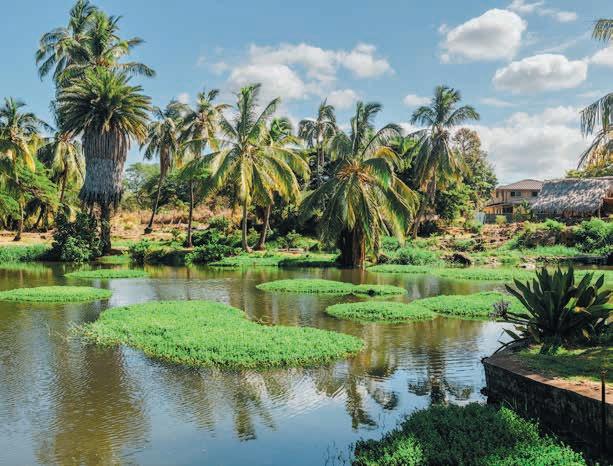
tumn leaves; and multiple species of spiny amaranth ranging from crimson to burgundy. Not the tropical flowers that Hawaiʻi florists typically carry, Gedo’s harvest aims to offer something different: blooms just as beautiful, but also medicinal and edible. Beyond bouquets, Gedo sells tiny blossoms to chefs for garnishes and makes wellness products including a buzz button tincture for dental hygiene and a facial toner made of witch hazel, butterfly pea flower, and sage.
Gedo appreciates the relaxed pace of Waialua compared to town where she lived when she moved to O’ahu in 1992.
“WE’RE SUPER MINDFUL OF OUR PLACE AND OUR RESPONSIBILITY AND HOW IT LOOKS TO OUR COMMUNITY,” SAID RAE DECOITO, MĀLAMA LOKO EA FOUNDATION EXECUTIVE DIRECTOR. “WE WORK HARD FOR THEM.”
183
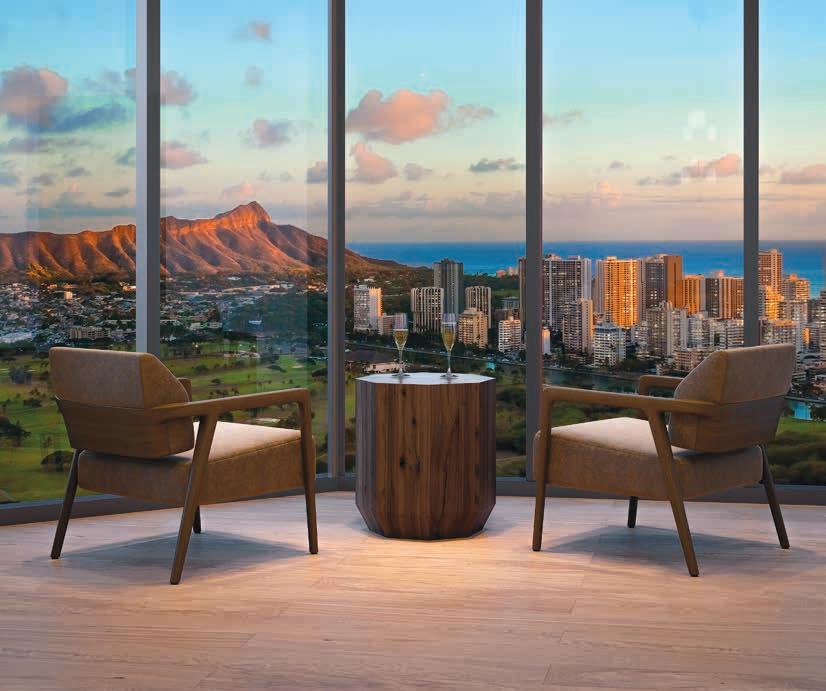

Experience Elevated Island Living For more information on our 1-, 2-, and 3-bedroom residences, please visit our sales gallery. Ala Moana Center, Level 3 Ewa Wing 1450 Ala Moana Blvd. Suite 3505, Honolulu, Hawai‘i 96814 www.kuileiplace.com | 808.751.2599 Kuilei Place is a proposed project that is being developed by 2599 Kapi‘olani, LLC and does not yet exist. All figures, facts, information, and prices included in this advertisement are approximate and subject to change at any time. Compass Hawaii, LLC is the exclusive broker designated for this project. Courtesy to qualifying brokers; see project broker for details.
Originally from the Philippines, Gedo and her parents moved to California in 1990, before continuing to Oʻahu. When her military father got assigned to return to California, Gedo stayed put. When her father passed, Norma returned to O‘ahu. Gedo runs the farm and floral business, making deliveries, bouquets and wellness products, while Norma, a lifelong farmer, performs the neverending task of pulling weeds. “She is employee of the month every month,” Gedo said.
Cafes, florists, event companies, and hobbyists make up the bulk of her business in Waialua. Sometimes a barter system prevails for this tight-knit community. During the pandemic, the owner of Haleiwa Bowls doubled his order of edible flowers when the owner learned business had slowed. A mile away at Wicked Hi Cafe, Gedo places a bucket of bouquets near the register with a QR Code. If a customer is inspired to buy, they choose what they like and pay via Venmo. In exchange the cafe gets a bouquet of their own. Usually something wild, sprawling and brimming with otherworldly shapes and textures.
Hawai‘i Banana Source
On the same parcel as Petal Mettle, Gabriel Sachter-Smith grows organic bananas for Hawaiʻi Banana Source. While this is considered his production farm, his processing facility, nursery and breeding field are all located on the other side of Weed Circle in Haleiwa Town. Both Petal Mettle and Hawaiʻi Banana Source sprouted from a farm that Rob Barreca, who founded Farm Link, began after winning the Mahiʻai Match-Up award in 2015. Sachter-Smith came on to help manage Barreca’s farm with the agreement that it would one day become a banana enterprise.
For distribution, Sachter-Smith mostly grows apple, namwah, and Gros Michel varieties, with the intention of scaling up saba and iholena. He also gives neighboring organizations such as Kōkua Learning Farm and Mālama Loko Ea starters of
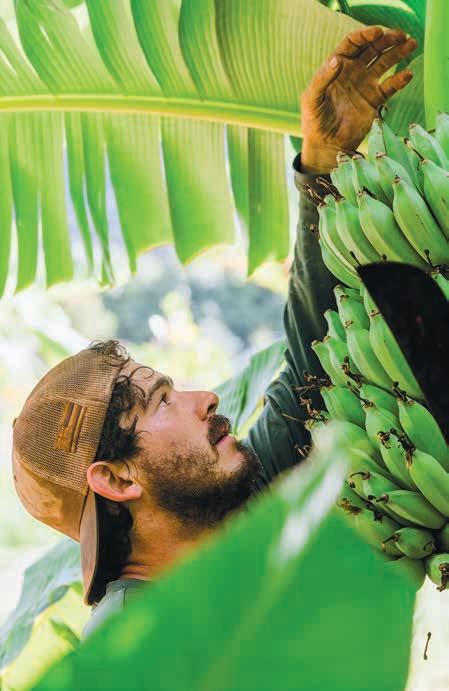
185 _ NORTH SHORE EXPLORE


Hawaiian bananas for cultural education at the annual Banana Festival in Waimea Valley where novice gardeners get underway with their first plants. Sachter-Smith has grown bananas since he was 14 years old in Colorado. After studying tropical plant and soil science at the University of Hawaiʻi, he earned his masters studying banana bunchy top virus in Washington. He now travels the world as an expert in his field.
There are about 150 varieties of bananas on the farm, including 12 Hawaiian varieties. One of Sachter-Smith’s biggest goals is to see the iholena variety gain in popularity. Iholena, a cooking banana whose Hawaiian name means “yellow-orange core,” gets its salmon hue from high levels of carotenoids. He is working with popular farms such as, MAʻO Organic Farms, Kualoa Ranch and Hawaiʻi ʻUlu Cooperative to introduce iholena to their markets so that more locals get to enjoy this island delicacy. “They check all the
boxes,” Sachter-Smith said. “They’re culturally relevant, a staple food crop, really nutritious, canoe crop, who doesn’t want that?”
mauka
North Shore Eco-Tours
At 9:00 a.m., sun already radiating above, we strap on helmets, sunglasses, and seatbelts and conduct a radio check. Once the safety precautions are pau, we crank up our 4x4 ATVs and the adventure begins. “Our focus has never been about thrills,” asserted Keola Ryan, co-founder of North Shore Eco-Tours, hinting at the deeper focus of our impending excursion. “We want to have fun, but we also want it to be an educational experience.” A kumu hula and University of Hawai‘i instructor of Hawaiian Studies, Keola and his wife, Tasha Kawamata Ryan, who holds a Ph.D. in STEM education, began leading mauna tours and
work days in 2012. To keep a light footprint, they keep groups to a max of 10 people and only lead them up twice a week. As an educational and cultural entity they present the ʻāina that these groups trek through a Hawaiian lens. Beginning in ATVs or military trucks the couple leads groups past farmlands of all types. Kahuku Farms has mango, papaya, longan, and calamansi orchards, along with long rows of tuberose and pongamia beans, a possible new source for biofuel. Kō Hana Rum also grows sugarcane here. At the top of the Ko‘olau Mountain Range, about six miles from town, is the ʻŌpaeʻula Trail, named after an endemic red shrimp no longer found here, and is one of the trails created to access the old water system. The Ryans announce themselves and the group to the Kawailoa forest with an oli. When they feel a gentle breeze on their skin after a moment in silence, they lead the pack ahead. Throughout the hike Keola continues to model how to behave.
187 _ NORTH SHORE EXPLORE


CRUISING IN ATVS OR MILITARY TRUCKS, NORTH SHORE ECO-TOURS HAS AN EXCURSION THAT LEADS GROUPS PAST FARMLANDS OF ALL TYPES.

He snacks on invasive strawberry guava, being mindful to not spit out the seeds and cause new growth. He clears the trail of invasive guinea grass with his machete and points out which plants to weed and which to let be — a tiny sprout of koa only four inches tall, for example. He stops frequently along the path to introduce the group to trees, plants, streams, and summits amidst 15,000 acres of conservation land, all by their Hawaiian place names.
After crossing the ʻŌpaeʻula Stream, the couple stops at a freshwater pool for a light lunch, encouraging everyone to jump into the water to cool off. Relics of Waialua Sugar Company — its old cogs, telephone poles, and water pump — surround the banks. A house, built on Dole property just off Twin Bridge Road, hovers overhead. Base camp, a former Palama Settlement
campground seven miles up the mountain, is where North Shore Eco-Tours stages and hosts workdays throughout the year. They consist mostly of university students, Boy Scouts, high school kids, and hālau hula in the lead up to the Merrie Monarch Festival as a quiet place for dancers to train.
From this grassy knoll scattered with endemic ‘ōhi‘a and naupaka kuahiwi, one can see the Kawailoa ahupuaʻa and watershed. Kawai‘iki and Kawainui valleys merge here to form the Anahulu River system, once abundant with water and now eerily dry.
On the way back down we do a little off-roading in ATVs, where we plow through 10-foot high guinea grass as far as the eye can see. Along the way, drivers and passengers can hear their tour guides through loudspeakers. While the vantage point on the mauna gives visitors a sense
of how abundant Waialua is, this sweeping view also serves as a reflection point. Occupying the spaces in between the last of the ‘iliahi and dwindling koa tree forests are 1,000 acres of Monsanto farmland, military helicopter landings, the tunnels and reservoir system built along the watershed by Waialua Sugar Company to divert water to sugarcane fields, and the ubiquitous Dole properties that seem to roll on for miles along Helemano Ridge. By the end of the tour, guests have had a well-rounded experience, seeing Oʻahu as more than just a place to live, work, and play, but as an island with a layered and complicated history. “They appreciate the place and islands much more afterward,” Ryan said.
189 _ NORTH SHORE EXPLORE


Come be here. Unforgettable happenings and unparalleled hospitality, on the world’s most iconic beaches. OUTRIGGER.com 21.2793° N, 157.8292° W







































 Voyager 47
Club Lounge at Outrigger Reef Waikiki Beach Resort
Kani Ka Pila Grille
Coral Reef Penthouse
Monkey Pod
A‘o Cultural Center
Voyager 47
Club Lounge at Outrigger Reef Waikiki Beach Resort
Kani Ka Pila Grille
Coral Reef Penthouse
Monkey Pod
A‘o Cultural Center
backbone of paradise
the first time i heard oli, i went home in goosebumps unsure of what was happening. the first time i met my best friends, and saw my family out on the frontlines next to me, a shiver ran through my body, trickled down my backbone reminding me of who I represent sending electricity as if awakening in me those i came from, that of which i come from that of which i stood for.
all the hawaiian history that i am a living manifestation of.
watch as my people stand in kāpu aloha hear as my people oli & uwē, feel.
they tell our ‘āina to fit in this mold. tell her she is not pretty enough, not worthy of our love, tell her day, after day to be something else. oppress her and turn her into something she never meant to be.
aloha ‘āina with intention, is knowing you carry a lineage a succession of stories in your backbone
standing on the frontlines no questions asked, for the places that we call home is assimilation in what is needed to survive adapting to your surroundings and being above to thrive it is inspiring others in that thirst for more knowledge. aloha ‘āina is a love you can touch, see, taste, smell, hear, a home you can miss
let your roots run deep ‘āina plentiful that when given the space to breathe, she sings oceans surrounding us on all sides she is refreshing and all we ever need in healing it's on the calm and serene days that i feel music playing while i hear children laughing at school fact!
we learn science everyday outside in the environment we learn agriculture and how to mitigate flooding we knew sustainability before anyone told us what it was
we are the remnants of all our ancestors we are the next wave of consciousness and enlightenment.
it's no surprise when some days the tears of our ‘āina sweep homes away it's no surprise when her foundation suddenly gives out when the grounds shake and the earth moves because we have become spiders crawling down her back and fleas eating at all that's left of her in a sea of corruption our elders teach our children how to swim and our children teach us how to paddle alongside them
but i want our future generations to not be afraid of drowning in the tide of the future
to be left with knowledge and imagery from all their ancestors a feeling of responsibility that comes with a sense of pride and freedom of where they came from knowing that we did everything to make sure they can float and won't have to tread.
this is my testimony are we ready to get swimming?
KALEHUA FUNG WAS THE 2022 HAWAII YOUTH POET LAUREATE. HER NATIVE HAWAIIAN CULTURE AND SCHOOLING IS VERY IMPORTANT AND SHE BELIEVES IS THE FOUNDATION OF ALL HER SUCCESSES.
VINCENT BERCASIO POEM BY IMAGE BY
KALEHUA FUNG
FLUX _ A HUI HOU 192 _ FLUXHAWAII.COM
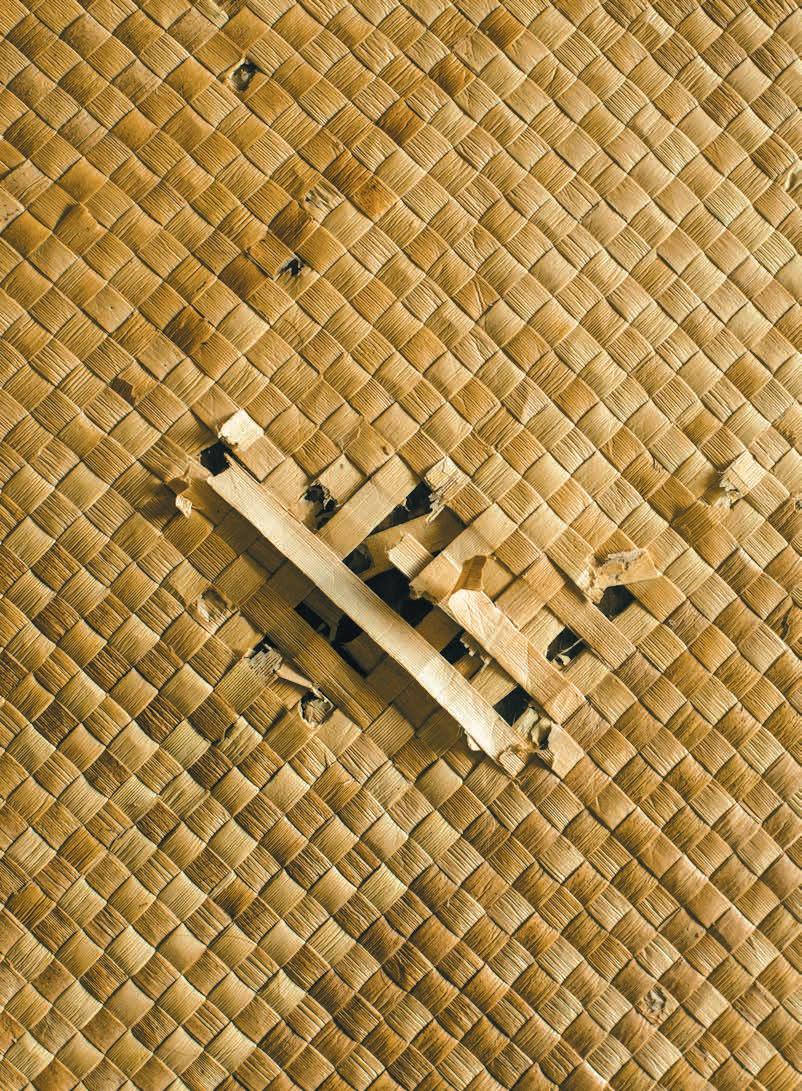




















































 “ Where did we get this beautiful word, this magical word, this word that imparts life
“ Where did we get this beautiful word, this magical word, this word that imparts life












































 TEXT BY IMAGES BY _ TIMOTHY A. SCHULER _ JOHN HOOK
CHRIS ROHRER
TEXT BY IMAGES BY _ TIMOTHY A. SCHULER _ JOHN HOOK
CHRIS ROHRER



























 KODIE SOLIS-KALANI 27-YEAR-OLD NONPROFIT COORDINATOR
KODIE SOLIS-KALANI 27-YEAR-OLD NONPROFIT COORDINATOR















































 Daniel Palakiko believes the future of water in Lahaina is about more than who controls the streams. It’s a referendum on what future Hawai‘i will choose: preservation or profit. Above and overleaf, images by Daeja Fallas.
Daniel Palakiko believes the future of water in Lahaina is about more than who controls the streams. It’s a referendum on what future Hawai‘i will choose: preservation or profit. Above and overleaf, images by Daeja Fallas.












 Gumbo Chair & Stool, 2022
Fiberglass, linen, and upholstery
Gumbo Chair & Stool, 2022
Fiberglass, linen, and upholstery

 IMAGES BY _ MARK KUSHIMI
IMAGES BY _ MARK KUSHIMI




















 here, there aren’t going to be people that fight for it. ” — Skye Kolealani
here, there aren’t going to be people that fight for it. ” — Skye Kolealani


































